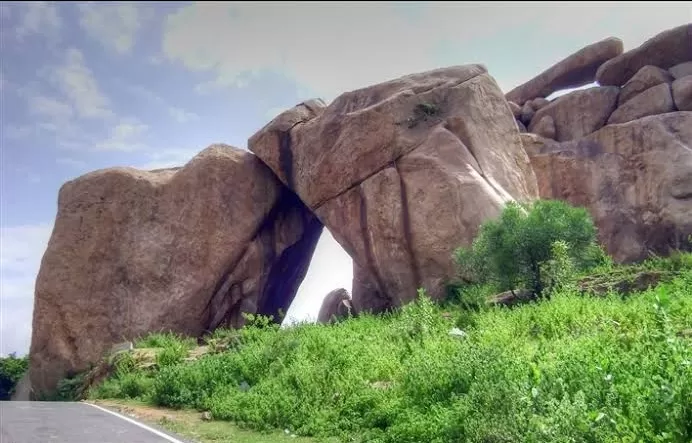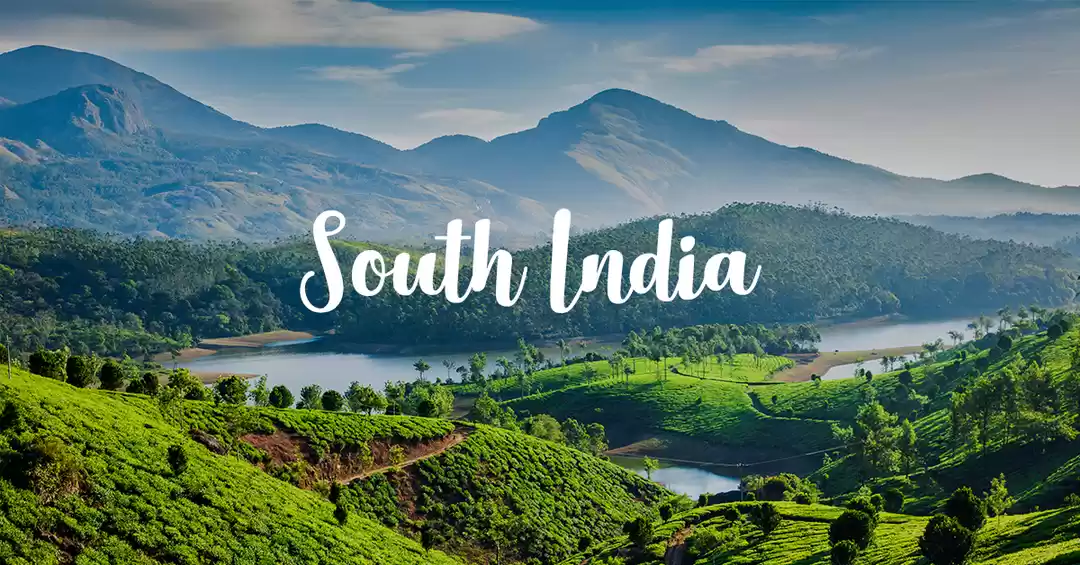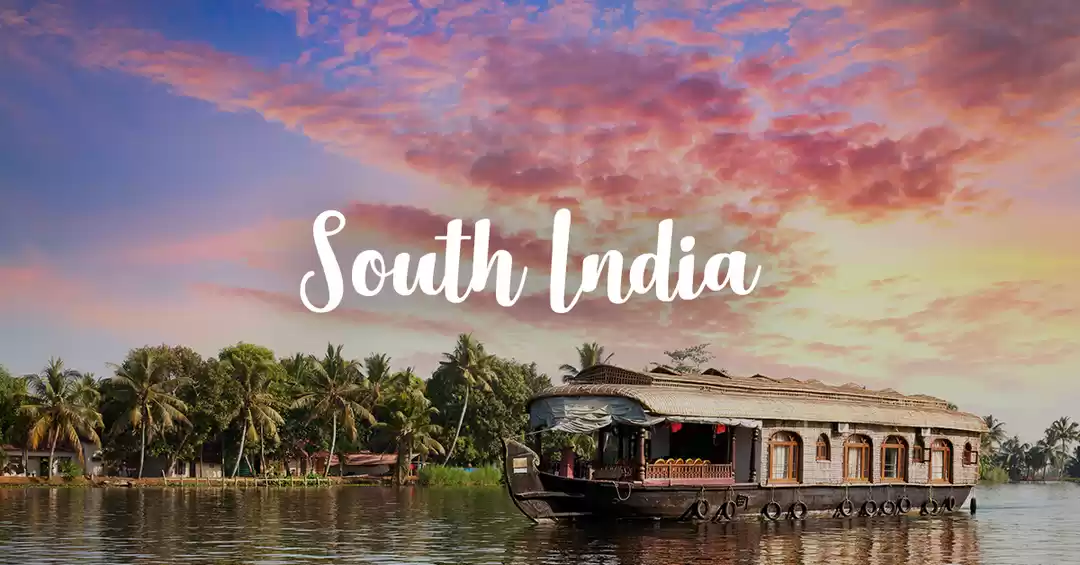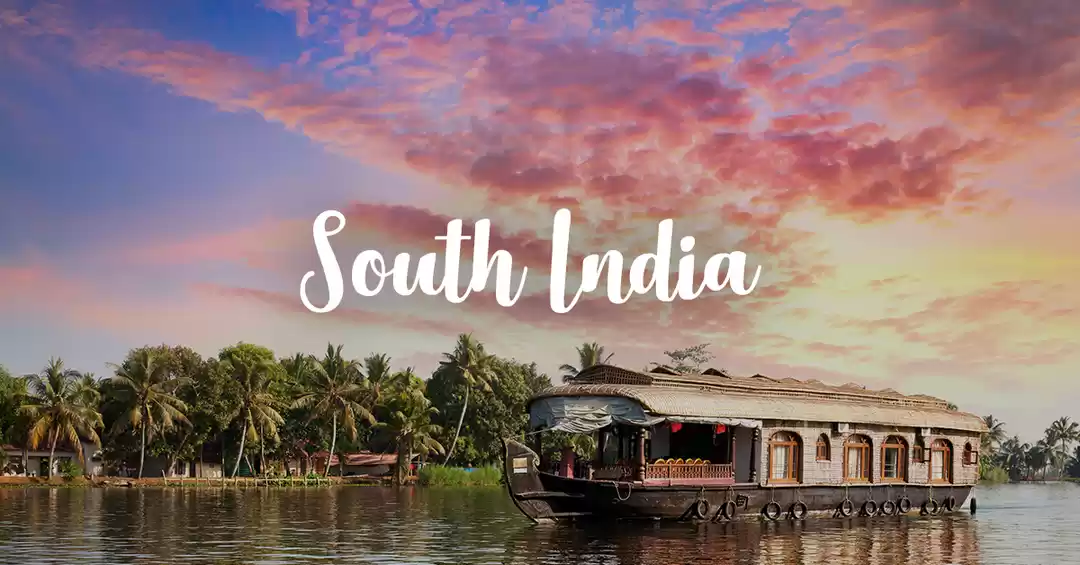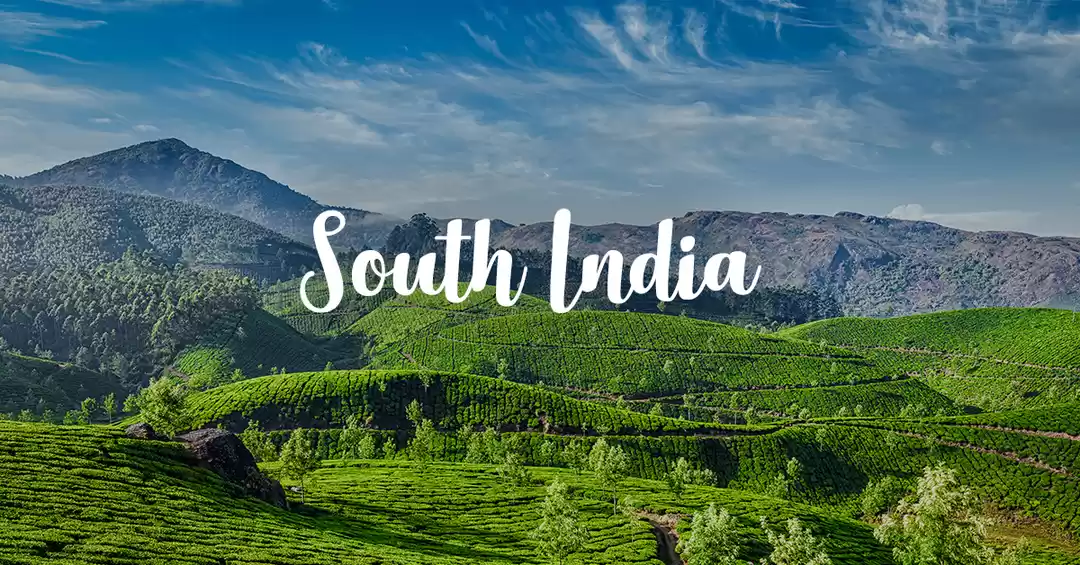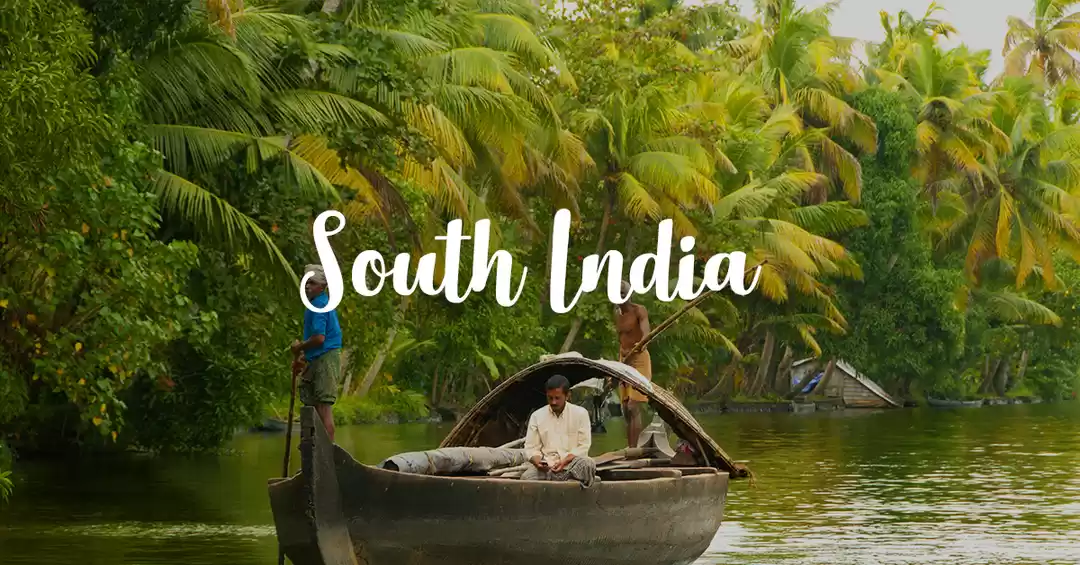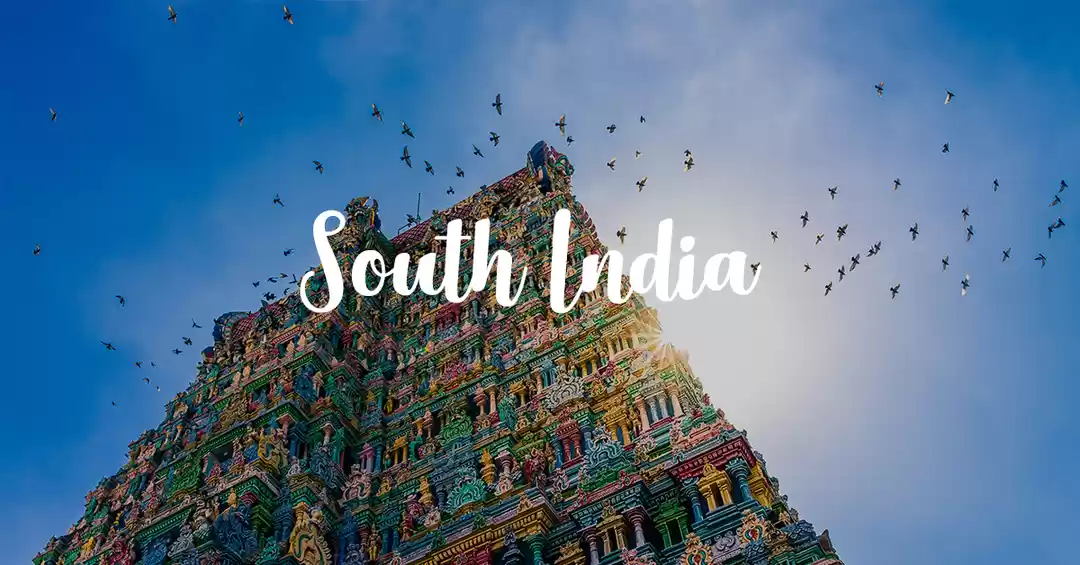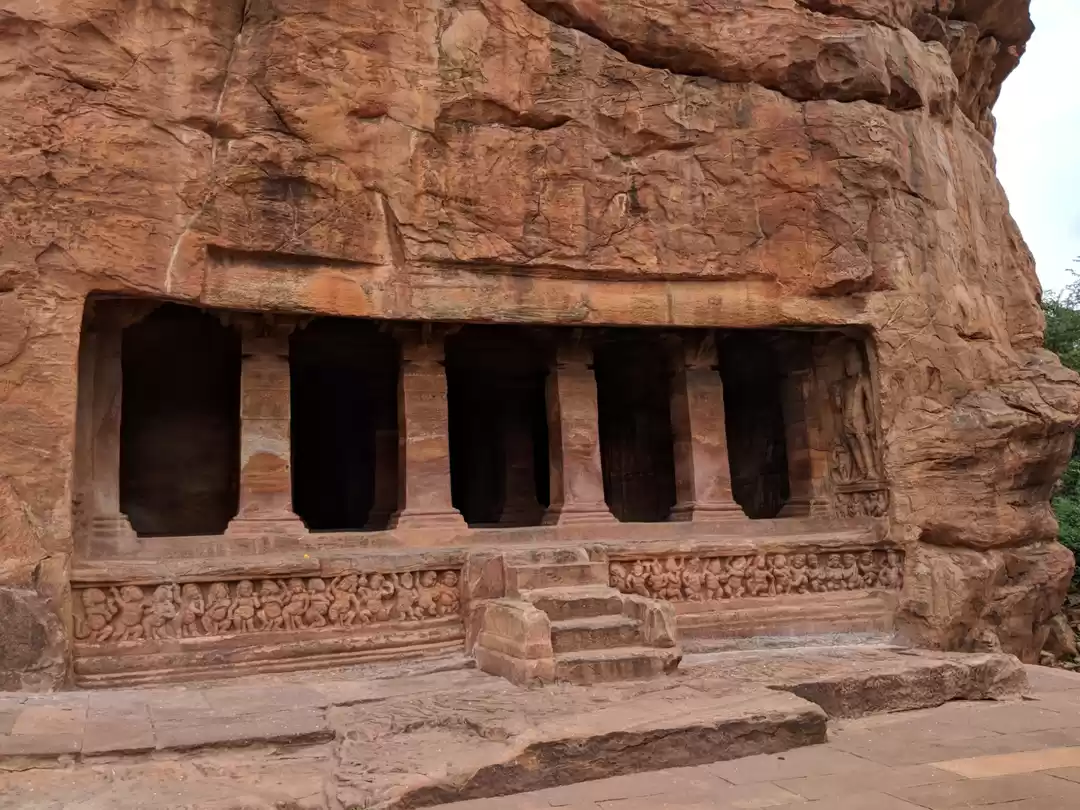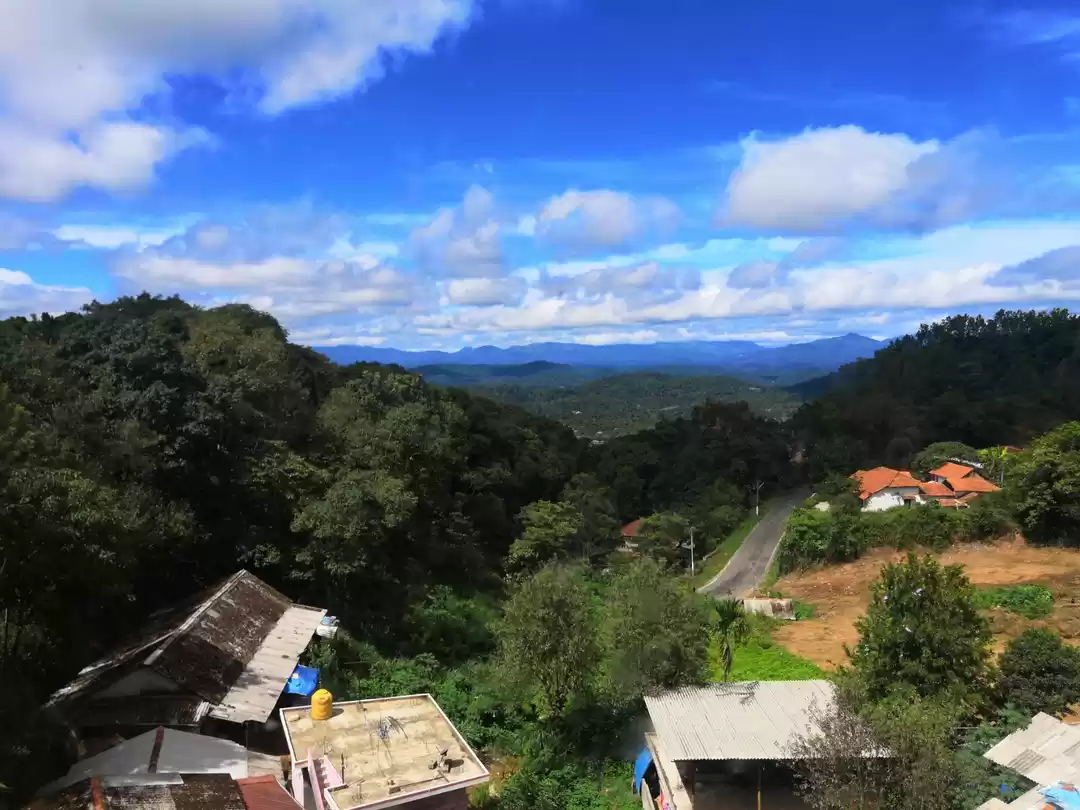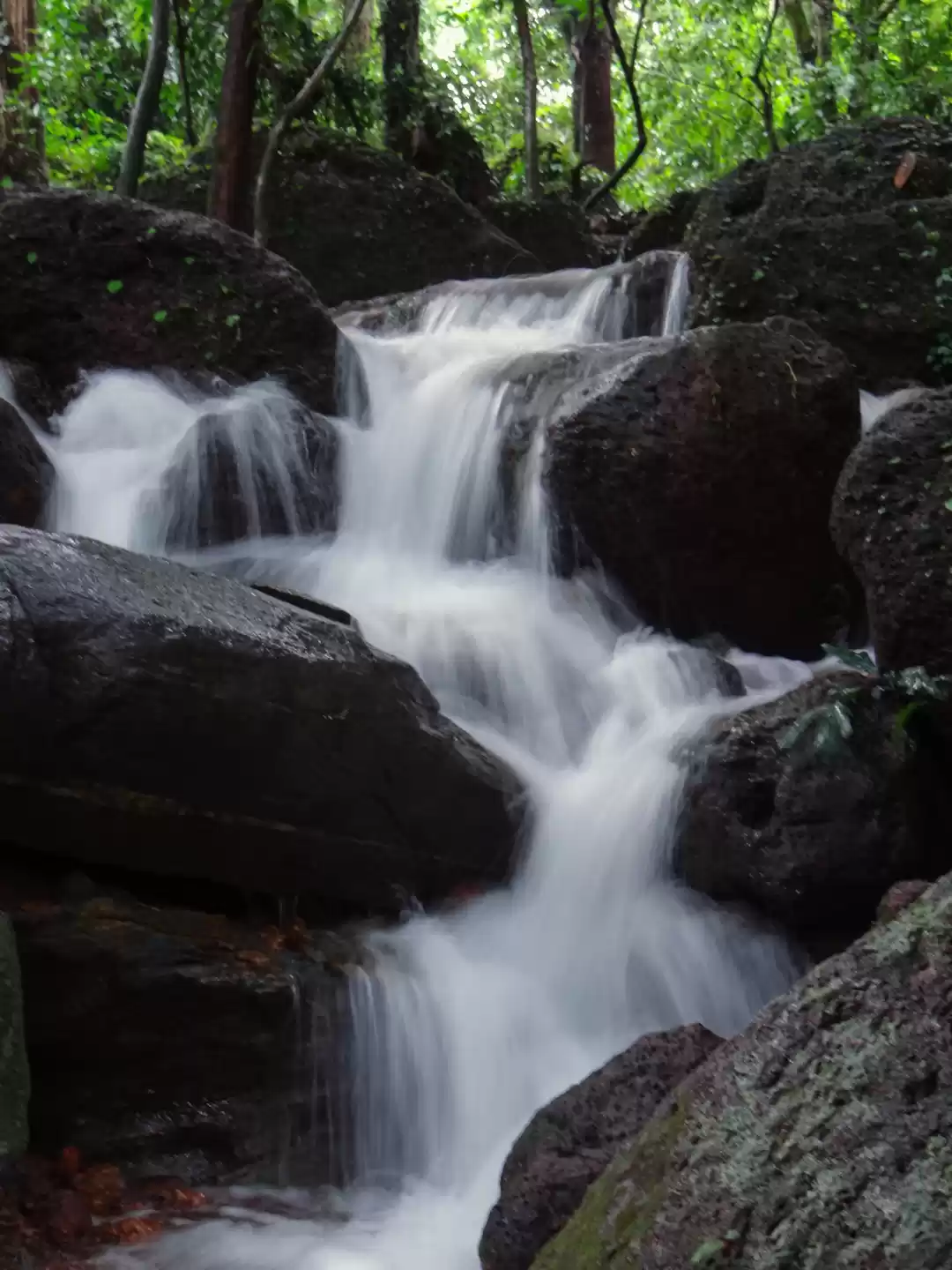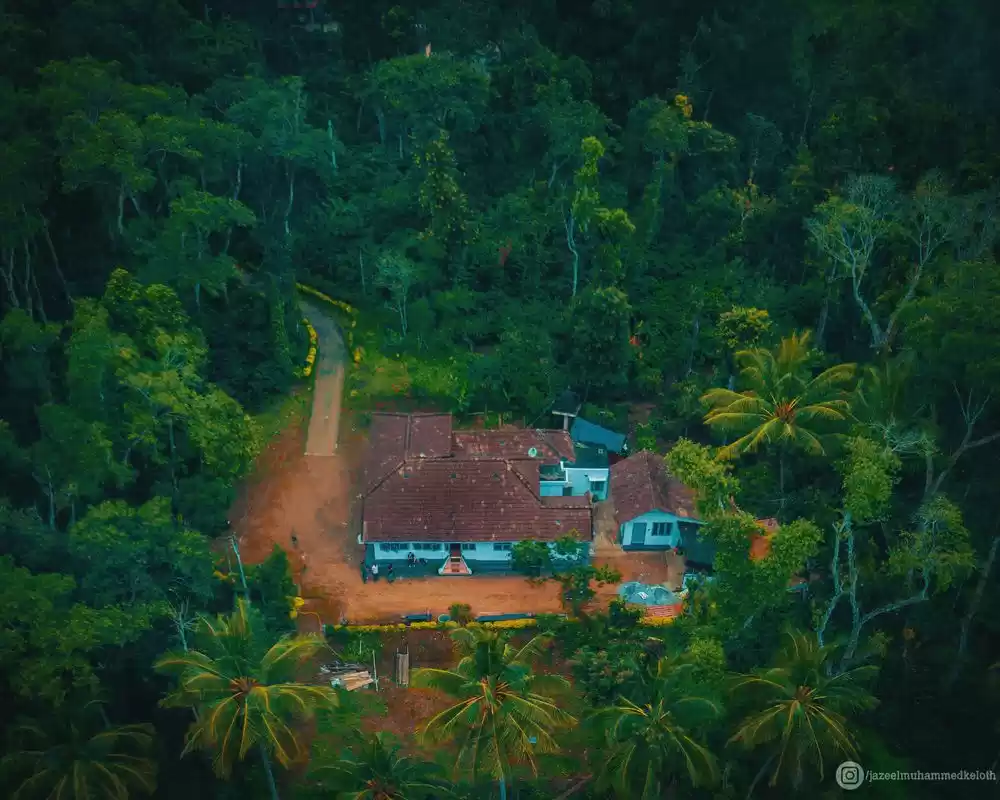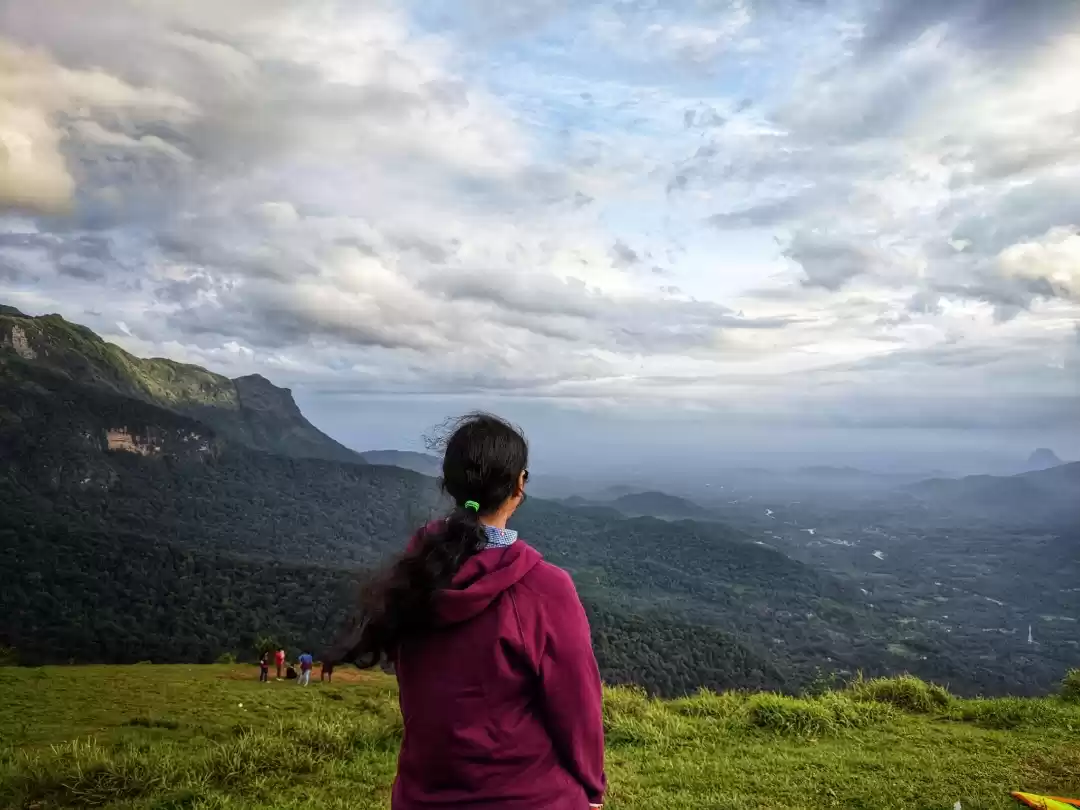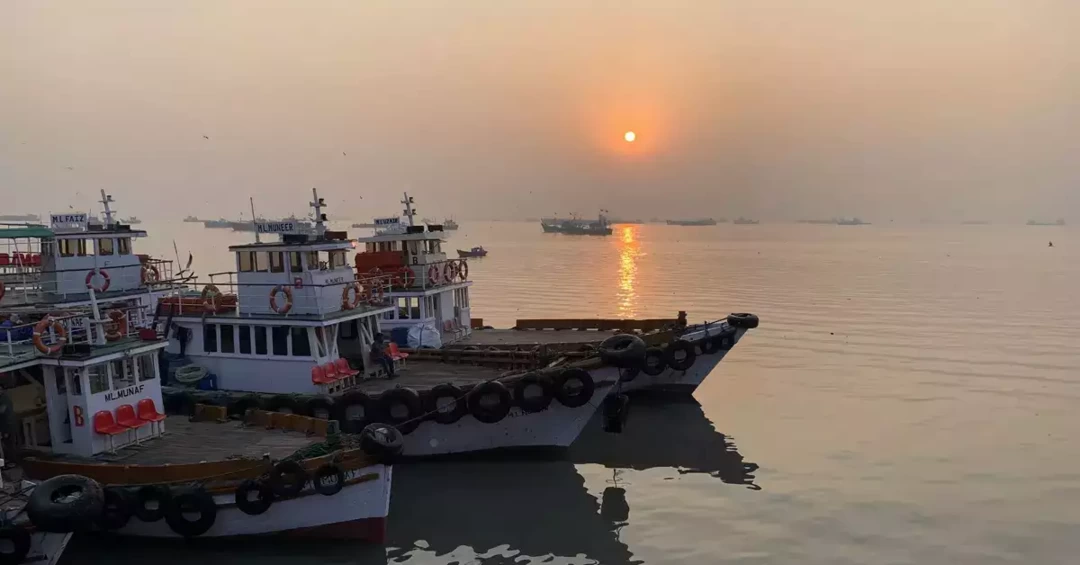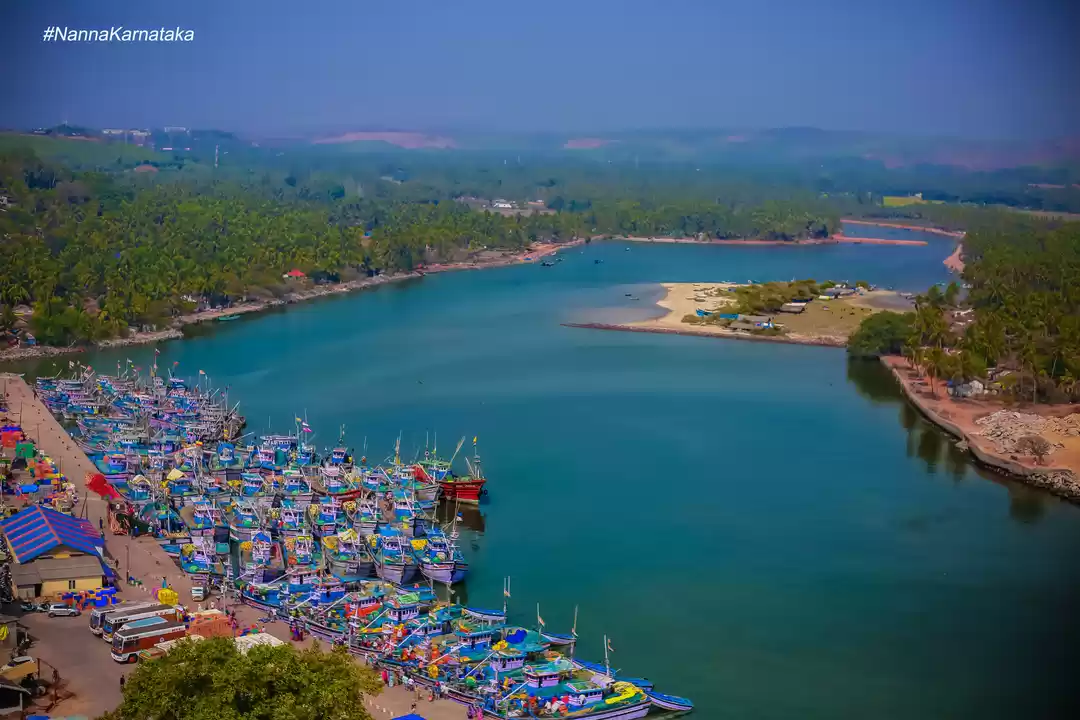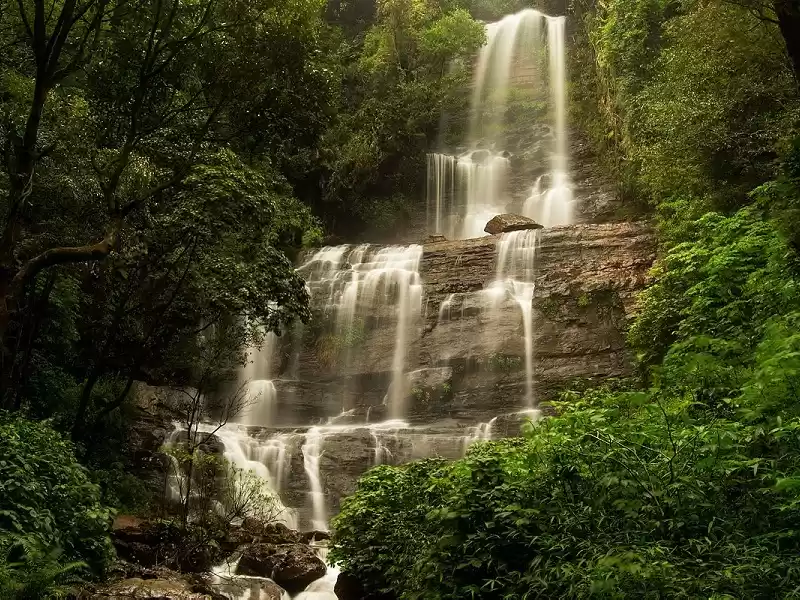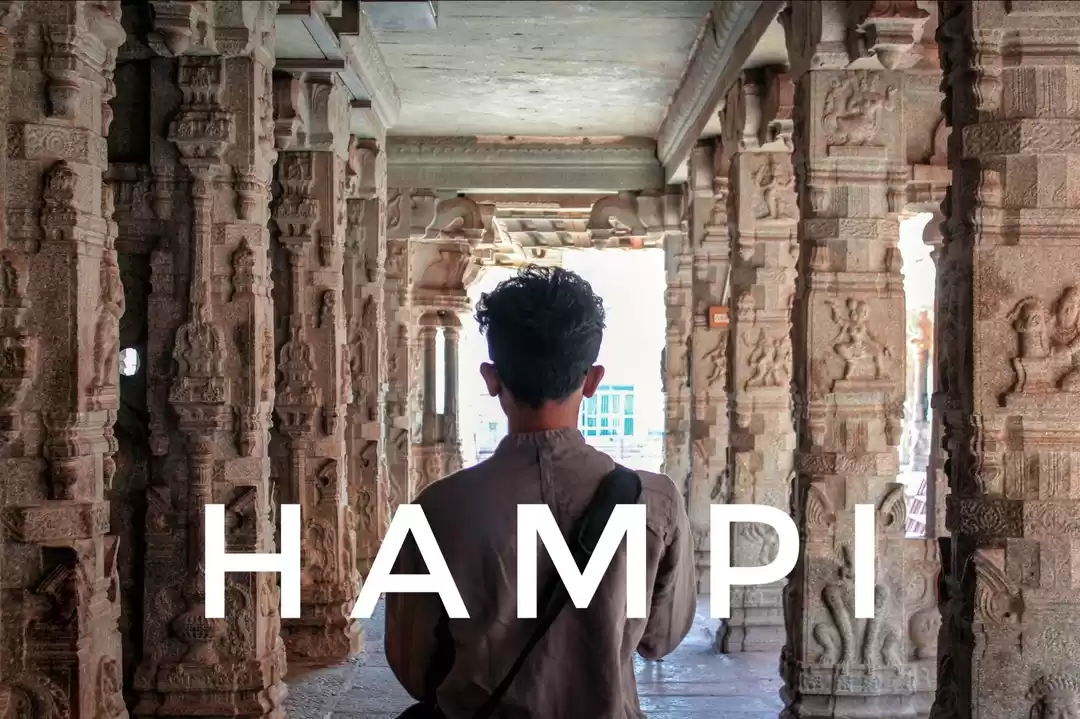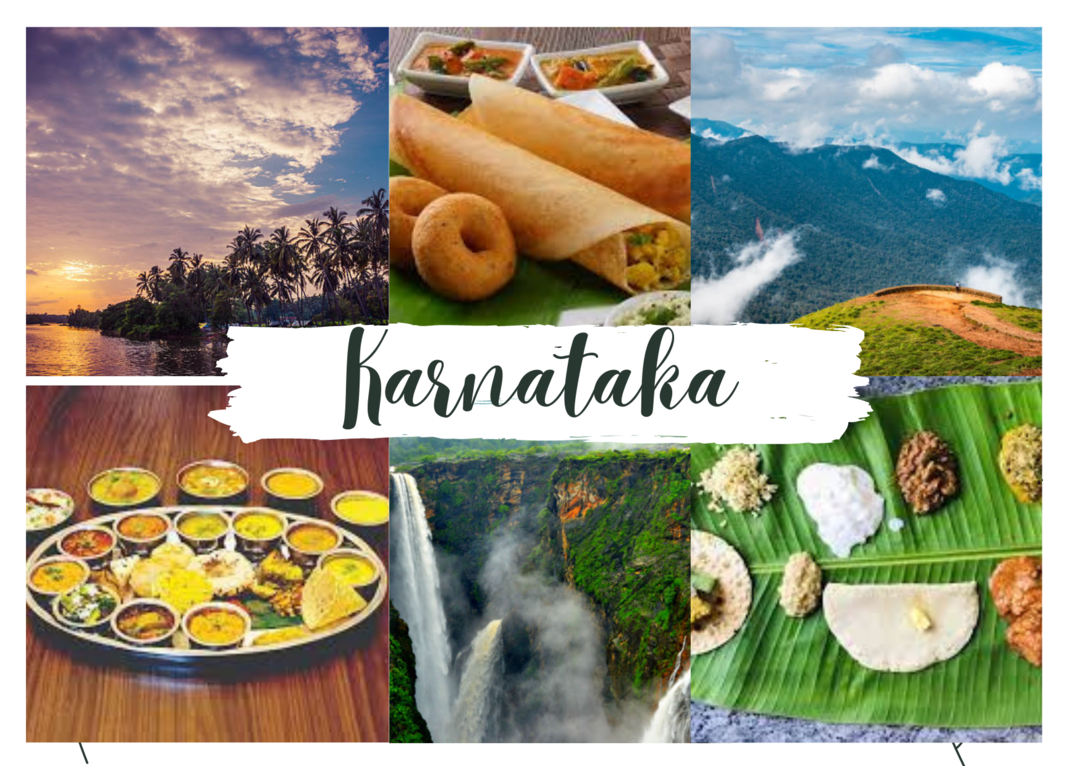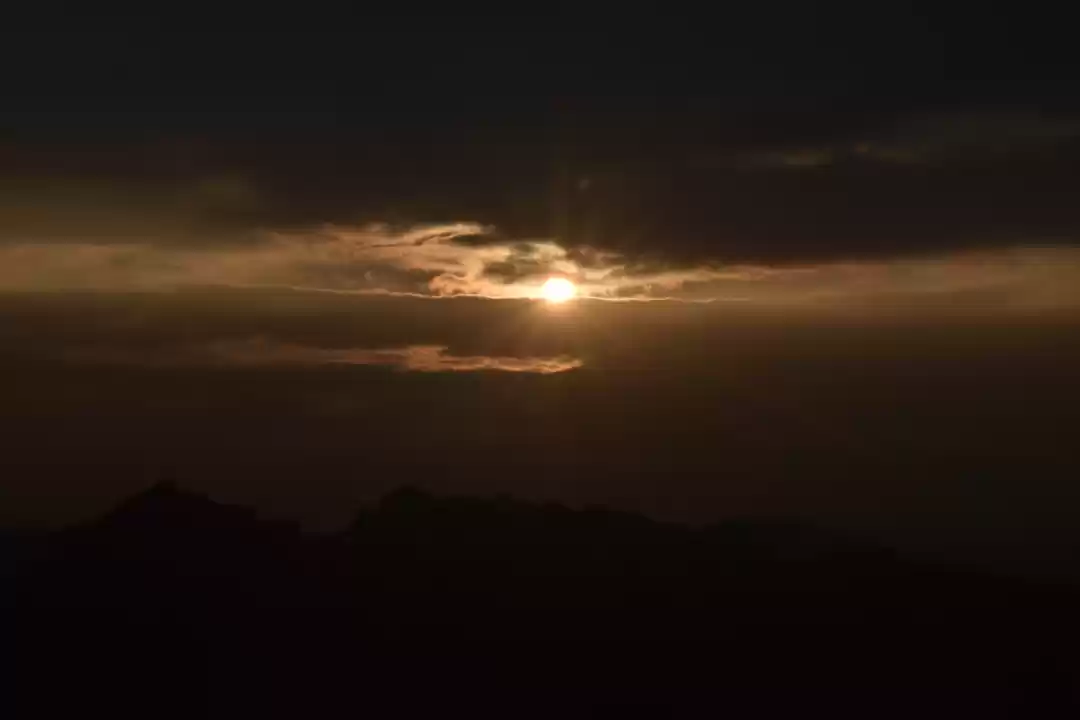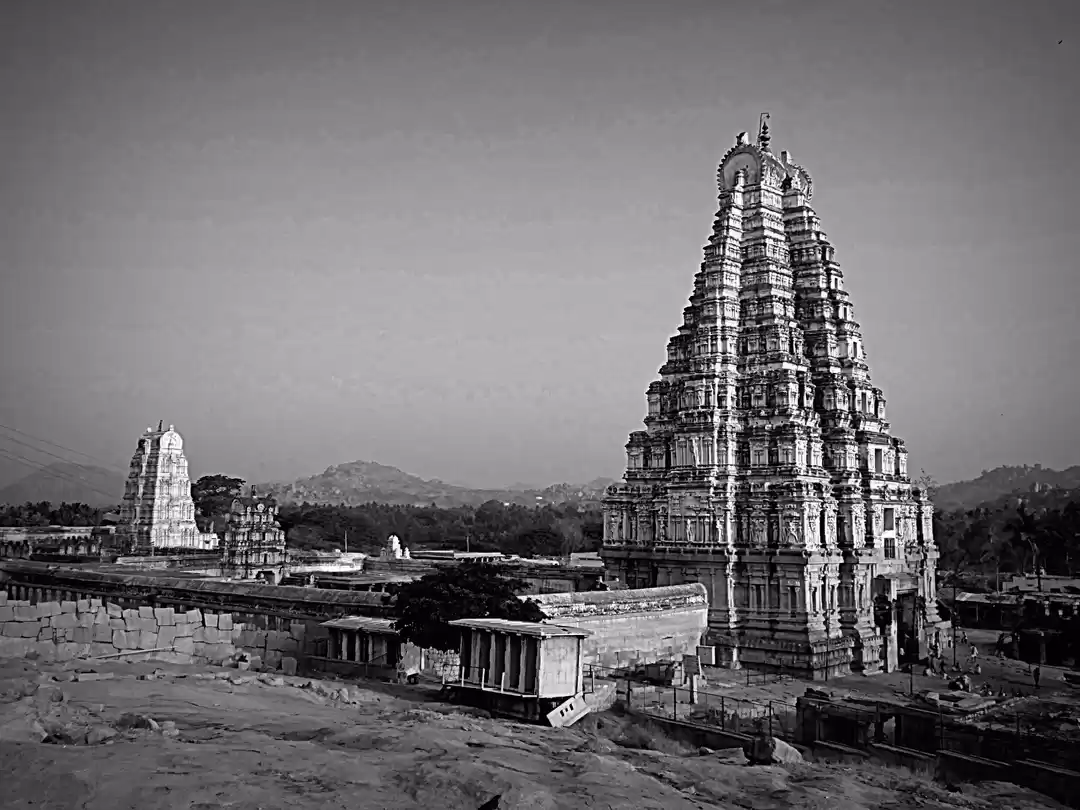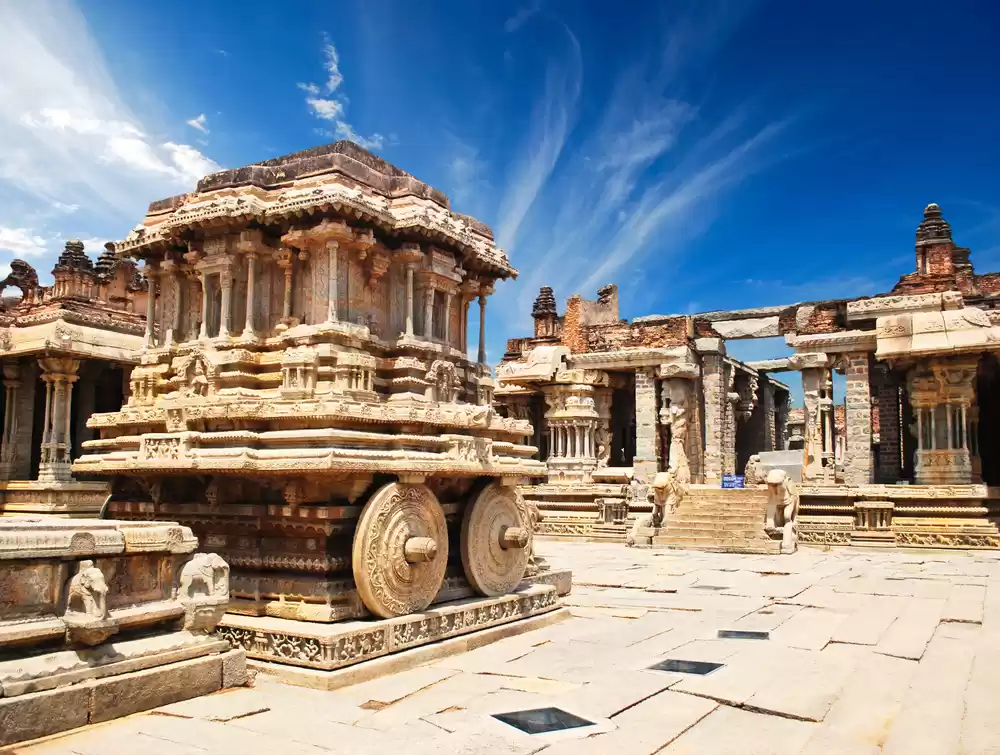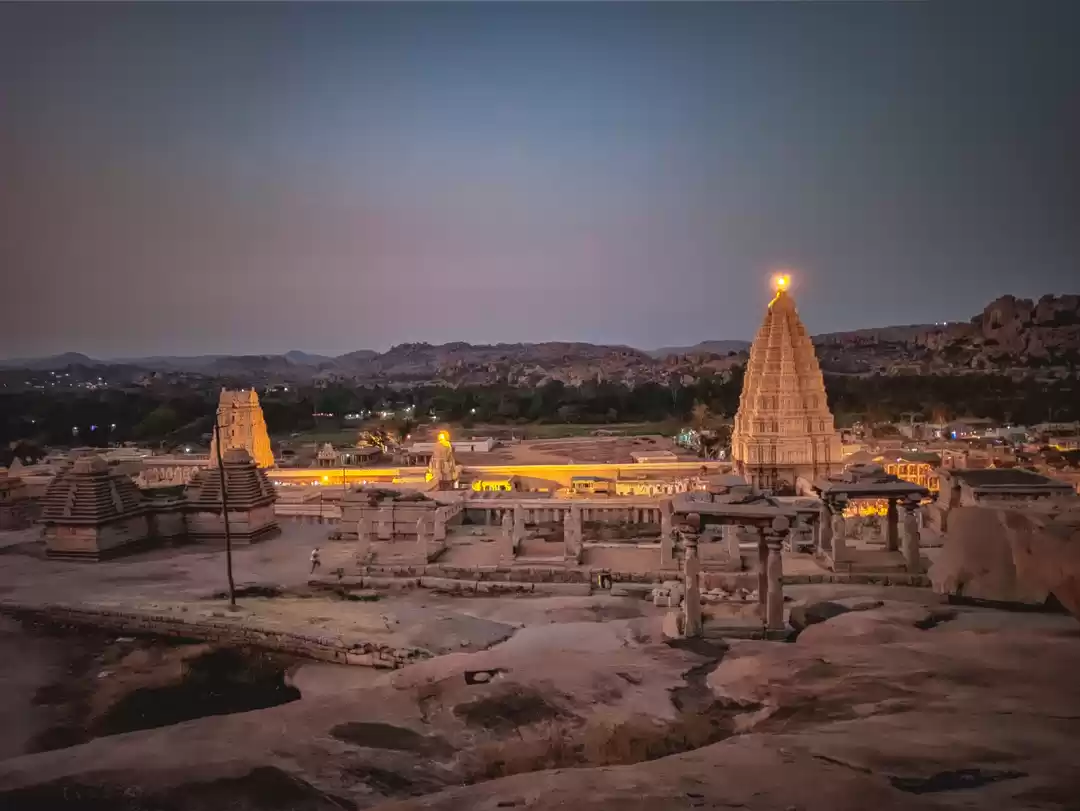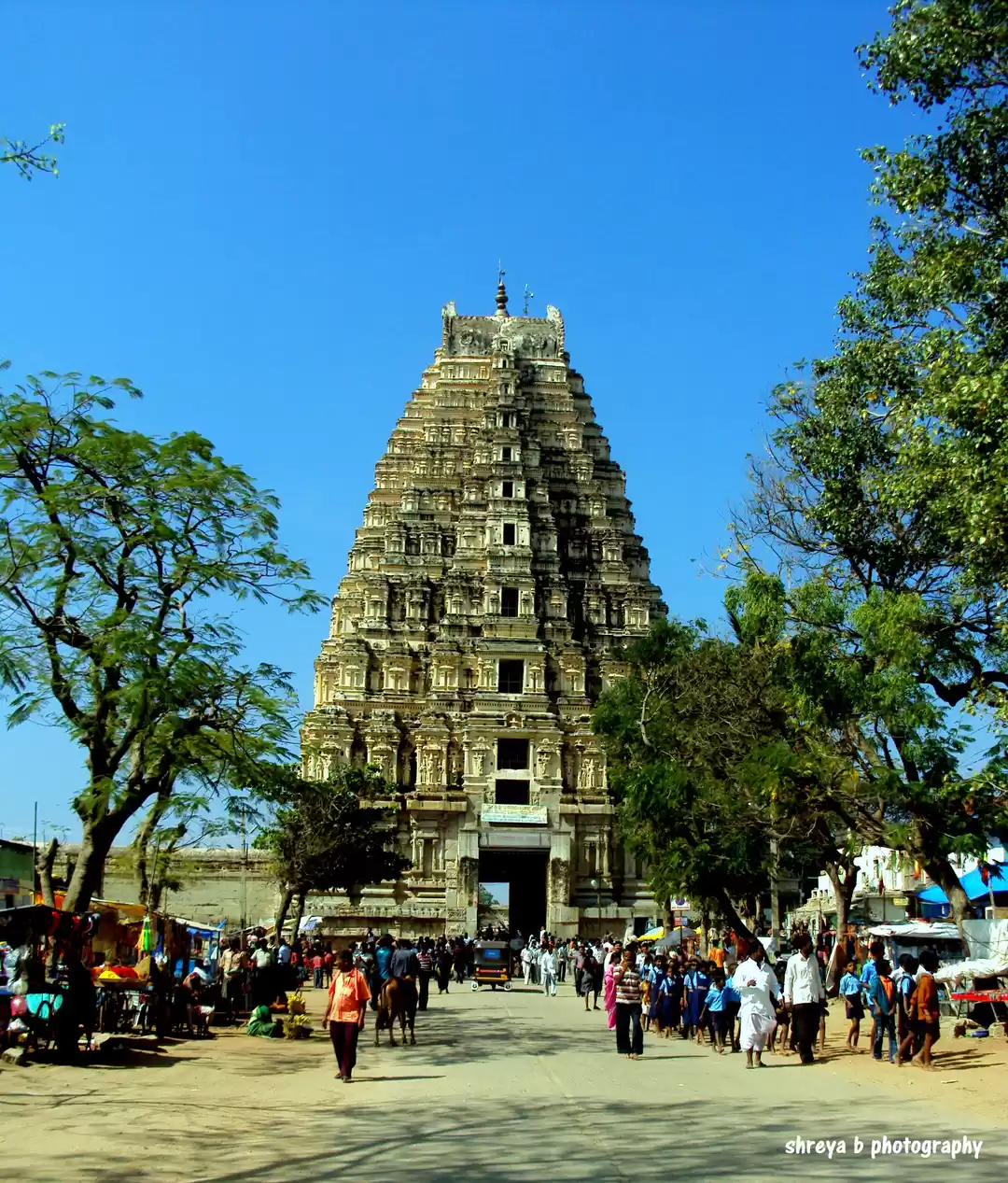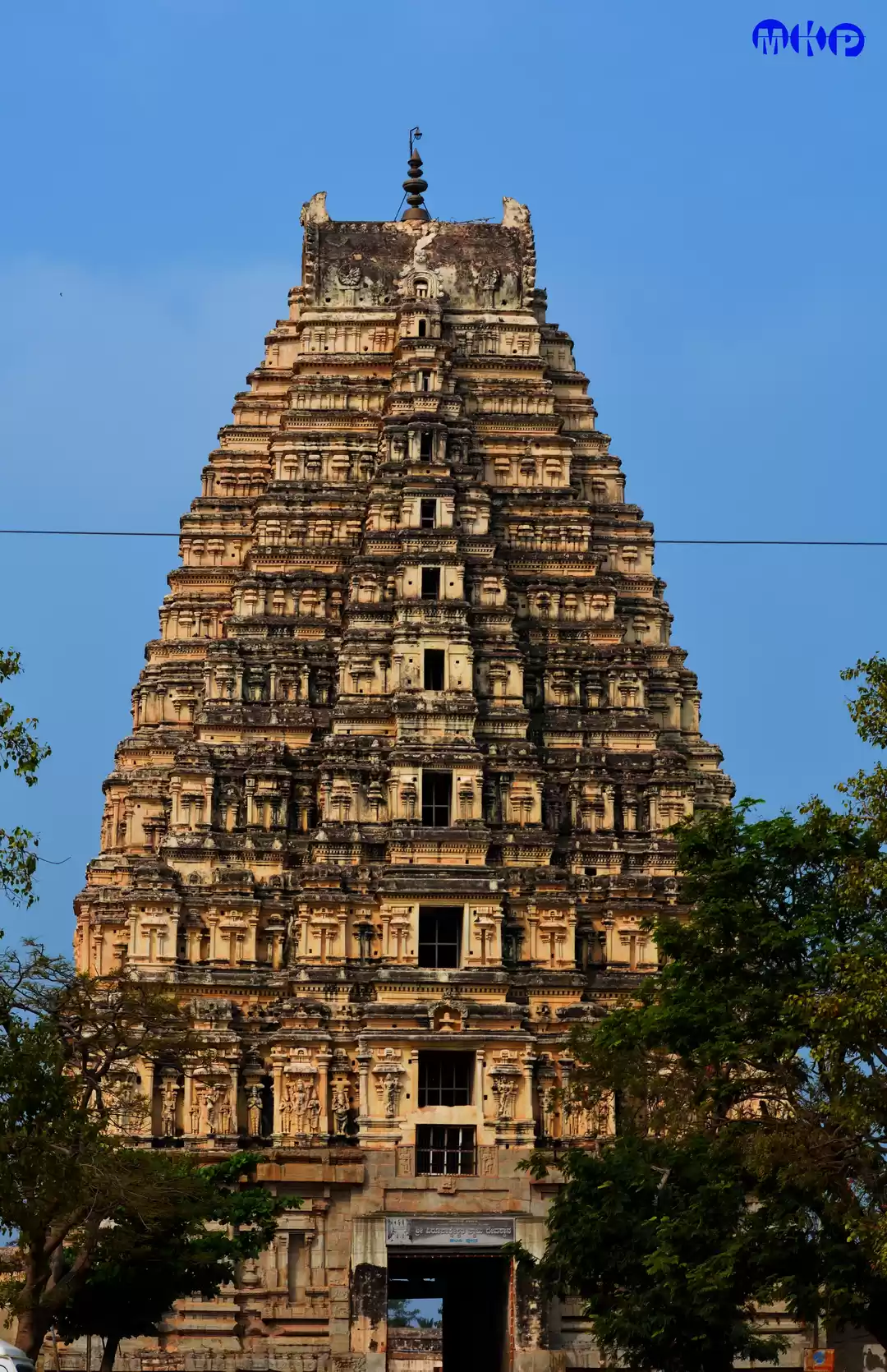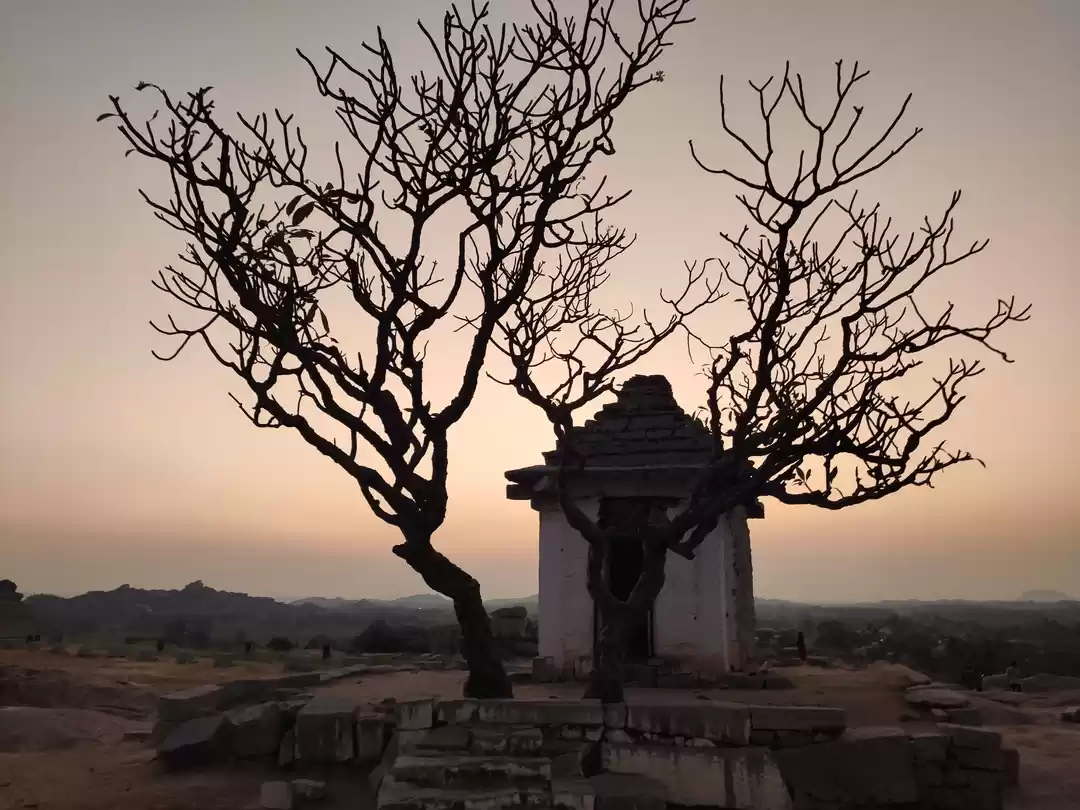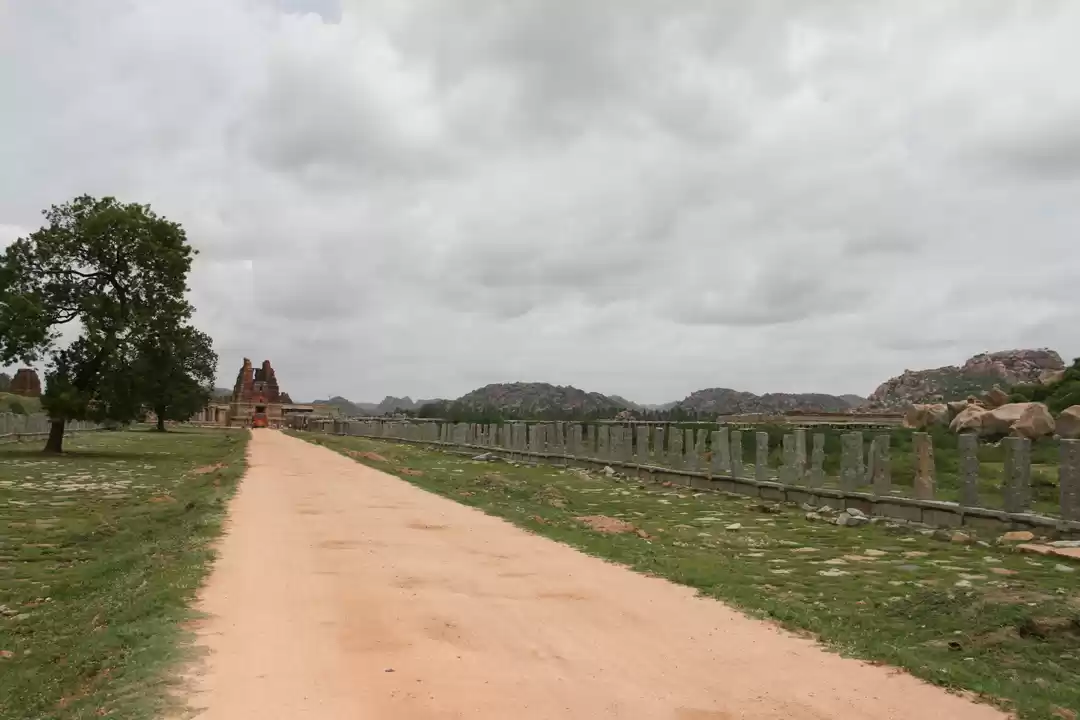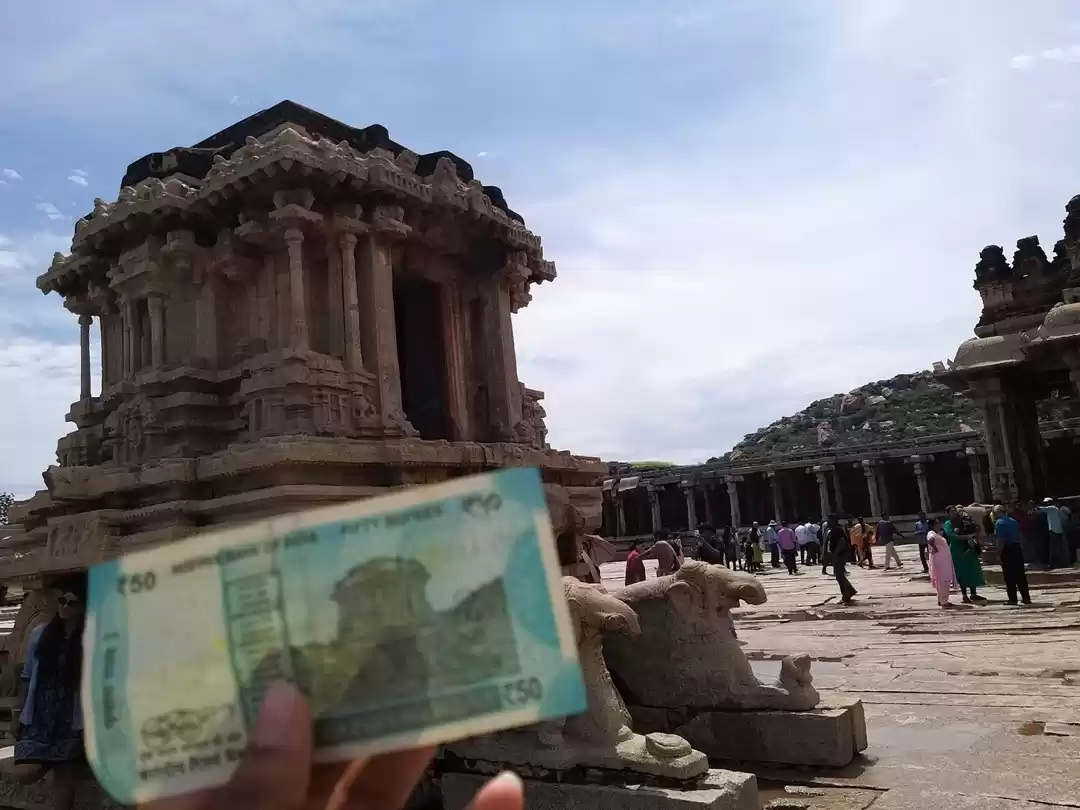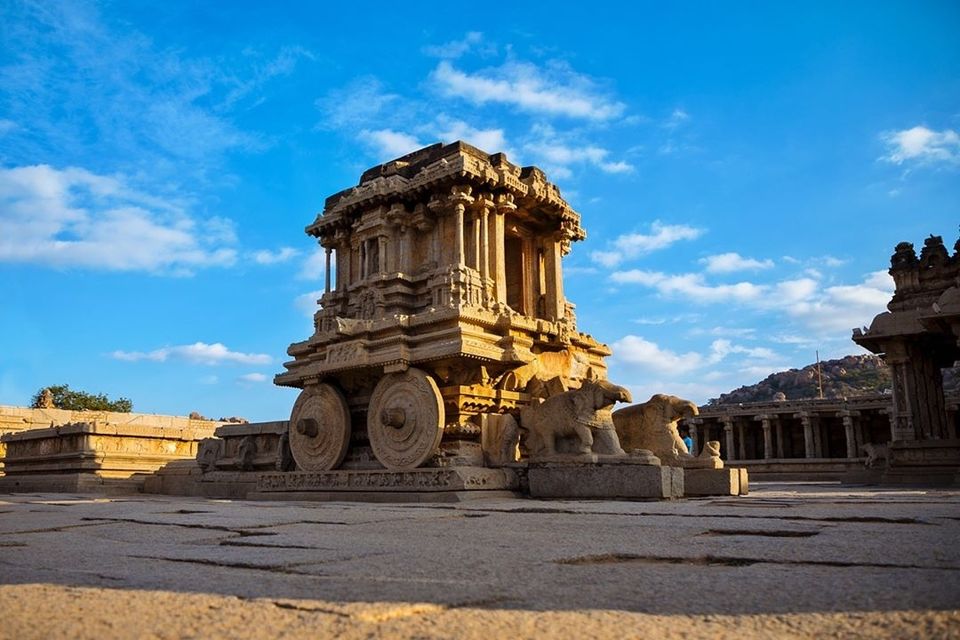
Legend says that, Hampi is a place that shoud be explored by people who are physically fit and the words are absolutely true. "Hampi" - the capital city of great Vijayanagara empire which stands proudly today amidst ruins is a must visit to everyone. This beautiful city of ruins screams aloud the bruises it has gone through by a lot of other emperors from several dynasties.
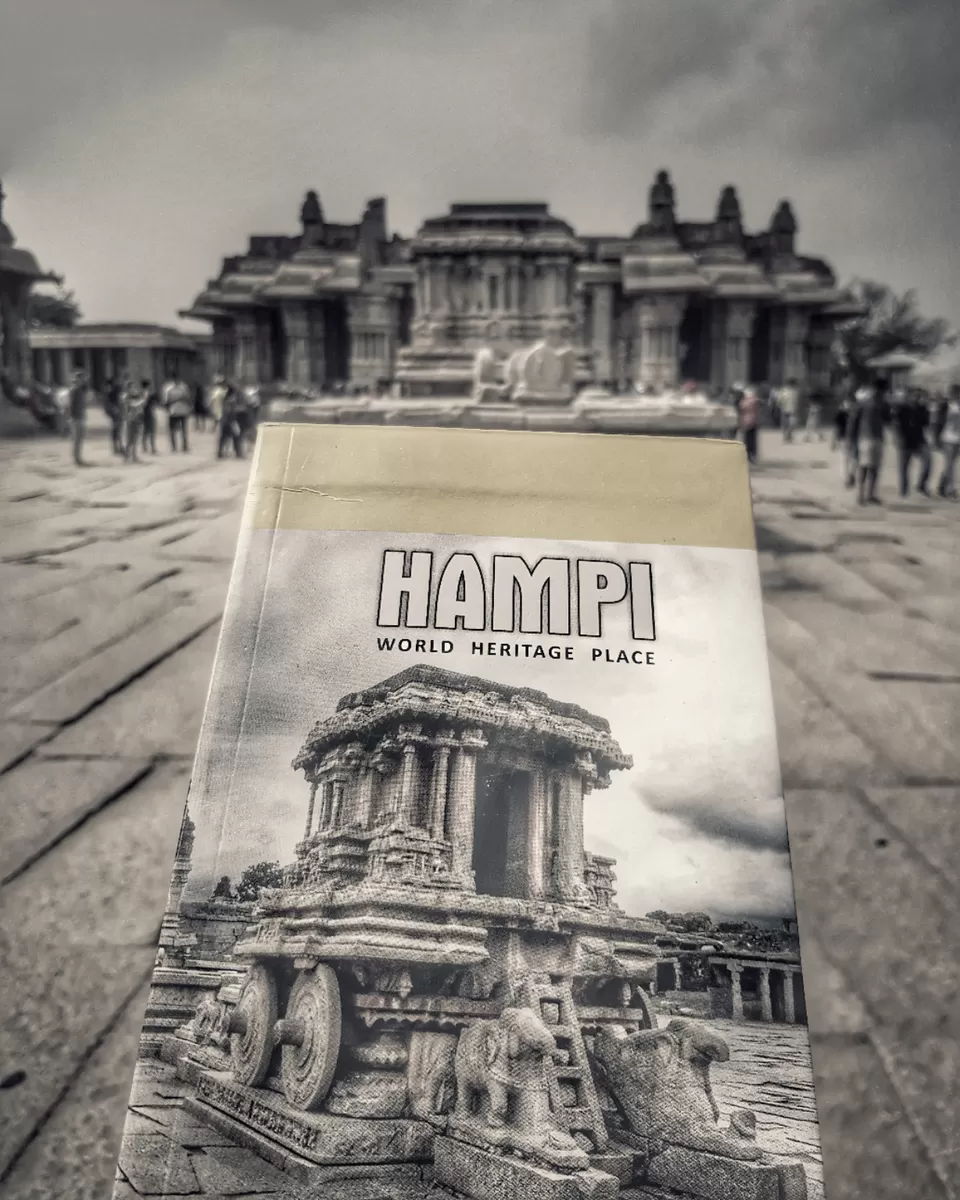
Here is the description of how I started my journey.
Firstly all u need to do is sort the places which u have to visit within 2 days so that u can cover all places.If ur looking for budget travel then I would recommend u to use the train service coz it will cost u only 130 INR from Bangalore.
I started my journey on 25th night from Bangalore.My train was at 22:20hrs and don't forget to reach on time coz southern railways are always on time,also u may get confused which train to board coz there are 2 trains which leave within a 10 min time frame to hampi.But u need to board Hampi express train (16592) If u want to reach early.so my journey was around 9hrs and I reached hospet train station at 8am on 26th.There are also other modes of transportation if u want to reach hampi from Bangalore.
For more info on how to reach hampi just Google it for detailed version or just read the following info
How to reach Hampi ?
Your gateway town to Hampi is Hospet , bustling town located very close to the Hampi village. This is the major travel hub from where you can get the travel connections as well as a variety of hotel options.
There are good road and rail connections from Hospet to a number of major towns and cities around this part of India.
Traveling to Hampi by Train:
Some of the long distance express trains pass via Hospet. There are a few passenger trains that connects Hospet with nearby cities.
If you are coming from far places to Hampi ( like Chennai, Mumbai , Bangalore, Delhi , Kolkata etc ), look for a direct ( or even split journey ) train connection from your place to Hospet Jn ( HPT) . Hampi is a short bus ride from Hospet town.
Direct trains include Hampi Express (Hubli - Hospet - Bangalore - Mysore) ; Amaravathi Express (Goa - Hubli - Hospet- Vijayawada - Vizag - Bhubaneswar - Kharagpur - Howrah) ; Haripriya Express (Kolhapur - Belgaum- Hubli - Hospet - Guntakal - Tirupati ) ; Garib Nawaz Express (Bangalore - Guntakal - Hospet - Hubli - Belgaum - Pune - Kalyan - Surat - Baroda - Ahmedabad - Ajmer ) ; Hyderabad - Kolhapur Express (Kolhapur - Belgaum - Hubli - Hospet - Guntakal - Raichur - Hyderabad ). This is only a brief list, there are a few more trains via Hospet.
Another strategy is to get connections from Hubli or Guntakal . Hubli Jn (UBL) and Guntakal Jn (GTL) are two major rail junctions west and east of Hospet ( Hampi) respectively. May long distance trains pass via these two stations. You can look for a connection from Hubli or Guntakal to Hospet.
Traveling to Hampi by Bus:
The state run KSRTC operates (www.ksrtc.in ) a number of schedules from Hospet to various towns and cities in Karnataka.
There are even a few interstate services connecting the cities of neighboring states (services to Goa, Andhra Pradesh and Maharashtra ). Though not as comfortable as the train journey for the medium distance travel, you can opt for the bus services.
Apart from the state run KSRTC a number of private operators too run regular long distance bus service to Hospet ( and to Hubli , a major town 3 hours west off Hospet) . Check out with the websites of Kamat (www.rpkamatgroup.com ) , VRL Travels (www.vrllogistics.in ) . Plus check out with your local private bus services if they run any services to Hospet.
Then of course you can drive all the way to Hampi ! Take NH13.
Traveling to Hampi by Flight: Hubli is the nearest airport (about 160km) west of Hampi. Further northwest is Belgaum airport (about 270 km from Hampi). Both has moderate connections with cities around the region.
A more practical option is to fly to Bangalore and take the overnight Hampi Express .
Bangalore is connected with all major cities of India. Also Bangalore has many international connections.
By the way Hampi Express stops at Yelahanka (YNK) station, closer (20km) to the Bangalore airport. (You'll save 1 hour travel to the city stations). If you are doing an onward/return journey to Hampi (Hospet Jn) from/to Bangalore airport, this can come handy.
How to reach Hampi form other cities and states?
You can get direct train connections from many Indian cities to Hospet.
Follow the links to see what's the most suitable option for you to travel to Hampi.
Goa, Bangalore, Hyderabad , Mumbai , Kerala , Chennai , Delhi
Please note that the train details given here could be changed with time. For the current & accurate updates checkup with the Indian Railways website https://www.indianrail.gov.in
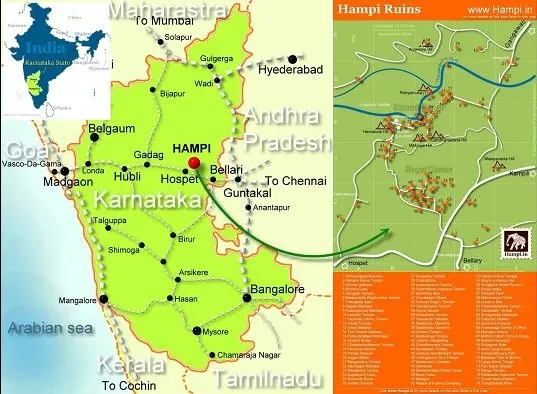
HOW TO START UR DAY If u want to complete ur 2 day hampi iternary with 1800 INR(25$) Then I would recommend u to not take autorickshaw or any other vechile and if u want to cut down ur budget to 1500INR,Then I would suggest u to travel around hampi by walk but u may not be able to complete visiting all the places. So here's how I started my day 1.From hospet railway station I just came out and saw rickshaw drivers who started to come near me.They told that per head travel cost is 200 INR to hampi.I started to bargain for the price and it was unsuccessful.Then I found that there were bus service at the right side of railway entrance which is around 10mts distance from station and if u pay 5 INR to bus it will take u to bus stop which will take hardly 5 min.From there for every 30 mins u will get bus to hampi which will cost u 16 INR.As board the bus to hampi u can see the surrounding without any monuments but just hold ur breath coz as soon as the bus reaches kamlapura the conductor starts to call the stop kamli...kamli...now u can see many people get down,since this is the village stop most of the people get down but u need to Hold on for few minutes since hampi is still 4km away.Now as soon as bus leaves from kamlapur u will see a signboard which will indicate "welcome to hampi",Now the real excitement begins as u travel through bus u can see many historic places for a short glance.In a while the bus will reach to hampi bazar and it's the last stop.As u get down u might think what next?....
This what I will tell u to do,If u didn't had a breakfast have it next to bus stop it will cost around 40 INR(0.5$) along with tea.From there head directly to entrance of virupaksha temple, just before temple entrance take a right u will find places for stay starting from 350 to 500 INR but one major problem is there is no network for mobiles expect BSNL.There u can rent bicycles for 150INR and u need to give ur any ID proof as security and if u want mopeds u need to book 2 days prior since there are only 10nos.
Now before starting ur journey pls ensure that u have a map and water.From here I will guide you through the places u need to visit first.
1.VIRUPAKSHA TEMPLE
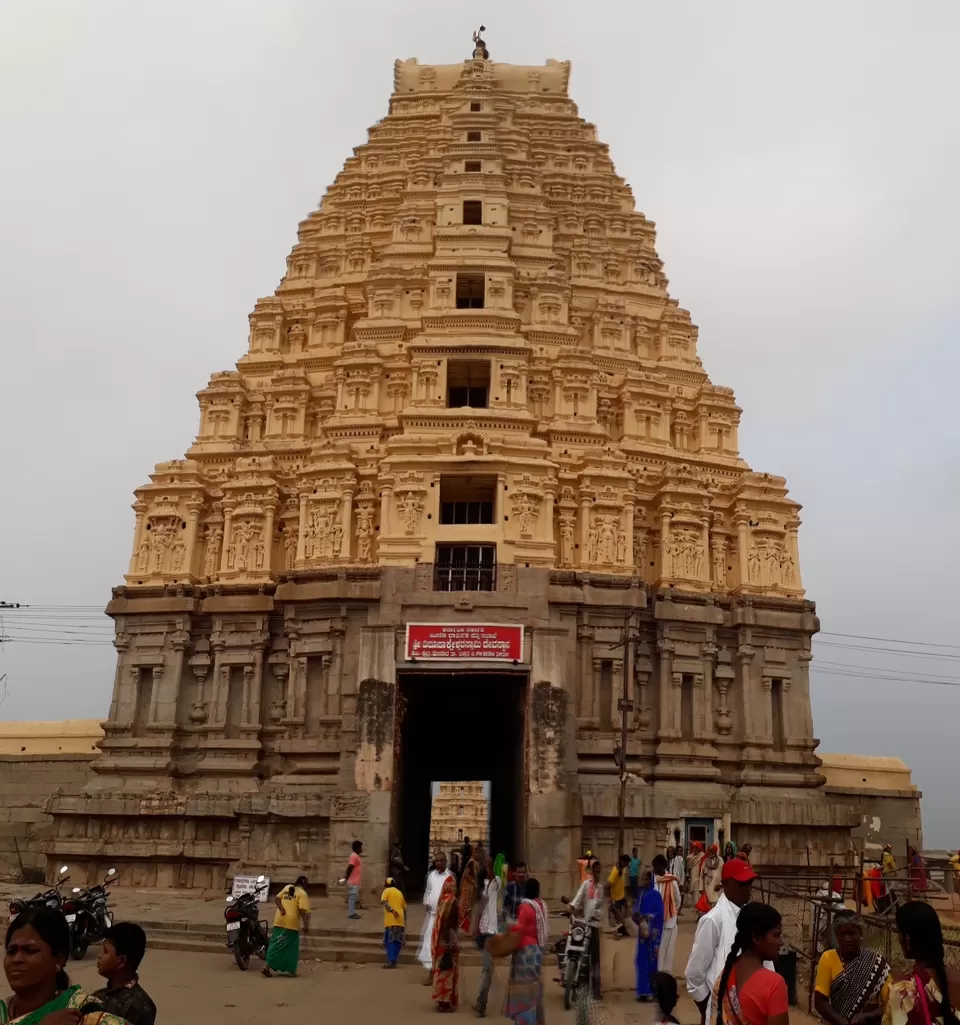
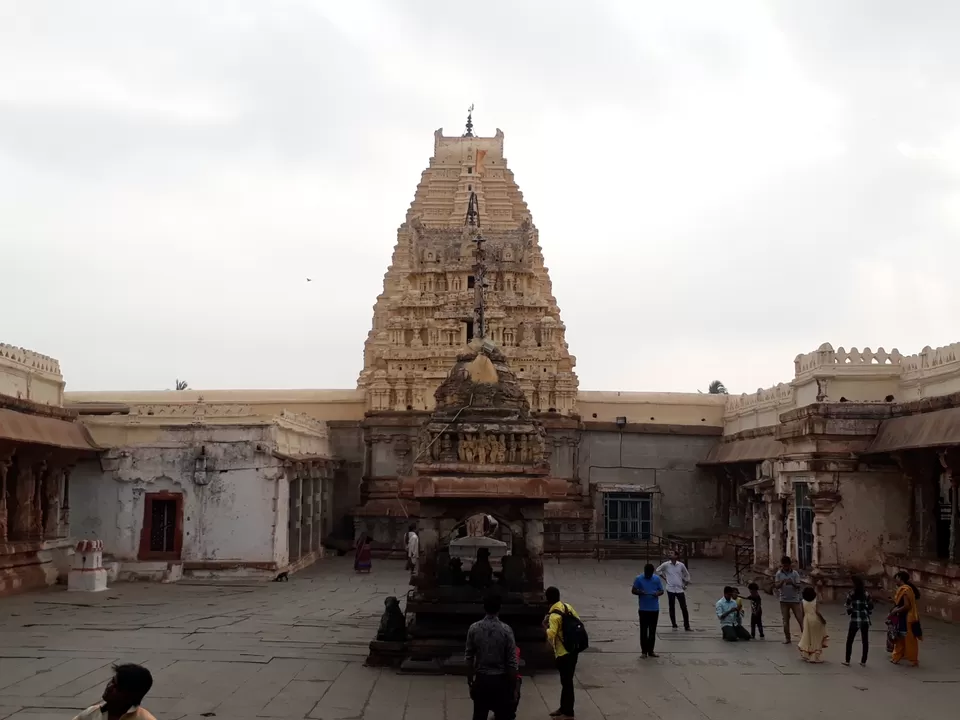
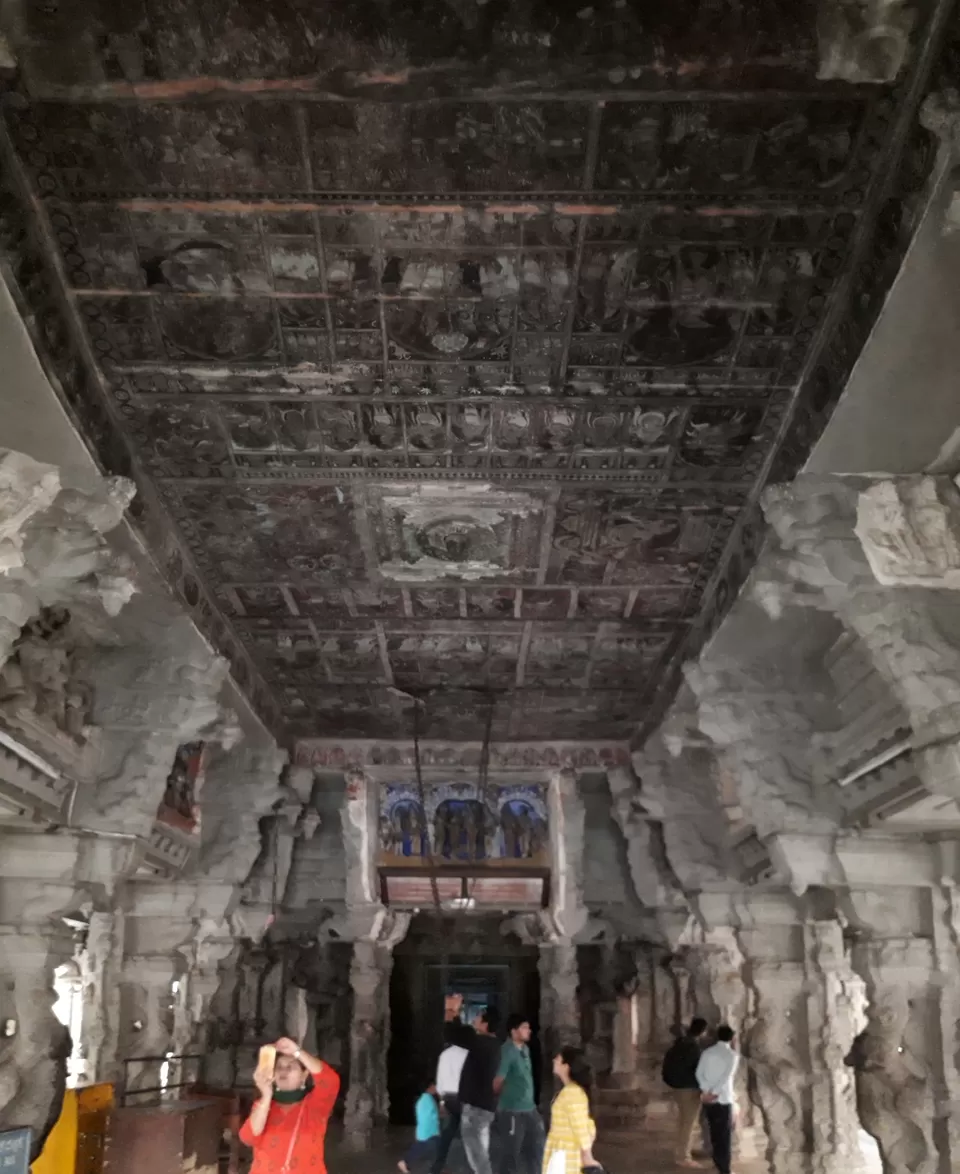
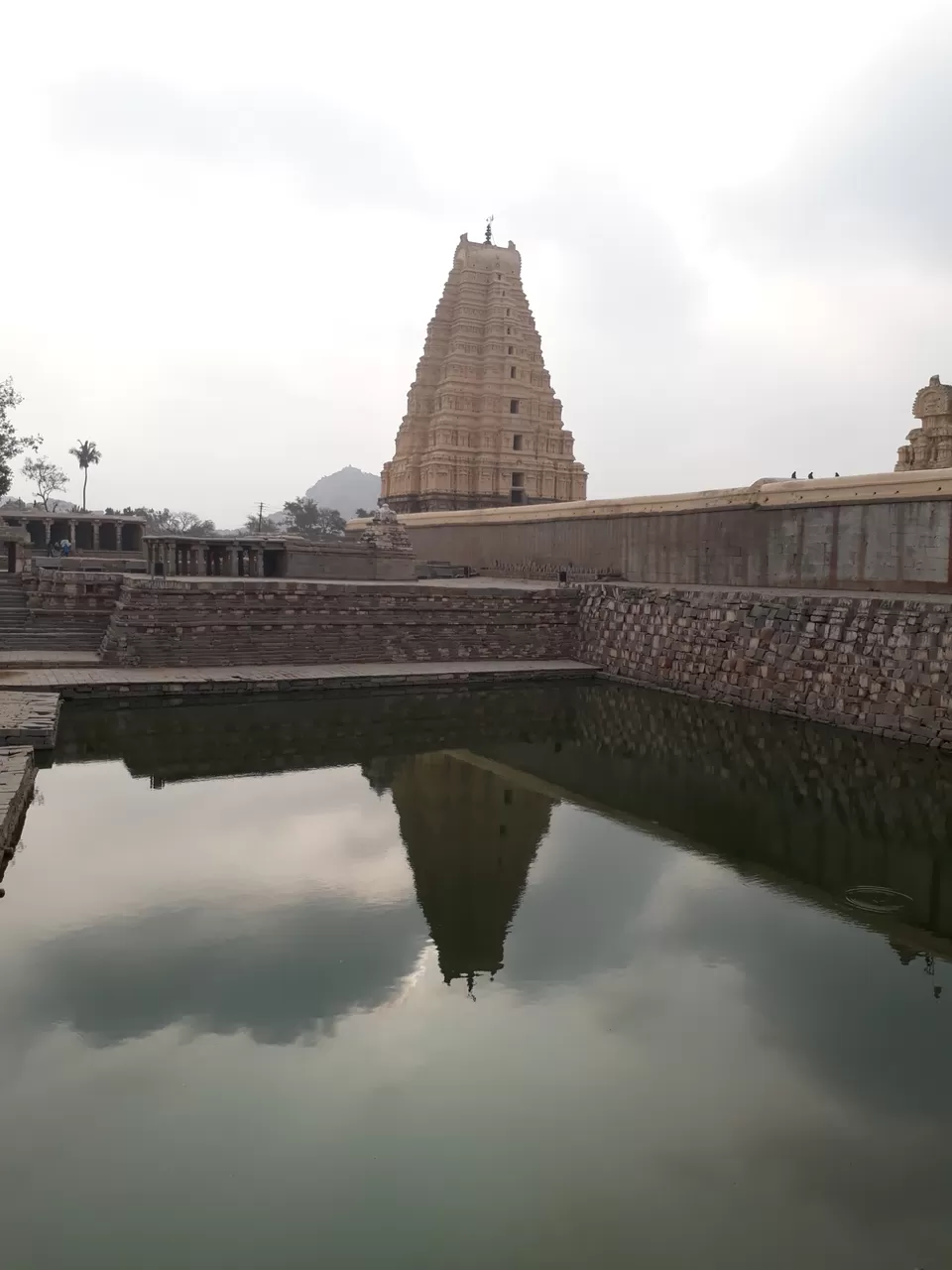
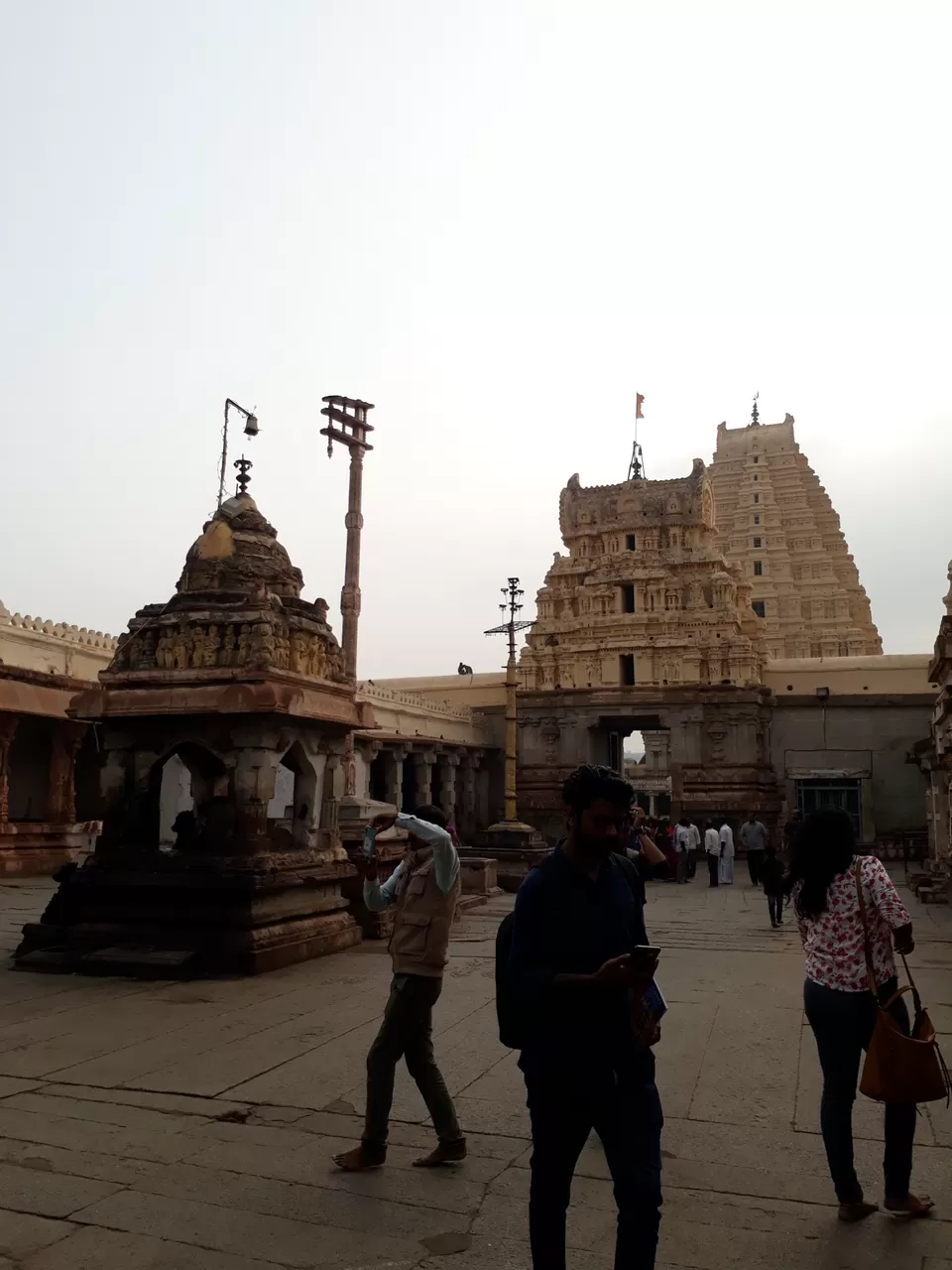
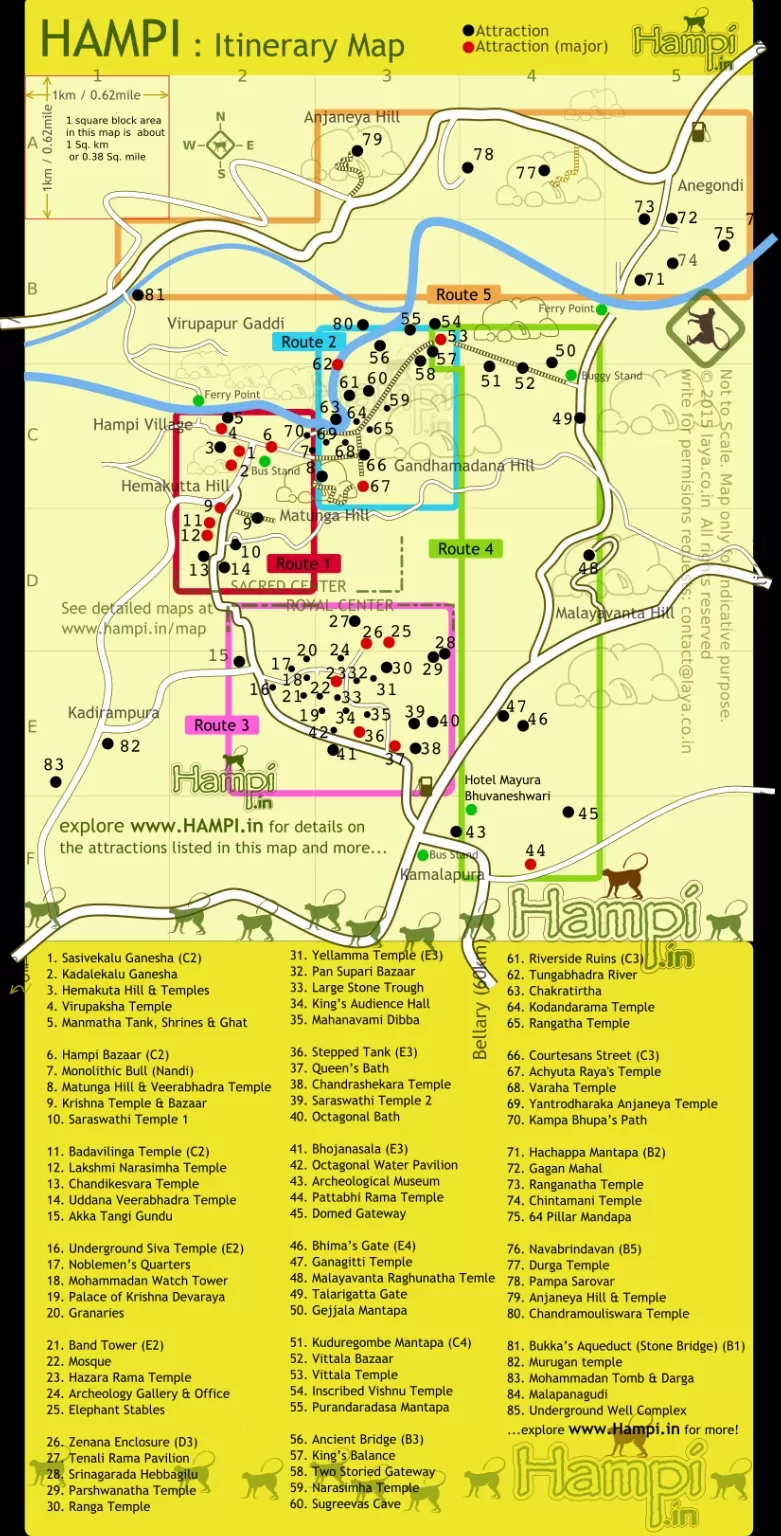
This temple is located on the south bank of the river Tungabadra, just next to where the local bus drops you. This area in general has been an important pilgrimage centre for the worshipers of lord Shiva. Virupaksha temple is equally sort after by the tourists and pilgrims. The annual festivals attract huge crowds of both the types. The very origin of Hampis history as a sacred place revolves around the myths associated with this temple. It believed that this temple has been functioning uninterruptedly ever since its inception in the 7th century AD.That makes this one of the oldest functioning temples in India. The original worship place was only a few separate humble shrines (believed to be as old as 7th century) housing the image of the god and the goddesses. Over the centuries the temple gradually expanded into a sprawling complex with many sub shrines, pillared halls, flag posts, lamp posts, towered gateways and even a large temple kitchen. You access the temples main entrance tower through the chariot street in front now popularly called the Hampi Bazaar. This east facing giant tower (Gopura) leads you the first courtyard of the temple complex. This pastel painted 9 storied tower with a pair of cow horn like projections on top is the most prominent landmark in Hampi. The lower two tiers of the tower is made of decorated stone work. The progressively diminishing superstructure is made with brick and mortar. All around the exterior of the first tier spots many interesting stucco figures. You may get to some distance from the base of the tower to see all of them. For example, the erotic figures of the amorous couples located at the south side of the tower. Such icons connected with fertility rites are considered auspicious on a philosophical ground. You can view them from the southward going alley (towards the post office) from this entrance to the tower. These stucco figures are located at the bottom row of the stucco figures. The main temple is east facing and has two large courtyards, one leading to the other. You directly enter into the first courtyard through the tower mentioned above. This courtyard mainly houses a pillared hall called 100-column hall at the far left corner, Kalyanamantapa at the far right corner, administrative offices, the ticket counter, a police outpost and even an old well. A kitchen complex projects out of the compound overlapping the two courts at the south wall. A narrow passage on the wall of the 100 pillared hall gives access to the kitchen. A water channel system connected to the nearby river is built into the floor of the kitchen complex. You can see the remains of its feeding channels outside the southwest corner of the temple corner. Just next to your left immediately after you have entered, you can see the unusual triple headed Nandi (bull statue). Behind this the wall is painted with a large map of Hampi with the main attractions marked. Towards your right close to the tower is a police outpost. Foreign tourists are requested to register their details here. This is a simple process of entering your names and other details in the register book kept at this office. You many register it at any time and not a pre requisite to enter the temple. Further forward (east) towards the second tower you would find the ticket counter and the shoe safekeeping (1 rupee per pair) booth and a souvenir stall with a good collection of books & maps on Hampi. The three storied tower built in 1510 AD is known after its patron, Krishadeva Raya, one of the famous kings of the empire. From the ticket counter close to this tower you can buy the entry ticket (Rs5), camera ticket (Rs50) and pay the video camera fee (Rs 500) The tower gives access to the inner court. On entering this you would meet an important inmate the temple, the little naughty elephant. Give a one-rupee coin (the elephant takes it from you with its trunk) and you can get a smooch on head, treated as blessing. In the middle of the court along the axis facing the main shrine is a lamp post, the Balipitas(sacred platforms), a flag post and a whitewashed pavilion in which two Nandi(bull)status are positioned. All around this open area are the pillared cloisters leaving gaps at the north, south and east edges for a series of sub shrines. The facing portion of the cloister is lined with a row of decorated pillars. The lion figure carved on the base of each these pillars seems supporting the slender upper portions. Close looks at each of the pillers reveal interesting figures of animals and other life scenes. Pair of elephant balustrades at the middle of the row gives access to the top of the cloister platform. The western end of the south cloister spots a rectangular opening on the floor. A shrine is located underground. A Nandi is positioned near the opening. Near to it is a huge stone urn with decorations. Towards the end you can see a pair of metal bells and a large leather clad percussion instrument. The most striking feature of this court is the central pillared hall known as the Ranga Mandapa added to the temple complex in 1510 AD by Krishadeva Raya. Two mythical lion like creatures forms the balustrade for the entrance to this elevated open pavilion. As you enter the pavilion on your right is an inscribed plaque with Nandi image on top probably explains the royal patronage the temple enjoyed. This hall with 5 aisles and 38 pillars is used for temple rituals including the marriage ceremonies. The highlights include rows of pillars shaped with rampant lion like mythical creatures (Yalis) standing on aquatic creatures (Makara or Crocodiles). Warriors seem riding on these ferocious looking creatures. The mural panel on the central portion of the hall is one of the few remains of this form of Vijayanagara art. Most of it is based on godly themes except the one at the eastern end. Here the founder sage of the empire, Vidaranaya, is portrayed moving in a procession. Further west, beyond a small inner hall, is the sanctum sanctorum of Lord Virupaksha. Two 4 armed guardian deities, about 8 feet tall, stand on either side of the entrance to the inner hall. The ceiling of this inner hall is decorated with an open lotus motif The sanctum contains the idol of lord Virupaksha in the form of a Linga (A phallus image). A corridor surrounds the sanctum. The two narrow porches on either sides of the inner hall can be used to get in and out of the main shrine. Surrounding this principal shrines are the shrines of Virupakshas consort and other deities. The most important of the sub shrines are that of Goddess Pampa and Bhuvaneswari, consorts of lord Shiva, towards the north of the main shrine. These shrines are in fact much older than the rest of the grandiose structures in the compound. The short circular pillars and the doorways and the ceiling are richly carved. A bit east along the cloister, you can spot a flight of leading to an underground chamber. This contains the shrine of Pataleswara, a form of lord Shiva. Further east is the shrine of the planetary deities. Images of the nine planetary deities (Nava Grahas) are arranged on an elevated platform. Photography is not permitted inside the sanctum area. Behind the main sanctum a flight of steps leads to the rear exit of the temple complex. Just before the exit on the right side you would find a dark chamber with a slit on the wall. The sunray pass through this slit forms an inverted shadow of the main tower on the wall, a kind of pinhole camera effect created with stonework. Further up the stairs you would come out of the temple campus. Near by is a shrine dedicated to the founder sage Vidyaranya. Here also you can see the pin hole inverted shadows in a small shrine chamber. Usually someone operating the show would demonstrate it for you expecting couple of rupees tip. Most of this locality is the residential area of the temple priests. If you trace narrow path along the outer wall towards south, youll reach a small but interesting pond with pillared halls all around it. The shrines here are not under worship and the area somewhat deserted. You can see a number of crisscrossing aqueduct system mentioned earlier. Thick banana plantations and shrubs surround the location. Back to the main temple, the giant north tower, called Kangiri Gopura, near the main sanctum leads to the temples sacred pond, the Manmantha Tank and a series of shrines. Altogether you need at least 1 hours to see this temple complex. If you feel so hire a guide who would bump on you as you approach the main entrance tower (pay Rs50). You can witness the daily temple rituals and ceremonies in the mornings and evenings. Temple opens before the sunrise and closes in the night. Usually the sanctum is closed in the noon. So entry into the campus may not be possible at that point of time.
This temple is located on the south bank of the river Tungabadra, just next to where the local bus drops you. This area in general has been an important pilgrimage centre for the worshipers of lord Shiva. Virupaksha temple is equally sort after by the tourists and pilgrims. The annual festivals attract huge crowds of both the types. The very origin of Hampis history as a sacred place revolves around the myths associated with this temple. It believed that this temple has been functioning uninterruptedly ever since its inception in the 7th century AD.That makes this one of the oldest functioning temples in India. The original worship place was only a few separate humble shrines (believed to be as old as 7th century) housing the image of the god and the goddesses. Over the centuries the temple gradually expanded into a sprawling complex with many sub shrines, pillared halls, flag posts, lamp posts, towered gateways and even a large temple kitchen. You access the temples main entrance tower through the chariot street in front now popularly called the Hampi Bazaar. This east facing giant tower (Gopura) leads you the first courtyard of the temple complex. This pastel painted 9 storied tower with a pair of cow horn like projections on top is the most prominent landmark in Hampi. The lower two tiers of the tower is made of decorated stone work. The progressively diminishing superstructure is made with brick and mortar. All around the exterior of the first tier spots many interesting stucco figures. You may get to some distance from the base of the tower to see all of them. For example, the erotic figures of the amorous couples located at the south side of the tower. Such icons connected with fertility rites are considered auspicious on a philosophical ground. You can view them from the southward going alley (towards the post office) from this entrance to the tower. These stucco figures are located at the bottom row of the stucco figures. The main temple is east facing and has two large courtyards, one leading to the other. You directly enter into the first courtyard through the tower mentioned above. This courtyard mainly houses a pillared hall called 100-column hall at the far left corner, Kalyanamantapa at the far right corner, administrative offices, the ticket counter, a police outpost and even an old well. A kitchen complex projects out of the compound overlapping the two courts at the south wall. A narrow passage on the wall of the 100 pillared hall gives access to the kitchen. A water channel system connected to the nearby river is built into the floor of the kitchen complex. You can see the remains of its feeding channels outside the southwest corner of the temple corner. Just next to your left immediately after you have entered, you can see the unusual triple headed Nandi (bull statue). Behind this the wall is painted with a large map of Hampi with the main attractions marked. Towards your right close to the tower is a police outpost. Foreign tourists are requested to register their details here. This is a simple process of entering your names and other details in the register book kept at this office. You many register it at any time and not a pre requisite to enter the temple. Further forward (east) towards the second tower you would find the ticket counter and the shoe safekeeping (1 rupee per pair) booth and a souvenir stall with a good collection of books & maps on Hampi. The three storied tower built in 1510 AD is known after its patron, Krishadeva Raya, one of the famous kings of the empire. From the ticket counter close to this tower you can buy the entry ticket (Rs5), camera ticket (Rs50) and pay the video camera fee (Rs 500) The tower gives access to the inner court. On entering this you would meet an important inmate the temple, the little naughty elephant. Give a one-rupee coin (the elephant takes it from you with its trunk) and you can get a smooch on head, treated as blessing. In the middle of the court along the axis facing the main shrine is a lamp post, the Balipitas(sacred platforms), a flag post and a whitewashed pavilion in which two Nandi(bull)status are positioned. All around this open area are the pillared cloisters leaving gaps at the north, south and east edges for a series of sub shrines. The facing portion of the cloister is lined with a row of decorated pillars. The lion figure carved on the base of each these pillars seems supporting the slender upper portions. Close looks at each of the pillers reveal interesting figures of animals and other life scenes. Pair of elephant balustrades at the middle of the row gives access to the top of the cloister platform. The western end of the south cloister spots a rectangular opening on the floor. A shrine is located underground. A Nandi is positioned near the opening. Near to it is a huge stone urn with decorations. Towards the end you can see a pair of metal bells and a large leather clad percussion instrument. The most striking feature of this court is the central pillared hall known as the Ranga Mandapa added to the temple complex in 1510 AD by Krishadeva Raya. Two mythical lion like creatures forms the balustrade for the entrance to this elevated open pavilion. As you enter the pavilion on your right is an inscribed plaque with Nandi image on top probably explains the royal patronage the temple enjoyed. This hall with 5 aisles and 38 pillars is used for temple rituals including the marriage ceremonies. The highlights include rows of pillars shaped with rampant lion like mythical creatures (Yalis) standing on aquatic creatures (Makara or Crocodiles). Warriors seem riding on these ferocious looking creatures. The mural panel on the central portion of the hall is one of the few remains of this form of Vijayanagara art. Most of it is based on godly themes except the one at the eastern end. Here the founder sage of the empire, Vidaranaya, is portrayed moving in a procession. Further west, beyond a small inner hall, is the sanctum sanctorum of Lord Virupaksha. Two 4 armed guardian deities, about 8 feet tall, stand on either side of the entrance to the inner hall. The ceiling of this inner hall is decorated with an open lotus motif The sanctum contains the idol of lord Virupaksha in the form of a Linga (A phallus image). A corridor surrounds the sanctum. The two narrow porches on either sides of the inner hall can be used to get in and out of the main shrine. Surrounding this principal shrines are the shrines of Virupakshas consort and other deities. The most important of the sub shrines are that of Goddess Pampa and Bhuvaneswari, consorts of lord Shiva, towards the north of the main shrine. These shrines are in fact much older than the rest of the grandiose structures in the compound. The short circular pillars and the doorways and the ceiling are richly carved. A bit east along the cloister, you can spot a flight of leading to an underground chamber. This contains the shrine of Pataleswara, a form of lord Shiva. Further east is the shrine of the planetary deities. Images of the nine planetary deities (Nava Grahas) are arranged on an elevated platform. Photography is not permitted inside the sanctum area. Behind the main sanctum a flight of steps leads to the rear exit of the temple complex. Just before the exit on the right side you would find a dark chamber with a slit on the wall. The sunray pass through this slit forms an inverted shadow of the main tower on the wall, a kind of pinhole camera effect created with stonework. Further up the stairs you would come out of the temple campus. Near by is a shrine dedicated to the founder sage Vidyaranya. Here also you can see the pin hole inverted shadows in a small shrine chamber. Usually someone operating the show would demonstrate it for you expecting couple of rupees tip. Most of this locality is the residential area of the temple priests. If you trace narrow path along the outer wall towards south, youll reach a small but interesting pond with pillared halls all around it. The shrines here are not under worship and the area somewhat deserted. You can see a number of crisscrossing aqueduct system mentioned earlier. Thick banana plantations and shrubs surround the location. Back to the main temple, the giant north tower, called Kangiri Gopura, near the main sanctum leads to the temples sacred pond, the Manmantha Tank and a series of shrines. Altogether you need at least 1 hours to see this temple complex. If you feel so hire a guide who would bump on you as you approach the main entrance tower (pay Rs50). You can witness the daily temple rituals and ceremonies in the mornings and evenings. Temple opens before the sunrise and closes in the night. Usually the sanctum is closed in the noon. So entry into the campus may not be possible at that point of time.
2.KADLEKALU GANESHA
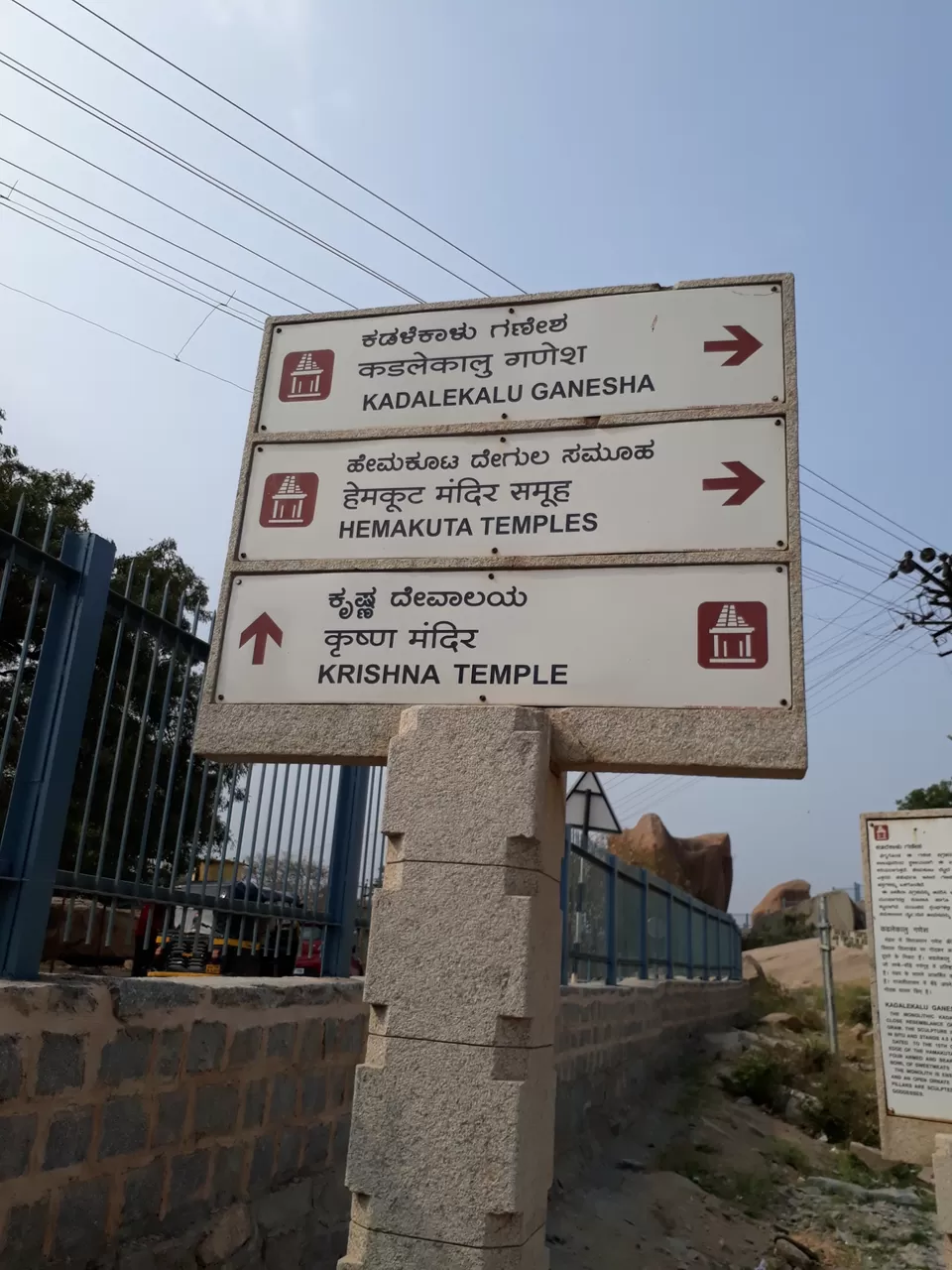
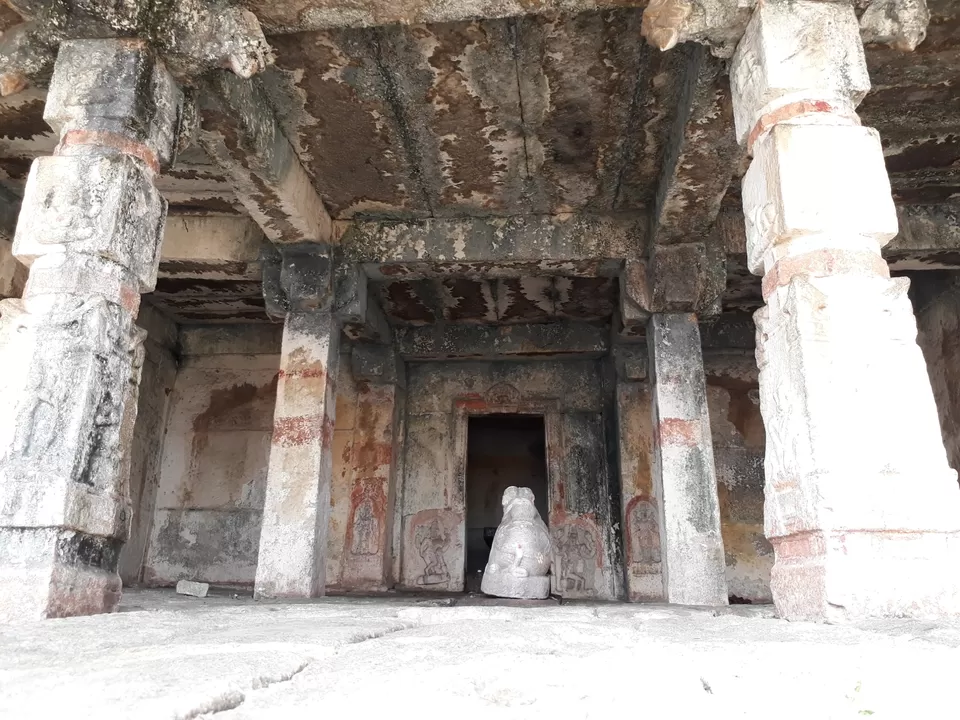
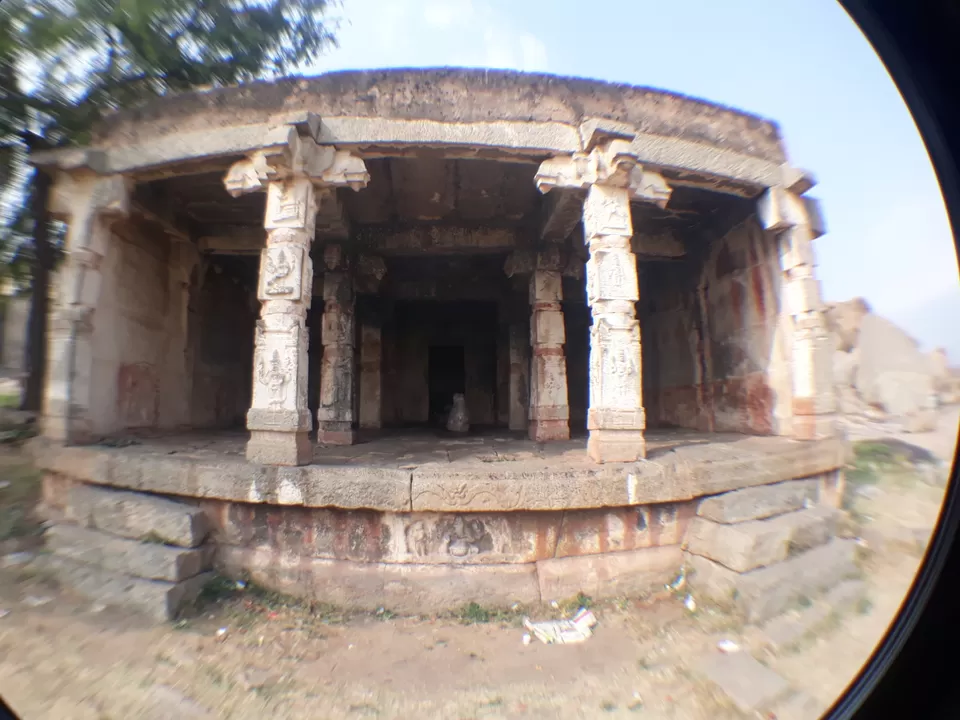
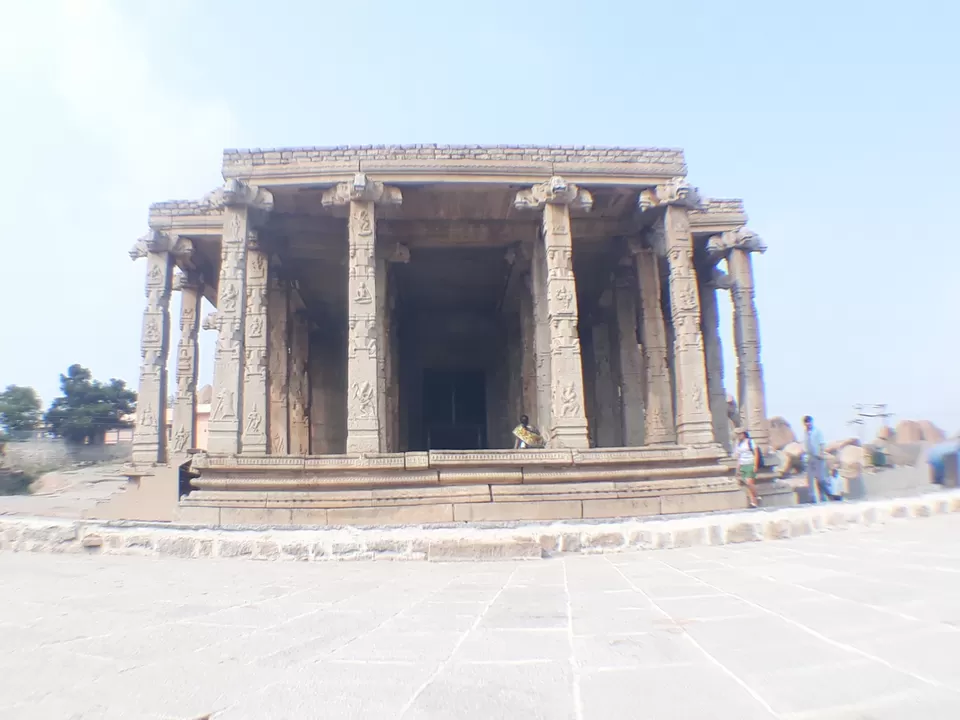
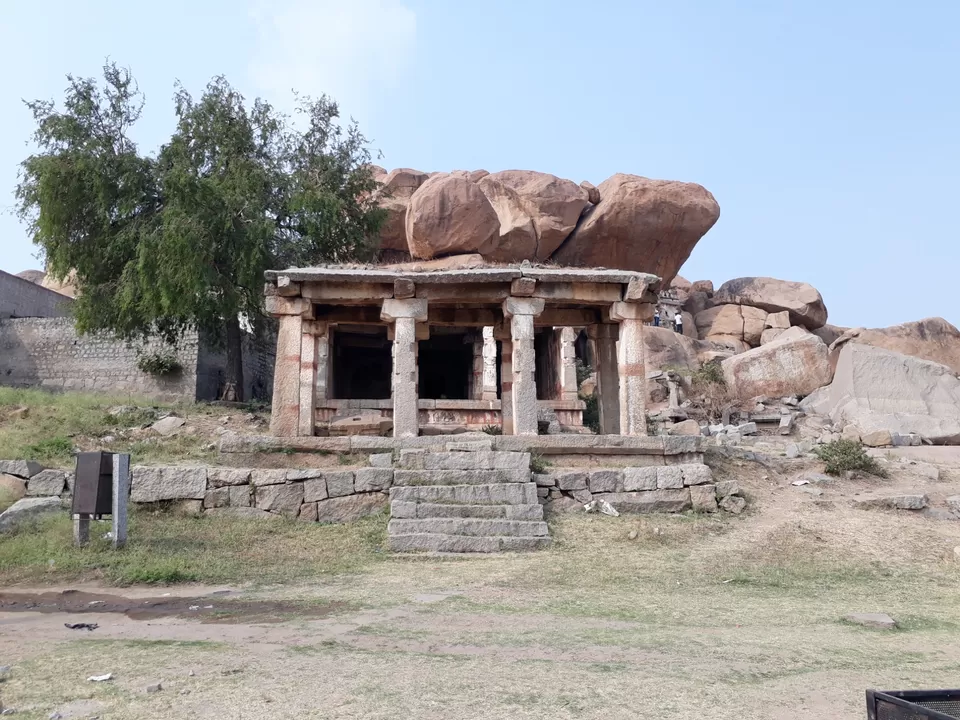
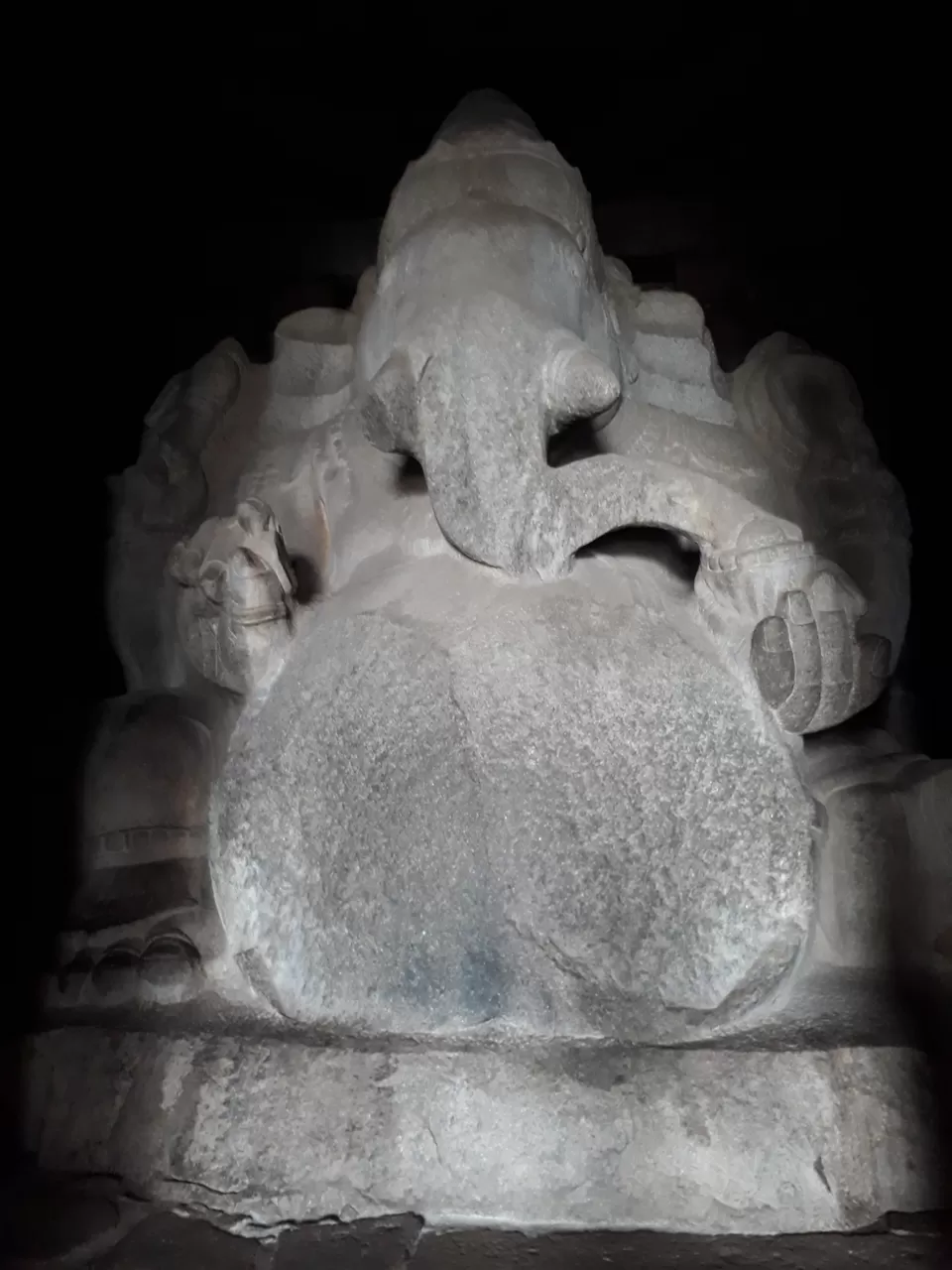
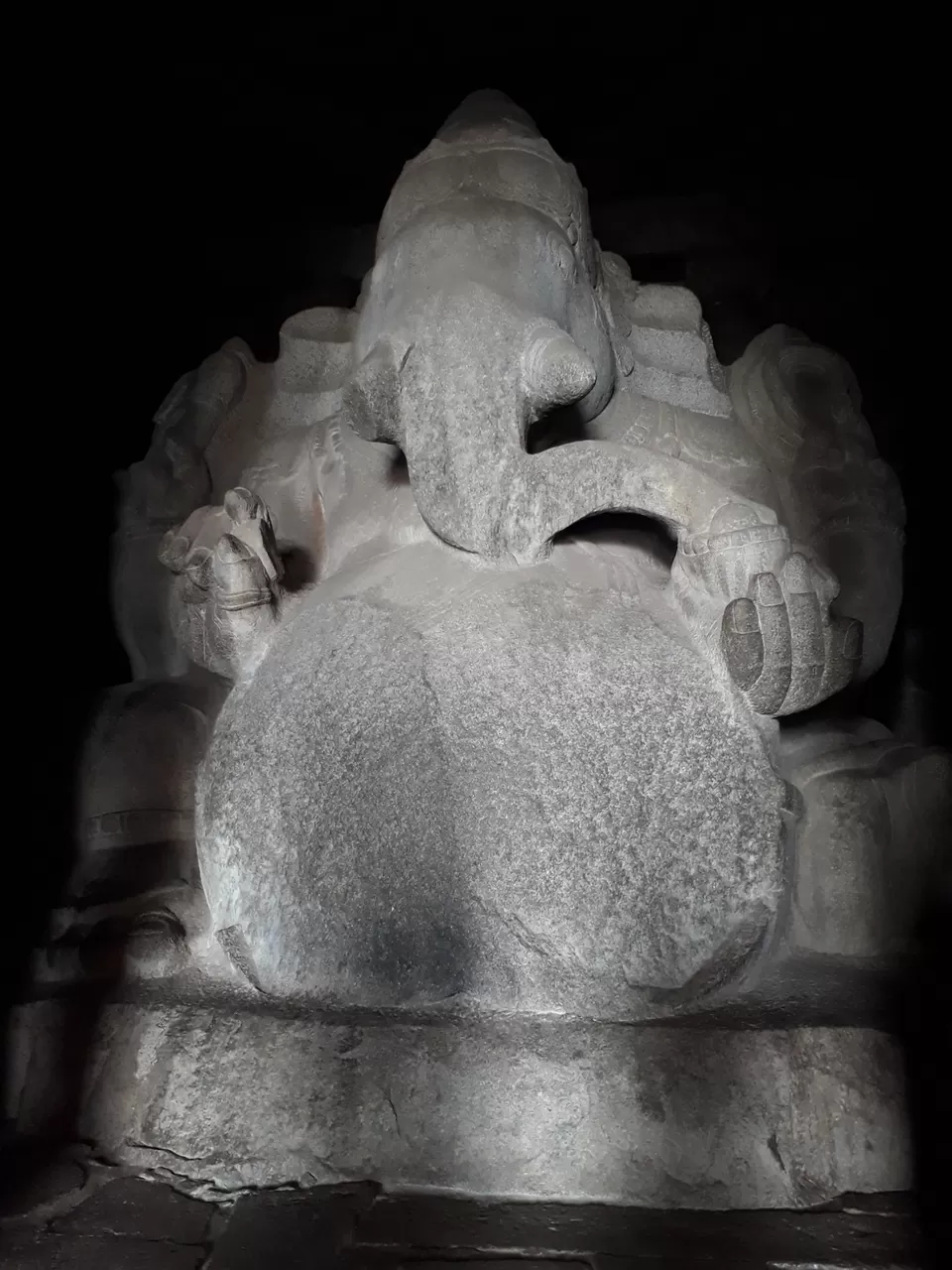
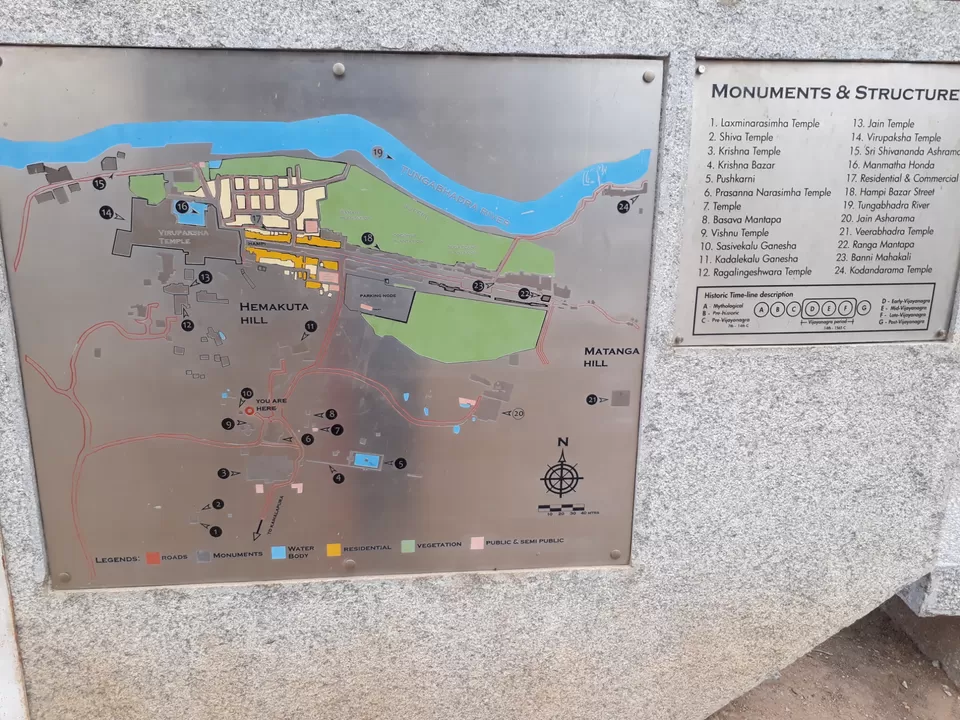
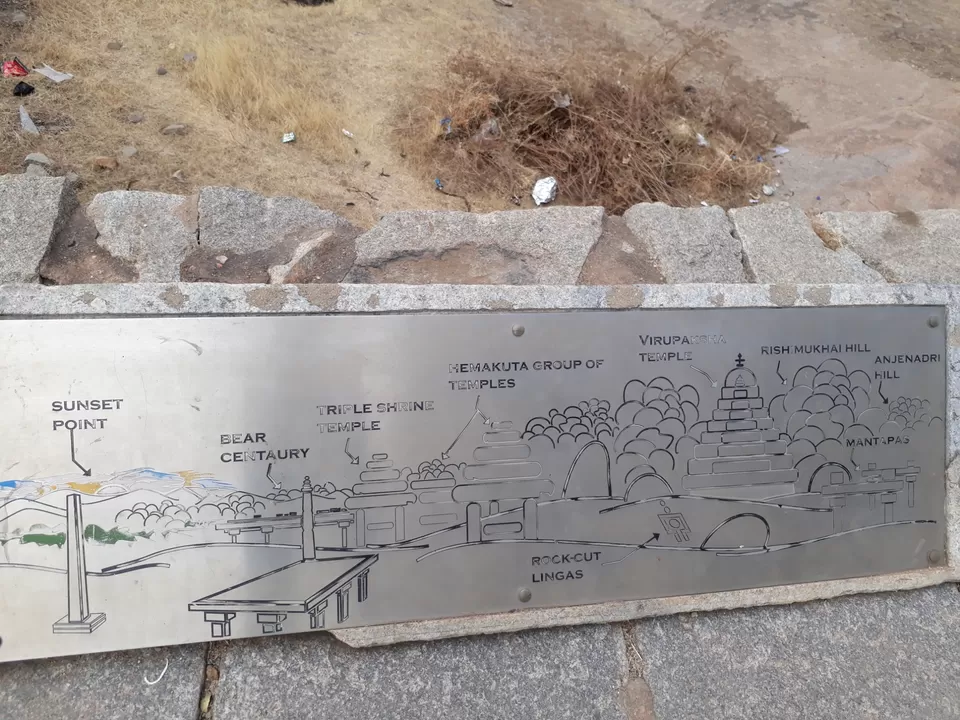
This giant statue of Ganesha was carved out of a huge boulder at the northeastern slope of the Hemakuta hill. The belly of this statue resembles a Bengal gram (Kadalekalu, in local language) and hence the name. A sanctum is built around the statue. The pillared hall in front of this sanctum is as charming as this giant statue itself. The open hall constructed by unusually slender and tall pillars. Each of them is highly ornate with mythical themes. This 4.5 meters (15 feet) tall statue is one among the largest sculptures in Hampi. The pillared hall is a vantage point to survey the environs, especially the Hampi Bazaar and the foothills of Matanga Hill.No admission fee.Photography permitted free.
3.SASIVEKALU GANESHA
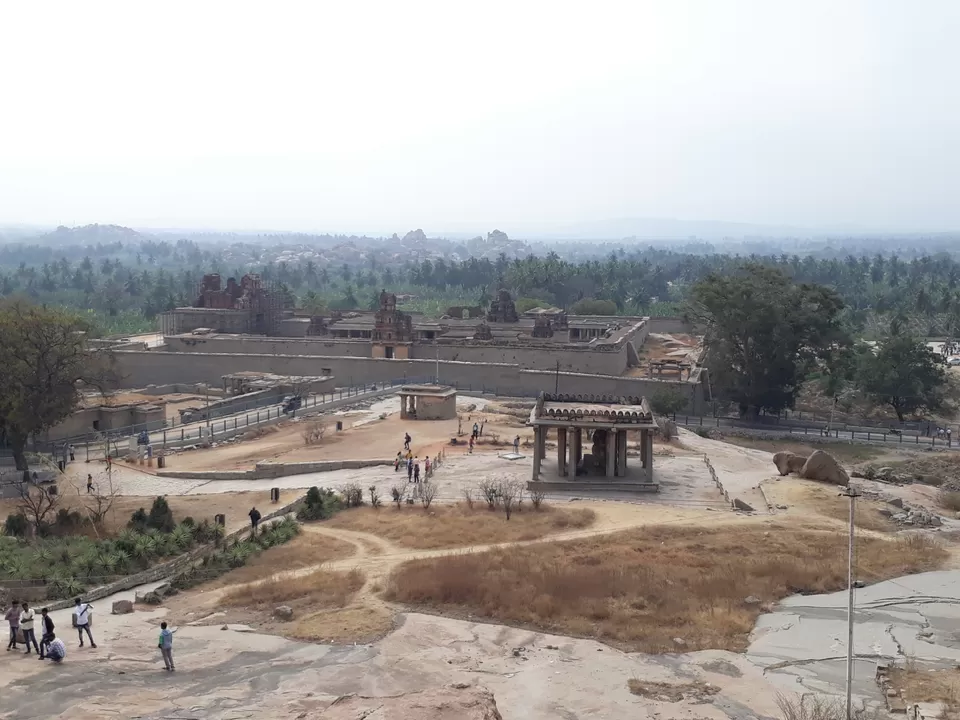
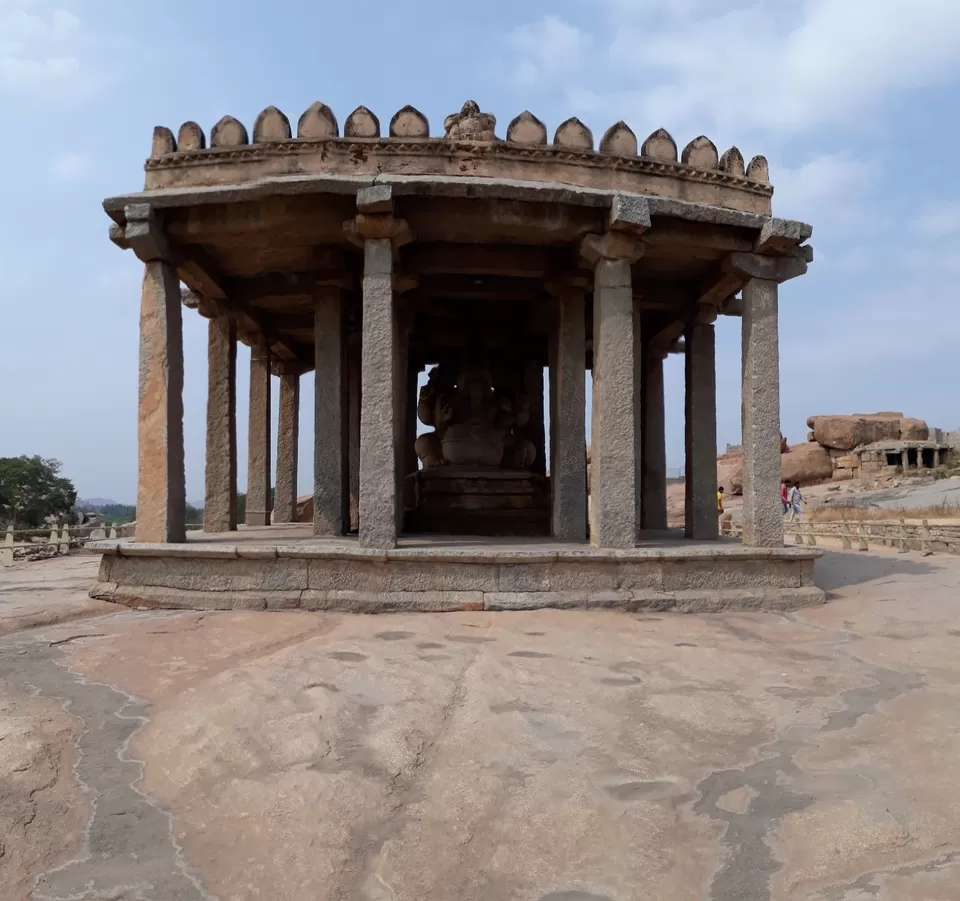
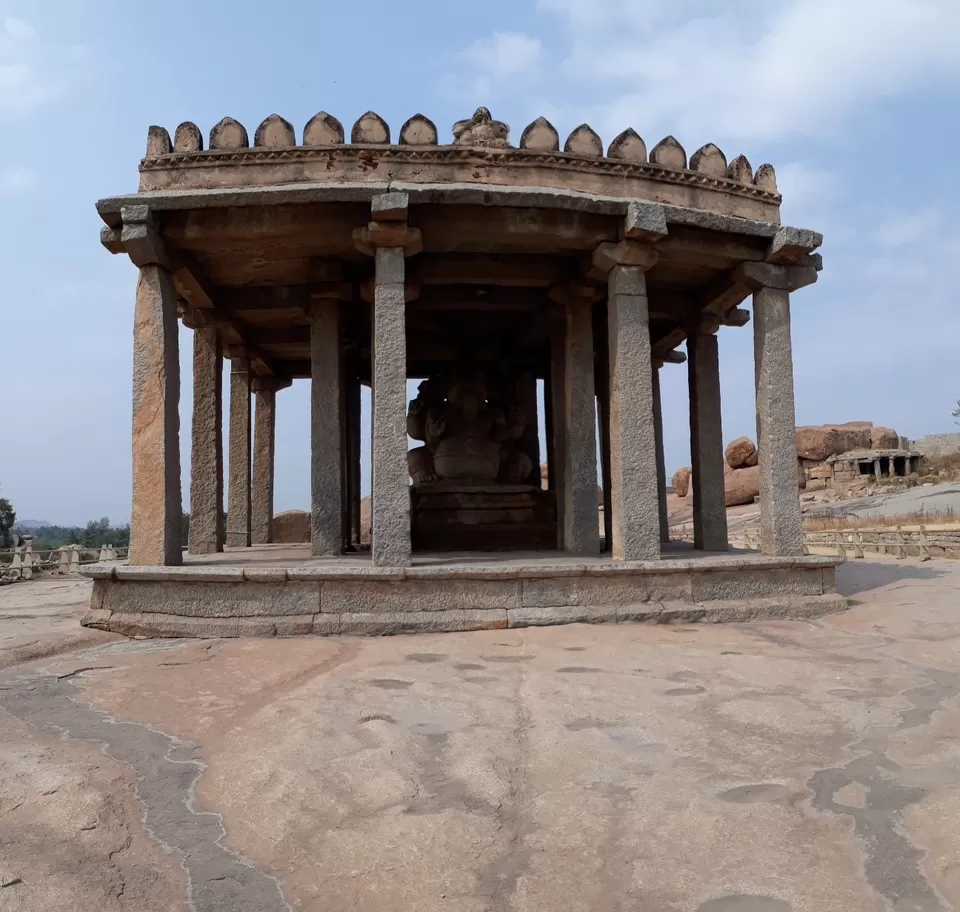
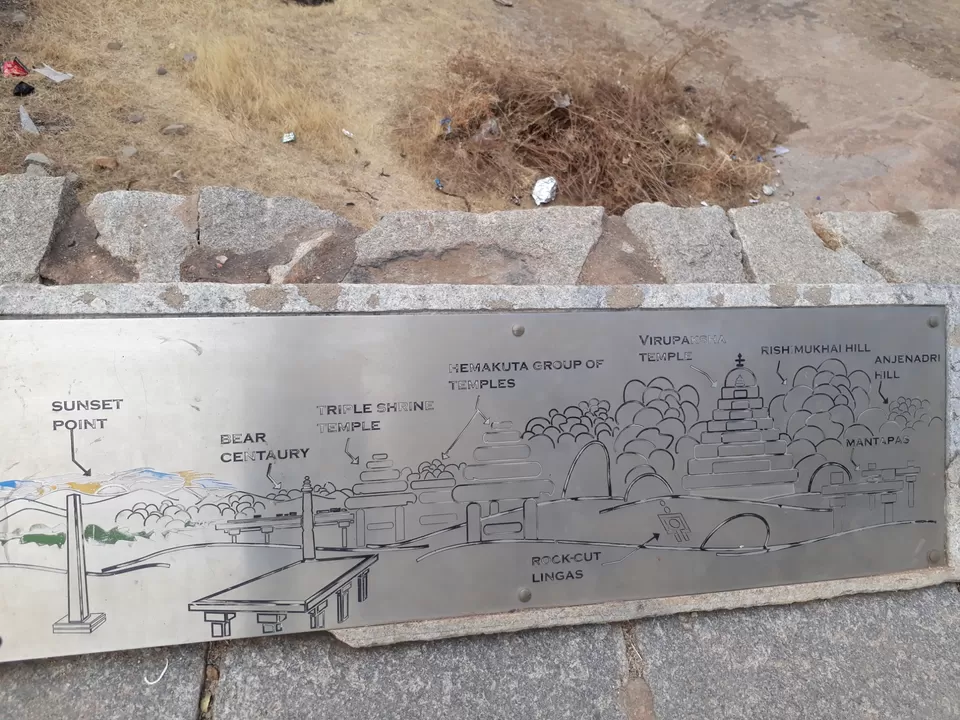
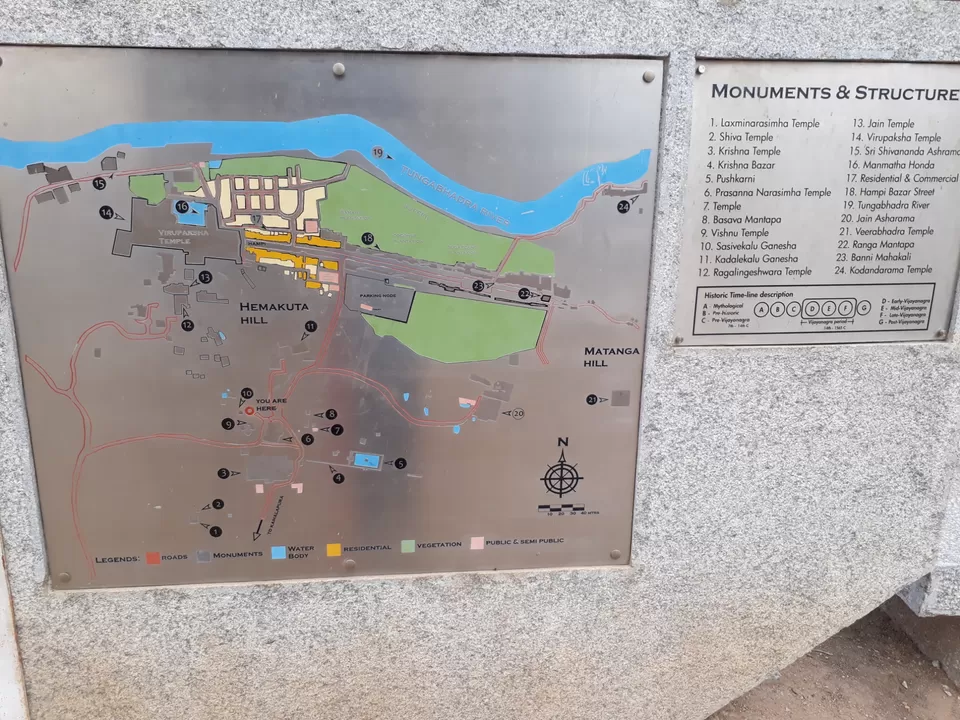
Sasivekalu Ganesha Thanks to the resemblance the giant monolithic Ganesha statue is locally called Sasivekalu(mustard seed)Ganesha. This is located on the southern foothill of the Hemakuta Hill. In Hindu mythology Lord Ganesha (also known as Ganapathi or Vinayaka) is notorious for his food habit. One day he ate so much of food that his tummy almost busted. He just caught a snake and tied it around his tummy as a belt to save his tummy from bursting. On this statue you can see the snake carved around his tummy. Also he holds the goad, pasha (noose), and his broken tusk. The hand which holds modak (a kind of sweet ball) is broken and not reconstructed. This monolithic statue carved out of a huge boulder measures about 2.4 meters (8 feet). An open pavilion is build around the statue. According to inscriptions found nearby this pavilion was built by a trader from Chandragiri (in present day Andhra Pradesh)in 1506 AD, in memory of one of the Vijayanagara king – Narasimha II (1491-1505 AD) A bit north of Sasivekalu Ganesha is another giant statue of Ganesha, called The Kadalekalu Ganesha. A bit south of Sasivekalu Ganesha is the Vishnupada shrine. All these are walkable from one to another and can be covered in 30-45 minutes. Just in front of Sasivekalu Ganesha shrine you can see a huge site map of Hampi installed by the archeology department. No admission fee & Photography allowed free of cost.
 Sasivekalu Ganesha Thanks to the resemblance the giant monolithic Ganesha statue is locally called Sasivekalu(mustard seed)Ganesha. This is located on the southern foothill of the Hemakuta Hill. In Hindu mythology Lord Ganesha (also known as Ganapathi or Vinayaka) is notorious for his food habit. One day he ate so much of food that his tummy almost busted. He just caught a snake and tied it around his tummy as a belt to save his tummy from bursting. On this statue you can see the snake carved around his tummy. Also he holds the goad, pasha (noose), and his broken tusk. The hand which holds modak (a kind of sweet ball) is broken and not reconstructed. This monolithic statue carved out of a huge boulder measures about 2.4 meters (8 feet). An open pavilion is build around the statue. According to inscriptions found nearby this pavilion was built by a trader from Chandragiri (in present day Andhra Pradesh)in 1506 AD, in memory of one of the Vijayanagara king – Narasimha II (1491-1505 AD) A bit north of Sasivekalu Ganesha is another giant statue of Ganesha, called The Kadalekalu Ganesha. A bit south of Sasivekalu Ganesha is the Vishnupada shrine. All these are walkable from one to another and can be covered in 30-45 minutes. Just in front of Sasivekalu Ganesha shrine you can see a huge site map of Hampi installed by the archeology department. No admission fee & Photography allowed free of cost.
4.KRISHNA TEMPLE AND BAZAAR
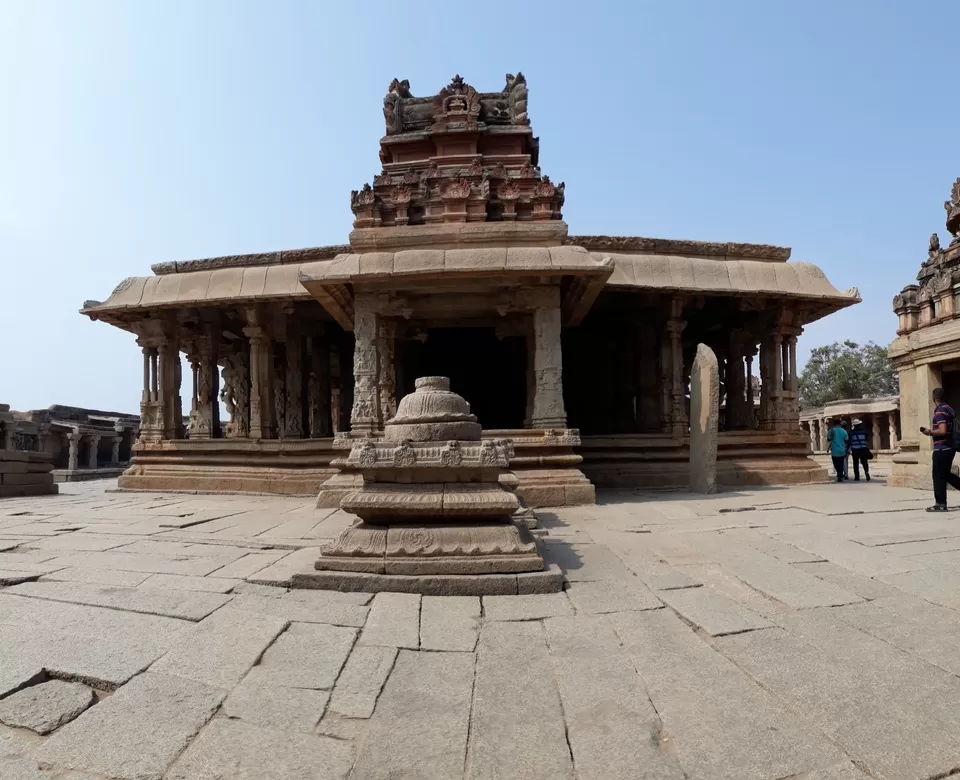
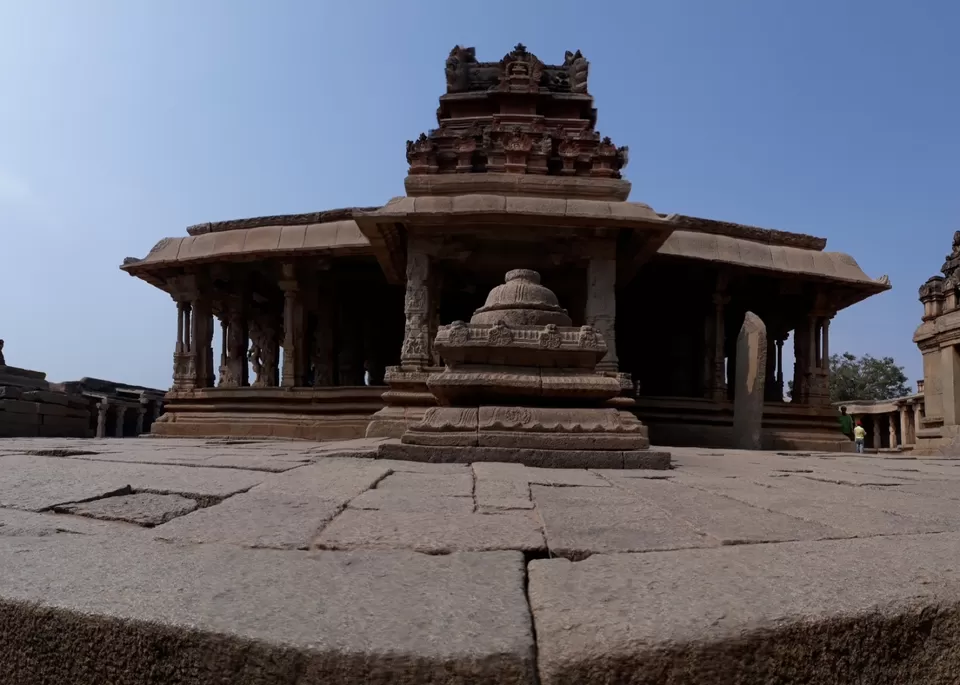
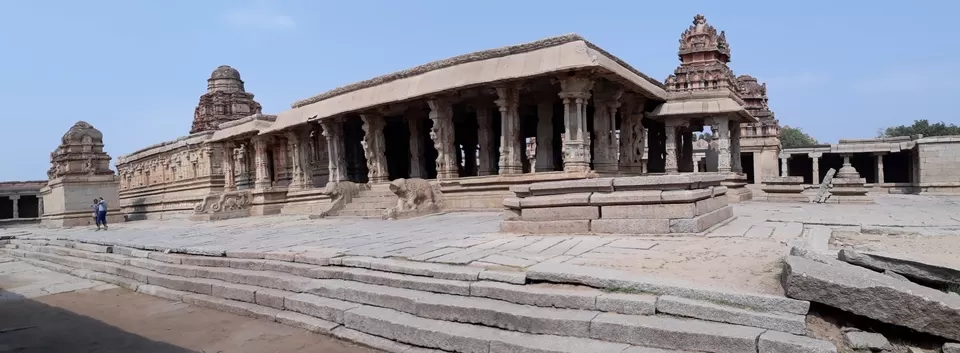
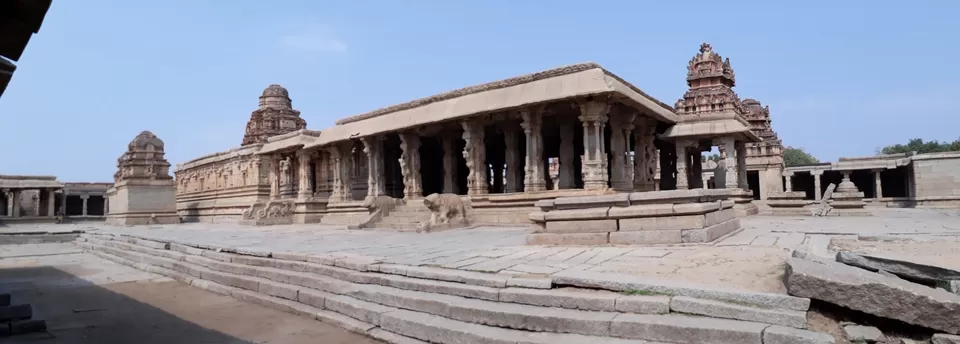
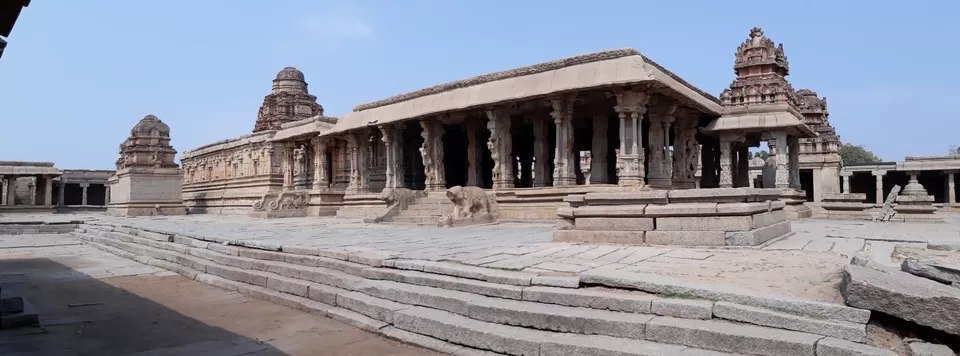
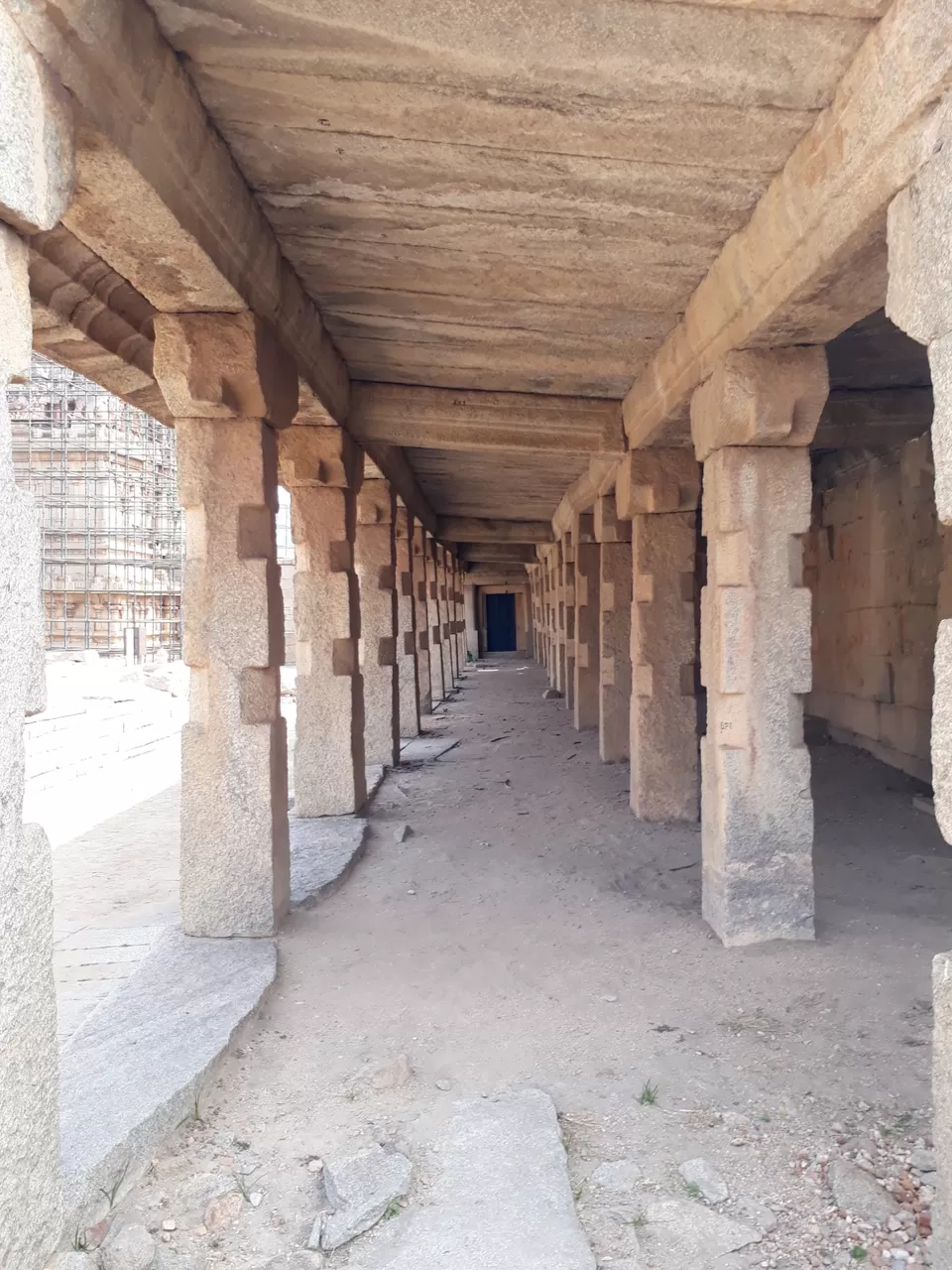
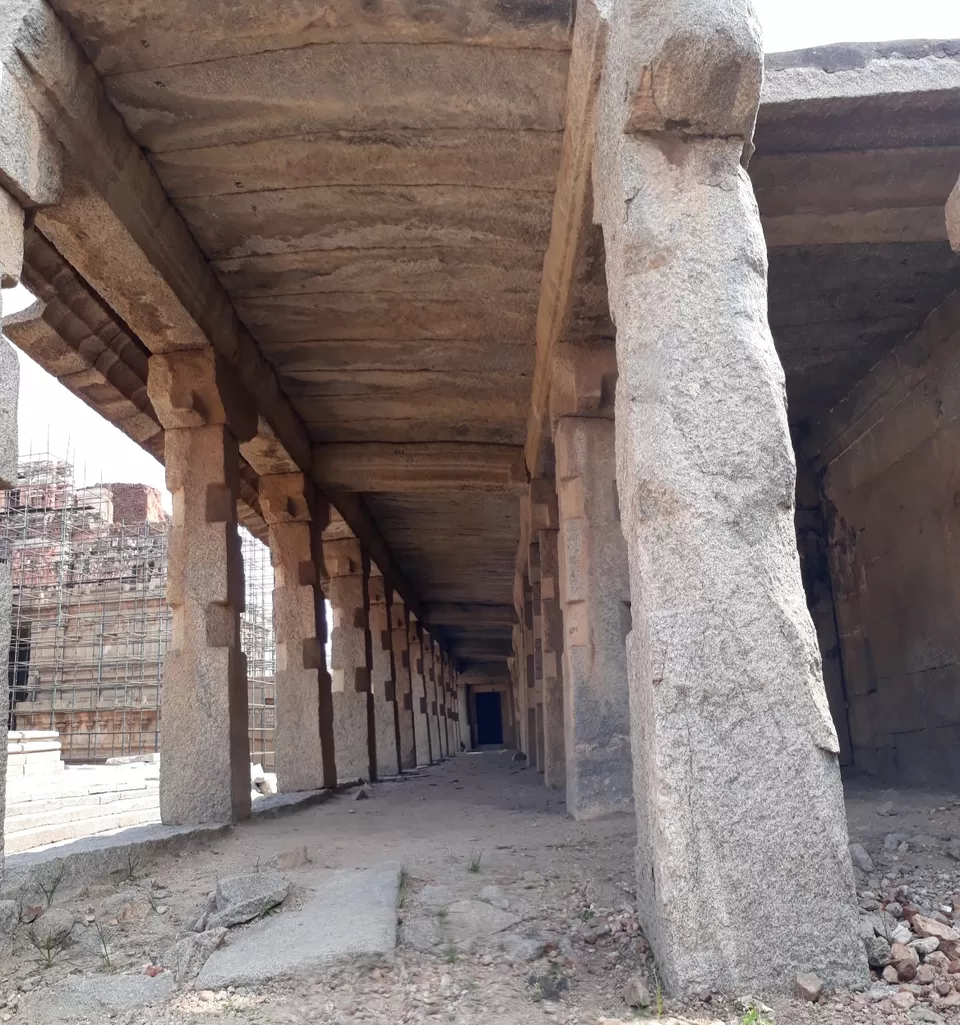
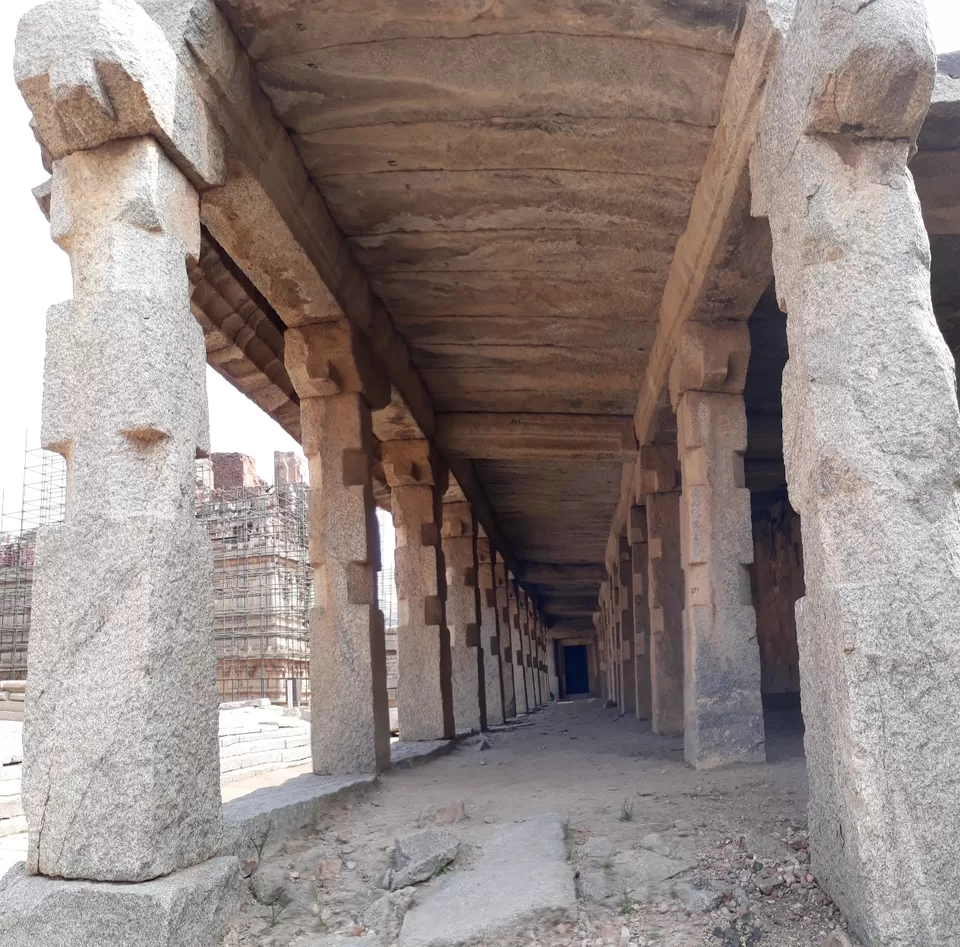
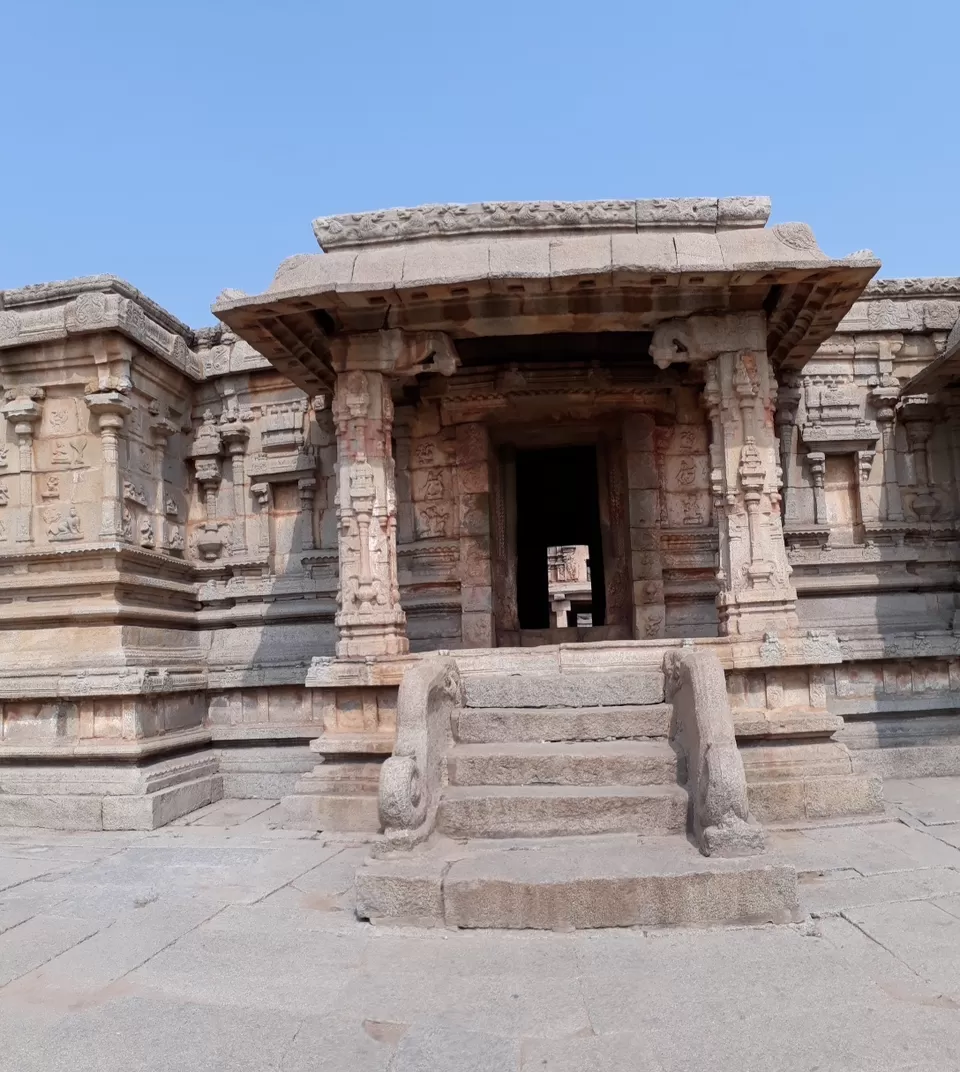
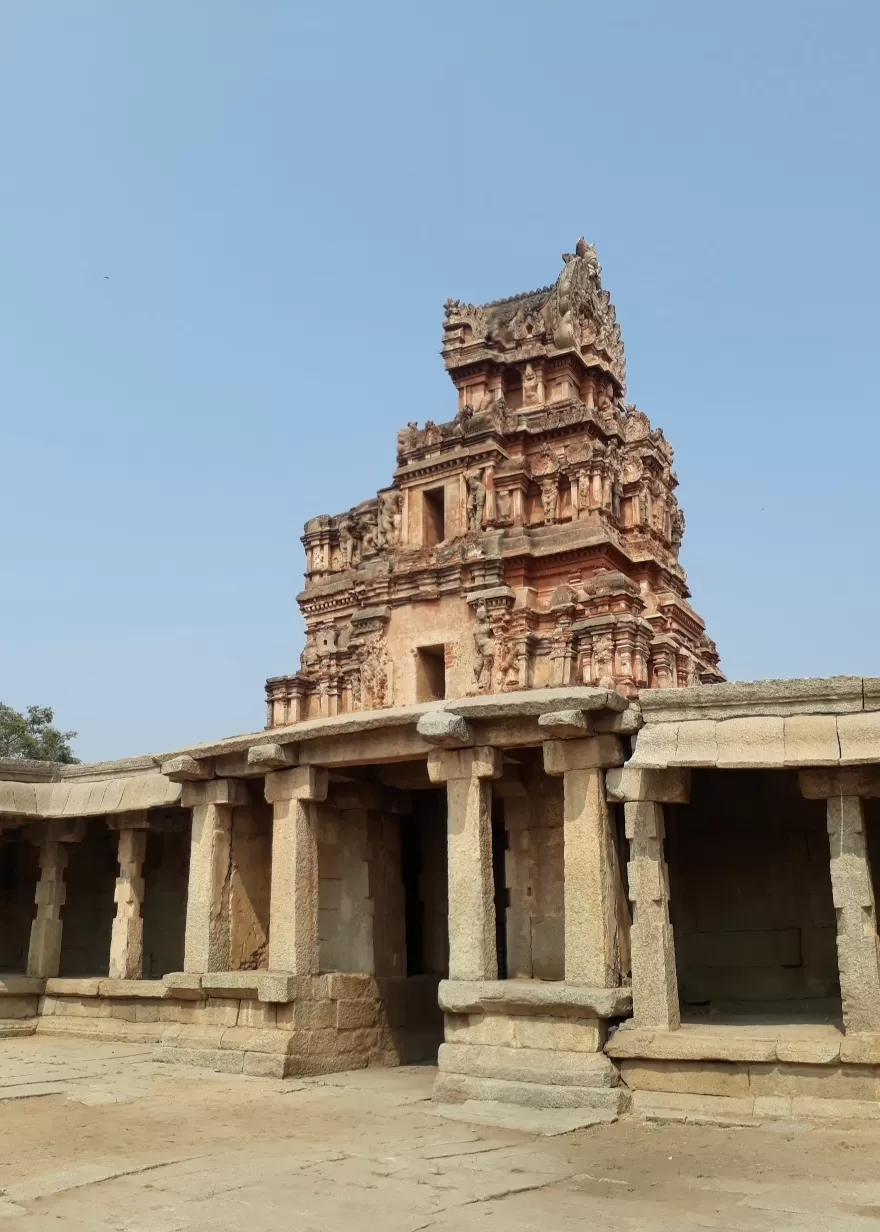
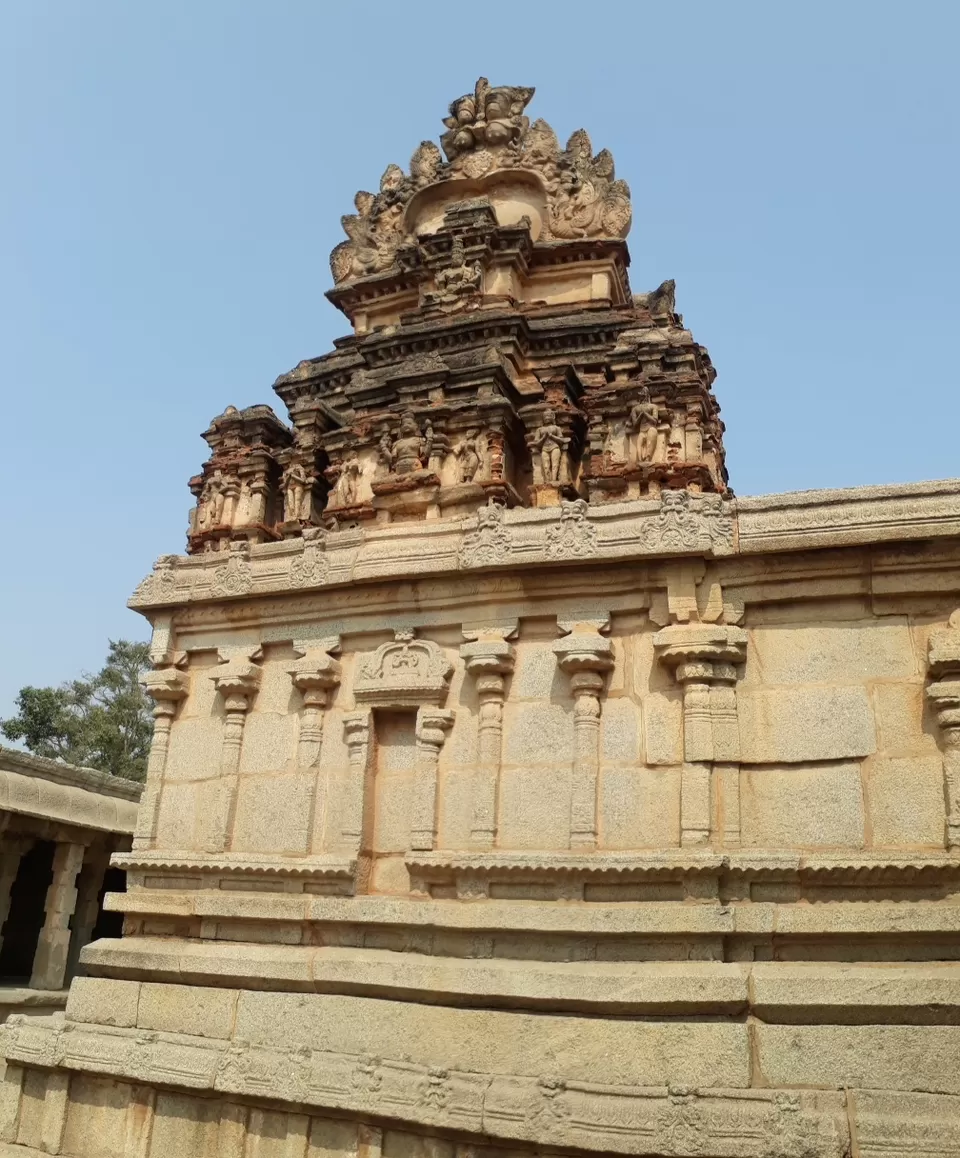
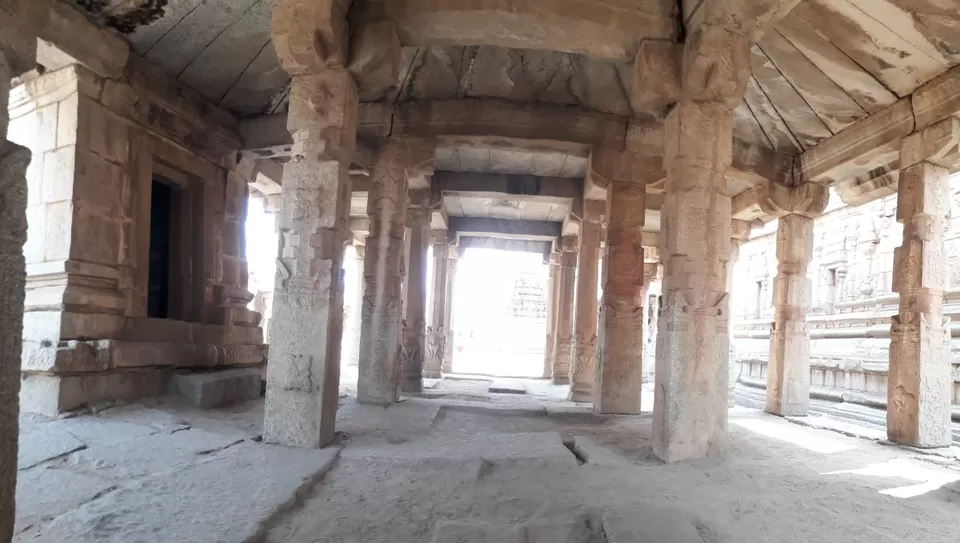
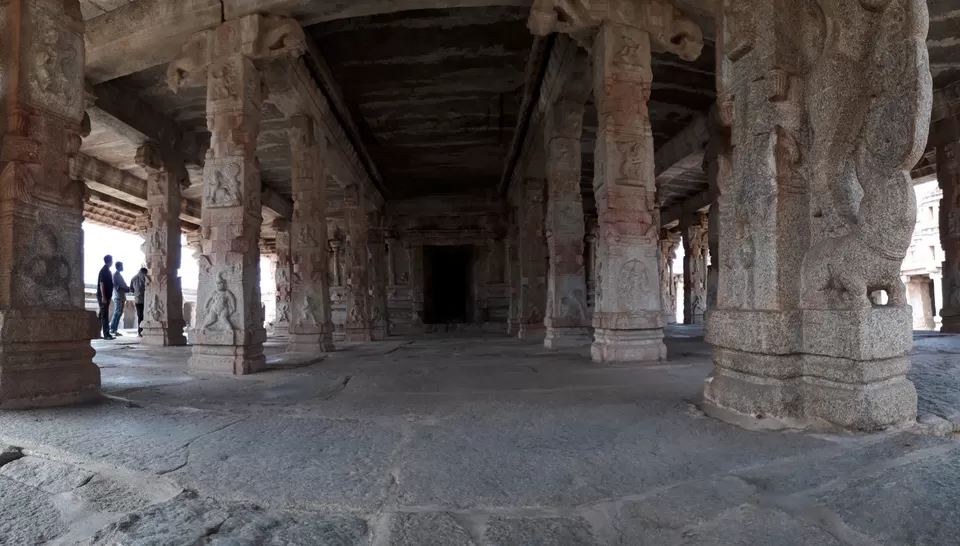
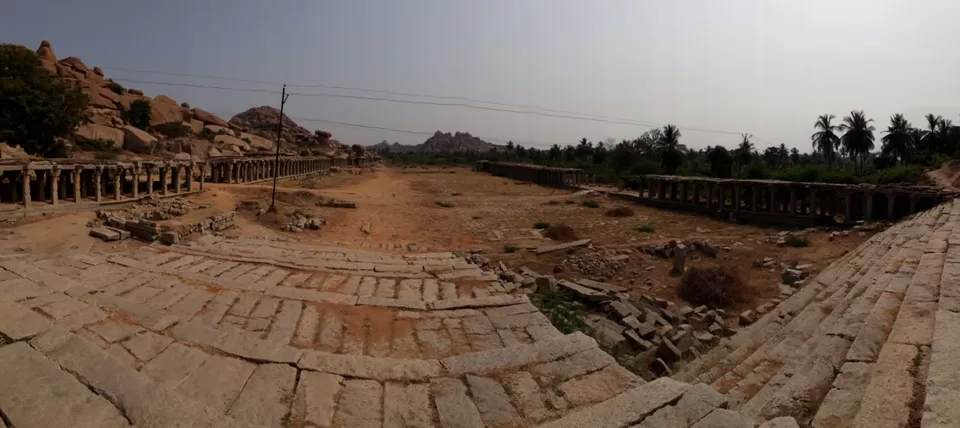
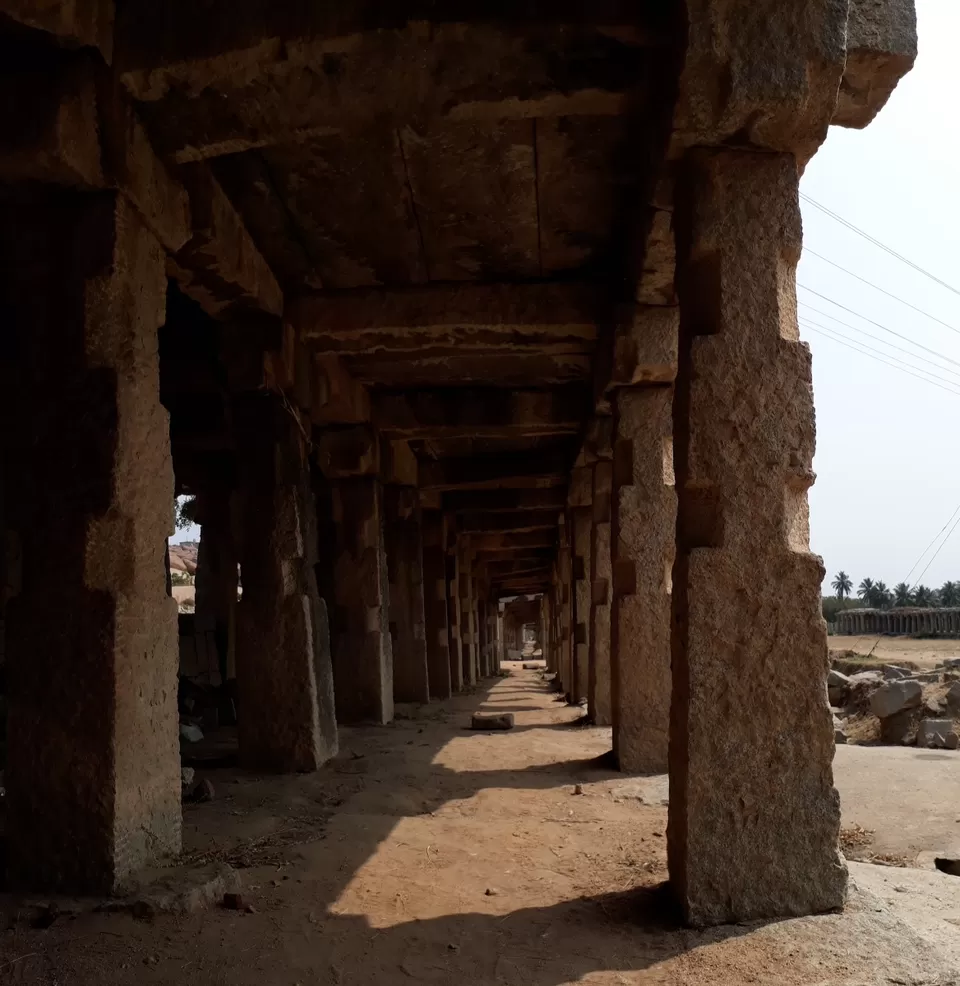
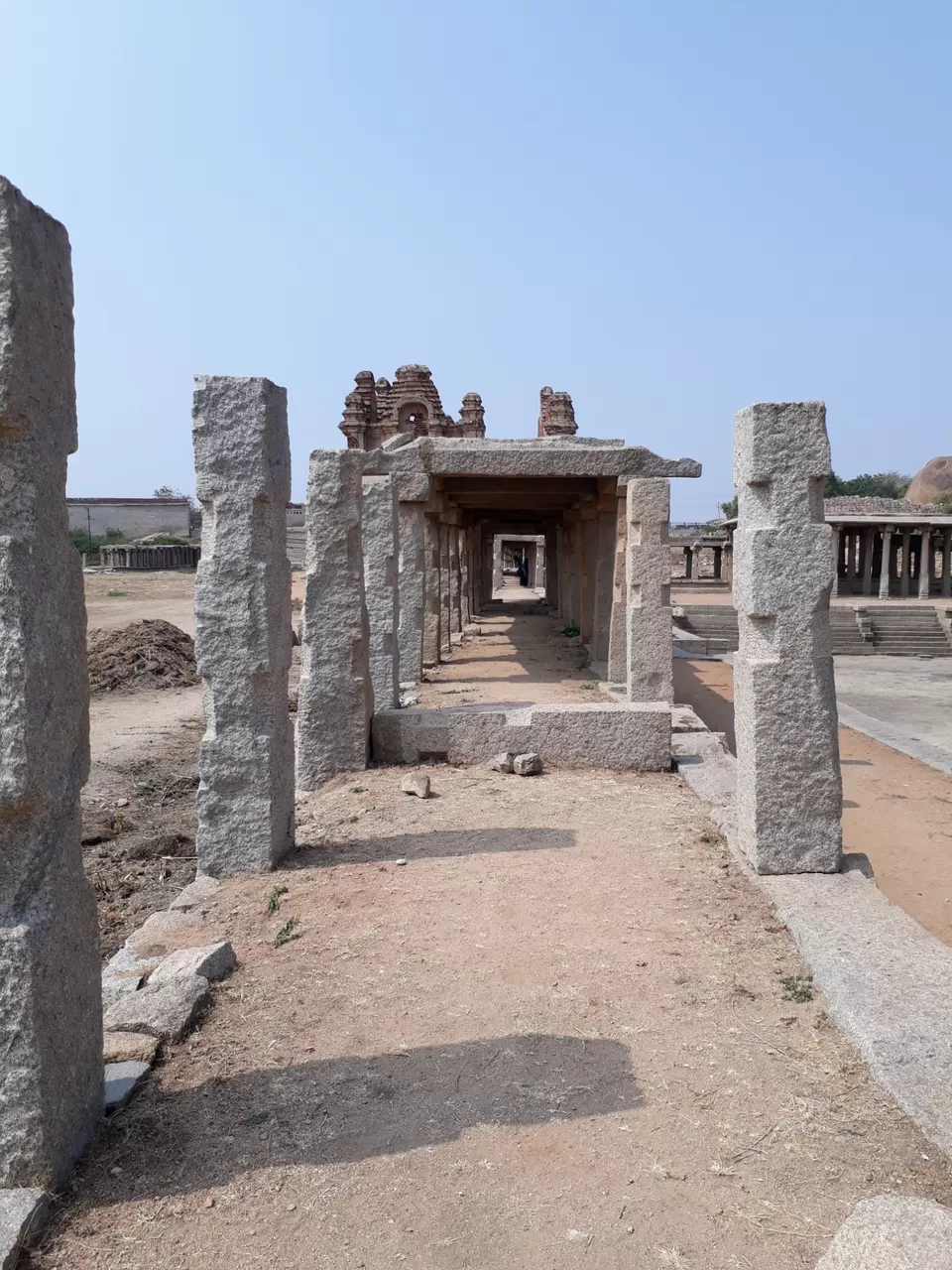
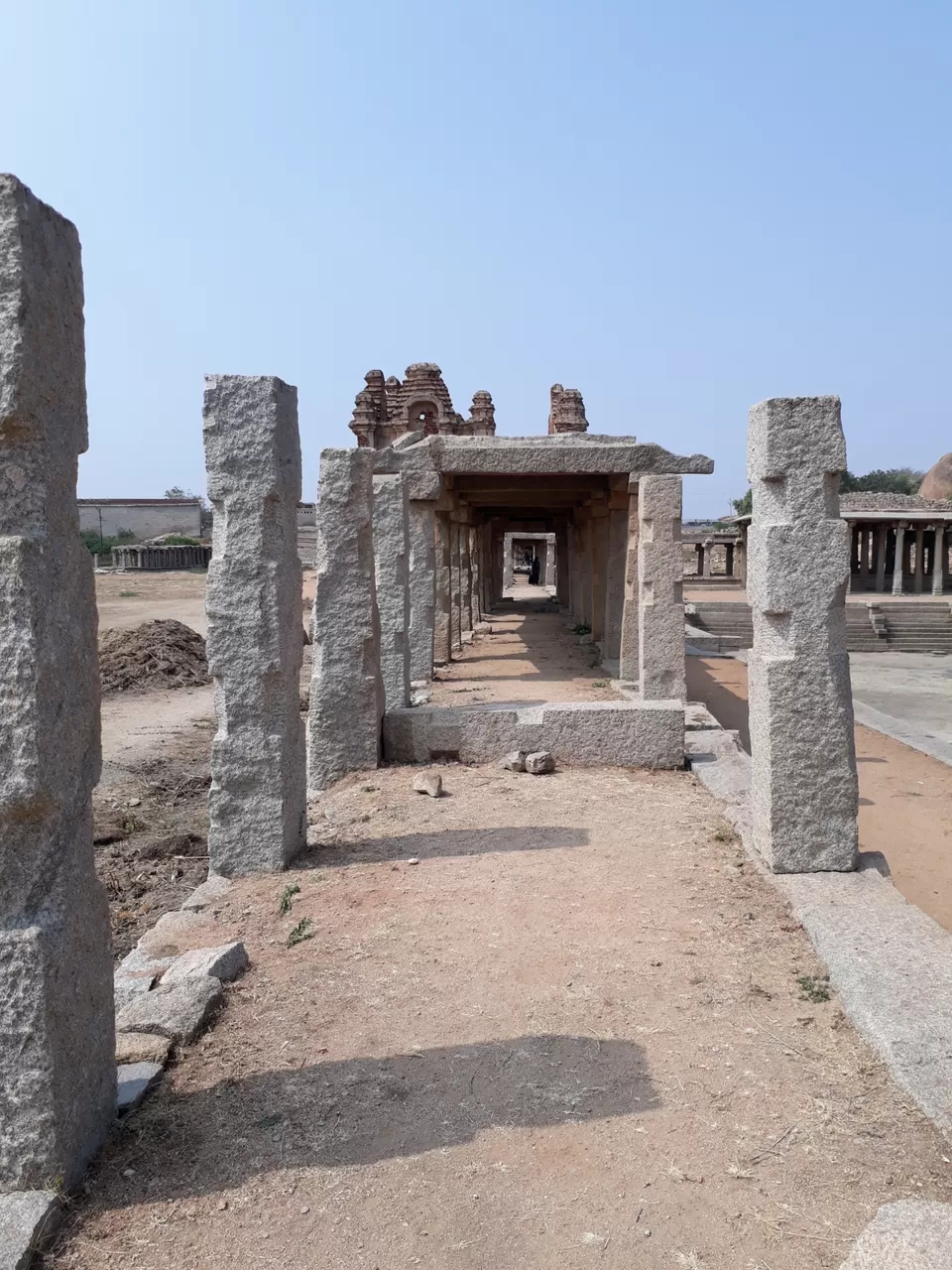
This temple was built by the king (Krishnadevaraya) in 1513 AD to celebrate the conquest of the eastern kingdom of Udayagiri or Utkala (in the present day Orissa state). The main idol installed in the temple was the figure of Balakrishna (Lord Krishna as infant). This idol is now displayed in the state museum at Chennai. A huge slab installed inside the courtyard of the temple states the story of this temple and the conquest of Ulkala. This is one of the must see sites in Hampi. The carvings are especially spectacular with the Yalis (the mythical lion) on the pillars and the entrances to the temple hall flanged with impressive carvings of elephant balustrades. Many small shrines and pillared halls adorn the campus. The temple kitchen is located at the south east of the main shrine. The main tower at the east is an impressive sight with numerous carvings on it (now the tower is under restoration work). You can see the carvings of the 10 incarnations of Lord Vishnu in this temple. This is one of the few temples where the epic stories carved on the walls of the tower. This is fairly an intact specimen of a Vijayanagara era temple. The main temple hall The main road to Hampi passes through the temple campus. You can spot a small pavilion with a rectangular stone container in front of the temple across the road. This was used to store grains for the ritual purpose in the temple festivals. The position and design of the vessel suggests devotees used to donate food grain as offering at the temple. The main temple hall Further east outside the temple you can see a long hall like structure. On the right (south) of it are the banana plantations. The left area is mostly a rocky landscape. This was actually the high street (the chariot street) once led to the temple called the Krishna Bazaar. The long pavilions were shops in the market street. If you walk along these long structures, you would reach the impressive temple pond called Kalyani , with structures around and at the middle of the tank. The temple tank is now not in use. The nearby agricultural places use water from the tank. The chariot street mentioned in fact terminates at a series of wide steps in front of the main temple campus, probably the only such chariot street in Hampi. Near the west gate of the temple campus you can spot a narrow passage leading to a large rectangular building. Made in Islamic style architecture this was probably a granary attached to the temple. A narrow flight of steps just behind the granary can give you access to the top for a vantage view. No admission fee. Photography OK, no fee!. You 30-60 minutes for this temple. Very easily accessible as this is located at the side of the main road. Visit this as part of your Hampi Itinerary Route-1 , on the way to the Lakshmi Narasimha Temple after the sightseeing at Hemakuta Hill. Ahead of the Krishna Temple is the Krishna Bazaar. A good sight of the topography of this temple can be had from the southern part of the Hemakuta hilltops.
Krishna Bazaar is a relatively newly excavated site in Hampi. As the name indicates this Bazaar is associated with the Krishna Temple. Basically this was the car street for the temple. The sacred tank (Pushkarni) of the temple too is located next to the Krishna Bazaar.
Unlike the many car streets associated with other large temples in Hampi, Krishna Bazaar is bit low laying with respect to the relatively elevated site of the temple. So you'll find a series of broad steps in front of the Krishna Temple to reach the bazaar street.
Thanks to the low laying terrain the whole bazaar got buried in silt over the time. This area later turned into thickets of banana plantations. Before the excavations it was impossible to tell that it was a marketplace once.
As you enter from the Krishna Temple side, you can see long rows of pavilions along the bazaar street. Also you'll see the excavated rubble bases of old structures and cobbled pathways.
A little ahead along the bazaar is the sacred tank. The interesting part of the tank is the small pavilion at its center and the many beautifully carved aquatic devices that is used to feed water to the tank.
A little off to the bazaar, facing the main road (to Hampi) and the Krishna Temple is a small pavilion with large rectangular box. This is carved out of a huge boulder and you can see a small rectangular opening at the top of this box. Devotees used to offer food grains during the functional days of this temple.
To visit Krishna Bazaar just cross the main road to Hampi after you've visited the Krishna Temple. You can also get a nice areal view of the Krishna Bazaar while climbing the Matunga Hill.
Presently the street doesn't lead to anywhere other than to the few local trails that go around the Matunga Hill or through the thick of the banana fields.
This temple was built by the king (Krishnadevaraya) in 1513 AD to celebrate the conquest of the eastern kingdom of Udayagiri or Utkala (in the present day Orissa state). The main idol installed in the temple was the figure of Balakrishna (Lord Krishna as infant). This idol is now displayed in the state museum at Chennai. A huge slab installed inside the courtyard of the temple states the story of this temple and the conquest of Ulkala. This is one of the must see sites in Hampi. The carvings are especially spectacular with the Yalis (the mythical lion) on the pillars and the entrances to the temple hall flanged with impressive carvings of elephant balustrades. Many small shrines and pillared halls adorn the campus. The temple kitchen is located at the south east of the main shrine. The main tower at the east is an impressive sight with numerous carvings on it (now the tower is under restoration work). You can see the carvings of the 10 incarnations of Lord Vishnu in this temple. This is one of the few temples where the epic stories carved on the walls of the tower. This is fairly an intact specimen of a Vijayanagara era temple. The main temple hall The main road to Hampi passes through the temple campus. You can spot a small pavilion with a rectangular stone container in front of the temple across the road. This was used to store grains for the ritual purpose in the temple festivals. The position and design of the vessel suggests devotees used to donate food grain as offering at the temple. The main temple hall Further east outside the temple you can see a long hall like structure. On the right (south) of it are the banana plantations. The left area is mostly a rocky landscape. This was actually the high street (the chariot street) once led to the temple called the Krishna Bazaar. The long pavilions were shops in the market street. If you walk along these long structures, you would reach the impressive temple pond called Kalyani , with structures around and at the middle of the tank. The temple tank is now not in use. The nearby agricultural places use water from the tank. The chariot street mentioned in fact terminates at a series of wide steps in front of the main temple campus, probably the only such chariot street in Hampi. Near the west gate of the temple campus you can spot a narrow passage leading to a large rectangular building. Made in Islamic style architecture this was probably a granary attached to the temple. A narrow flight of steps just behind the granary can give you access to the top for a vantage view. No admission fee. Photography OK, no fee!. You 30-60 minutes for this temple. Very easily accessible as this is located at the side of the main road. Visit this as part of your Hampi Itinerary Route-1 , on the way to the Lakshmi Narasimha Temple after the sightseeing at Hemakuta Hill. Ahead of the Krishna Temple is the Krishna Bazaar. A good sight of the topography of this temple can be had from the southern part of the Hemakuta hilltops.
5.BADAVILINGA TEMPLE
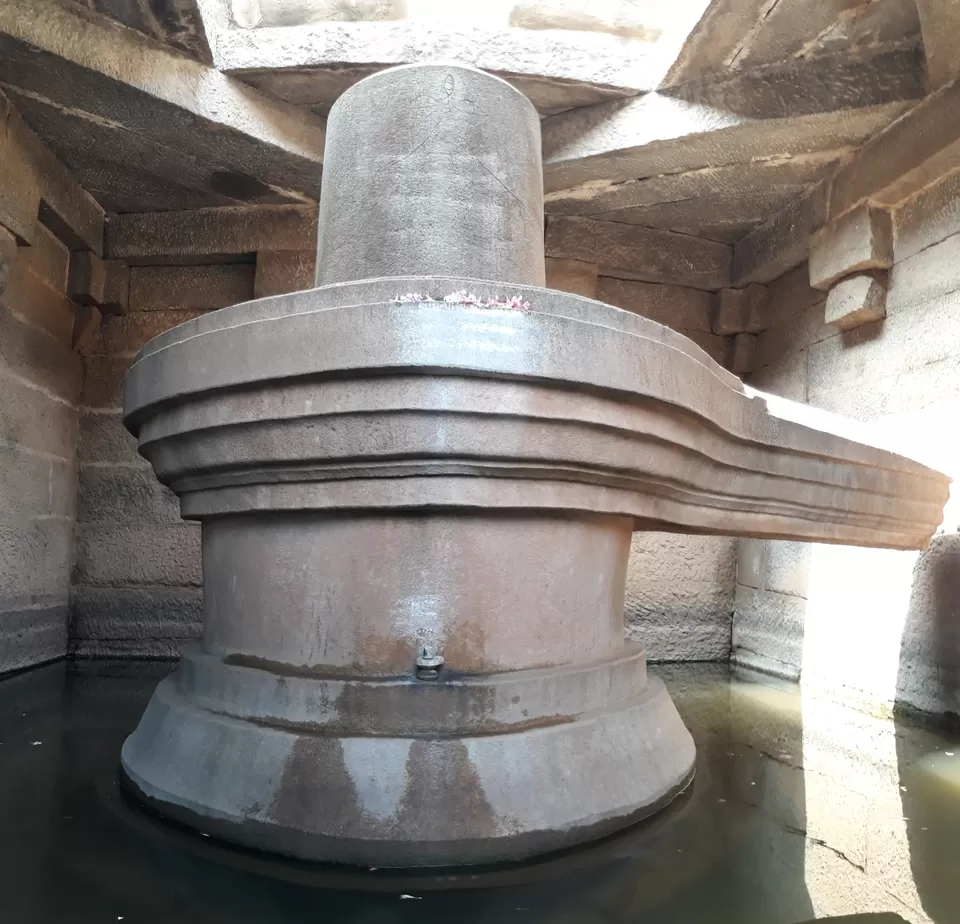
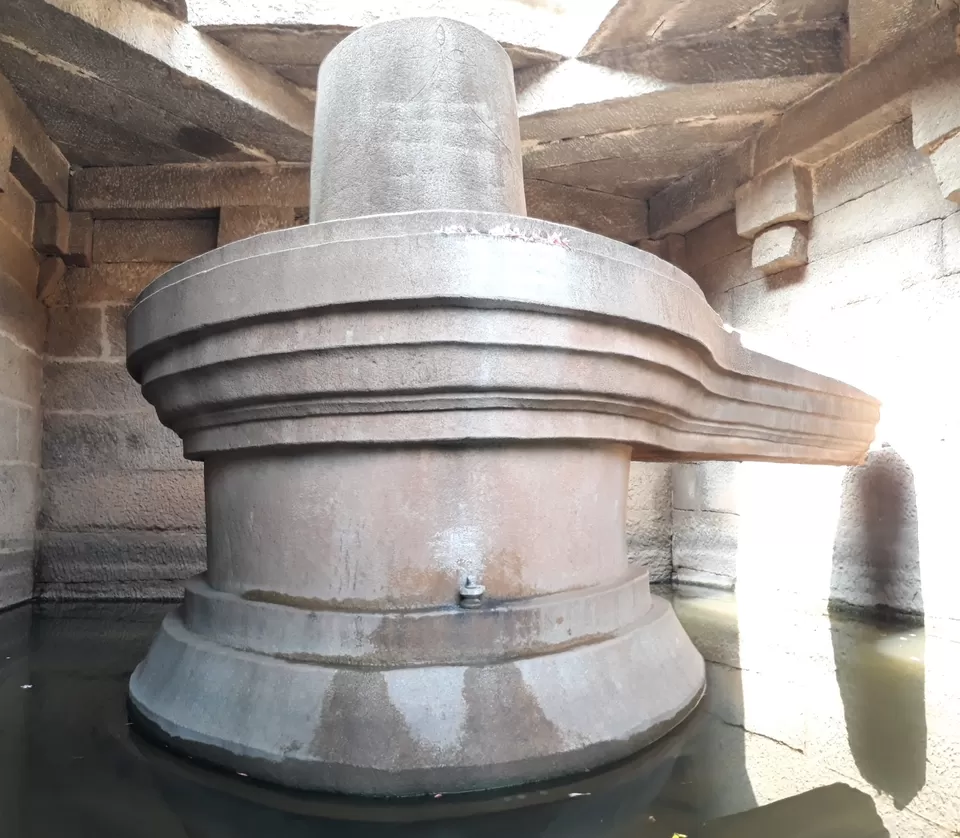
This is the largest Linga image in Hampi. Located next to the Lakshmi Narasimha statue the Linga is housed inside a chamber with an opening in the front. A close look on this icon can reveal three eyes (depicting the three eyes of Shiva) carved on it. Legend has it that this was commissioned by a peasant woman and hence the name (Badva means poor in local tongue). The sanctum in which the Linga is installed is always filled with water as a water channel is made to flow through it. According to Hindu mythology the River Ganga (Ganges) was brought from heaven to earth to quench the drought. But the river was so forceful that it could split the earth into two pieces if allowed to fall on earth. Lord Shiva consented to take the impact by allowing the torrent of Ganga to fall on his matted hair. Thus helping to release a smooth flowing river on to earth from his hair. As an iconic representation of this, in Siva temples you can spot a dripping pot hanged over the Linga. (see also Gods of Hampi) Both Lakshmi Narasimha & Badavi Linga shrines can be visited together. Photography allowed and no entrance fees to visit
6.LAXMI NARASIMHA TEMPLE
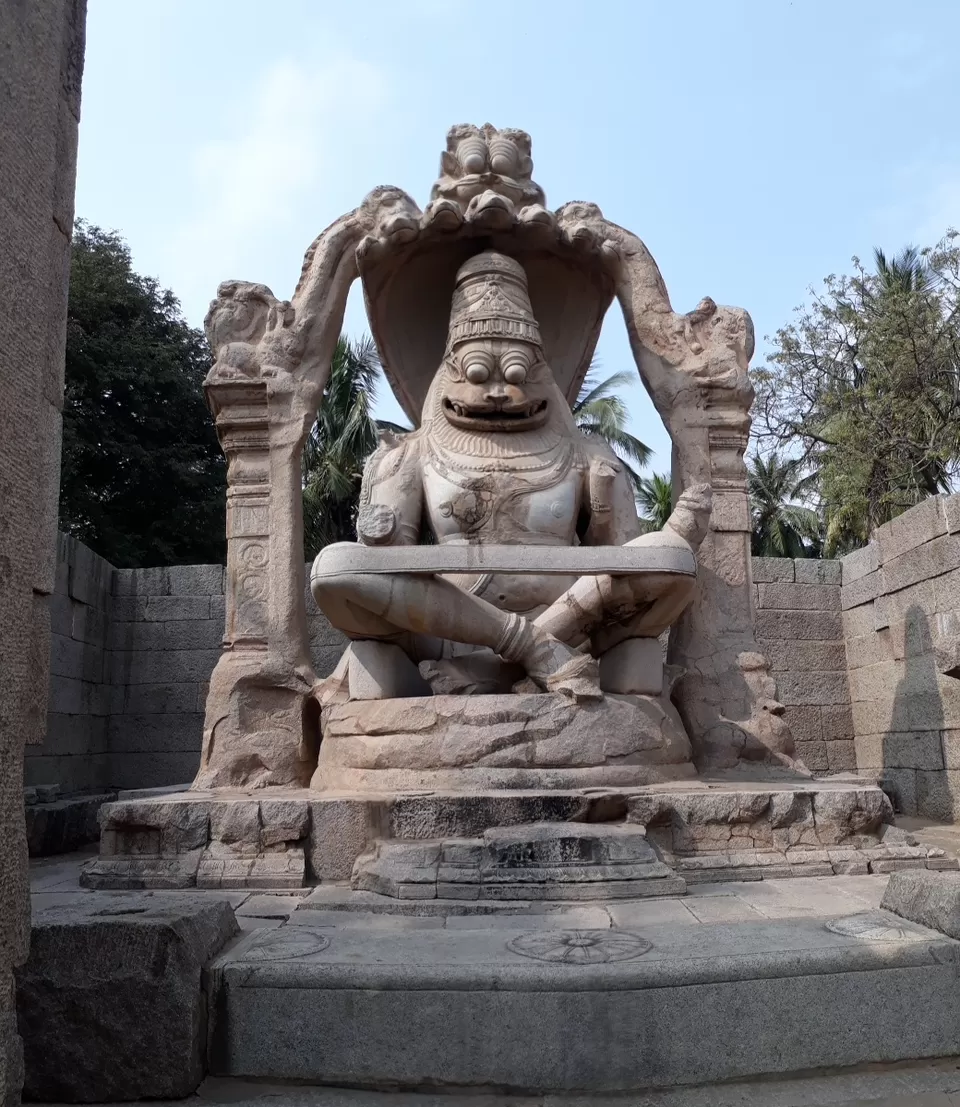
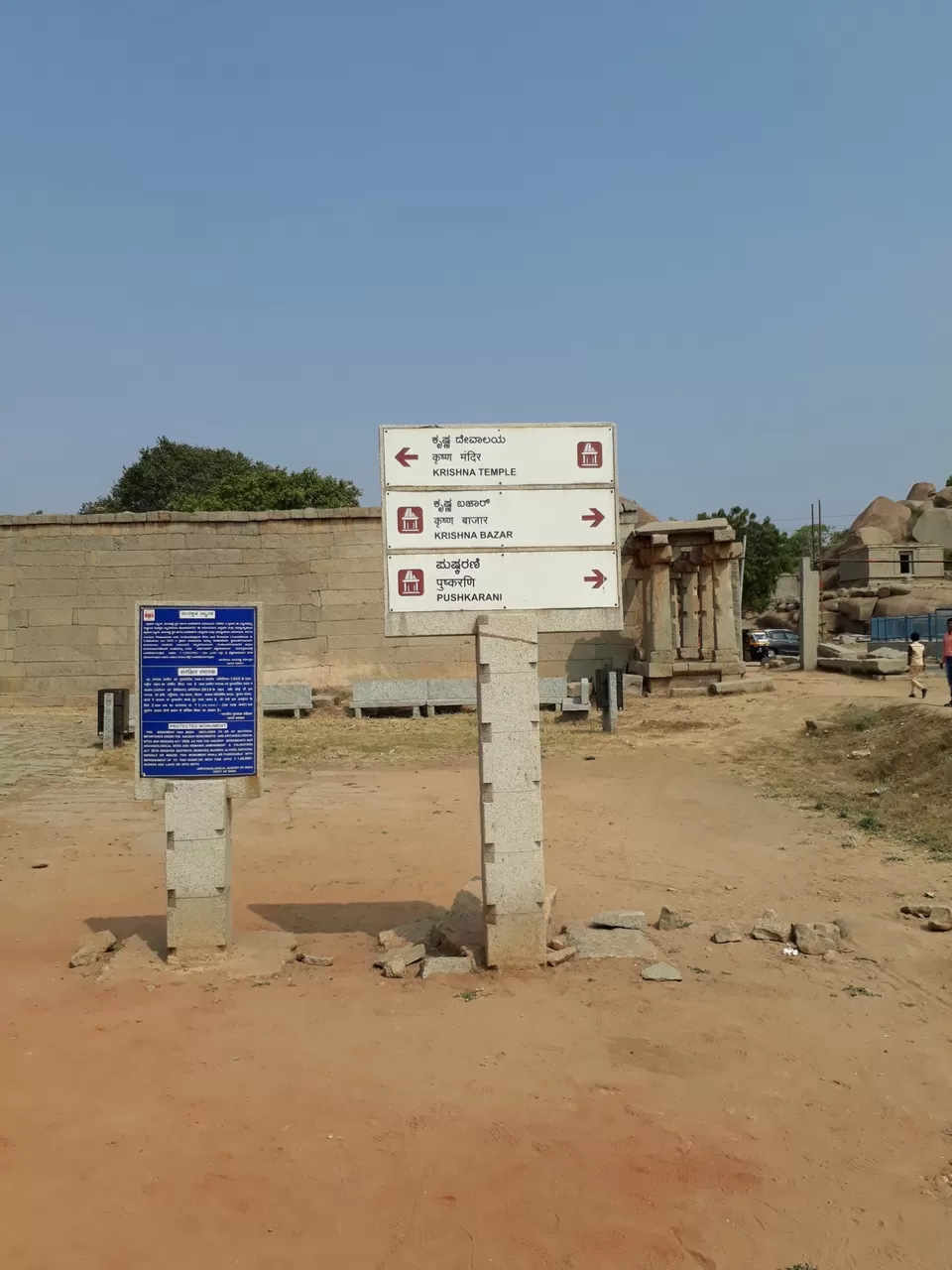
This is the largest statue in Hampi. Narasimha is sitting on the coil of a giant seven-headed snake called Sesha. The heads of the snake acts as the hood above his head. The god sits in a cross-legged Yoga position with a belt supporting the knees. Sometimes this is referred as Ugra Narasimha (i.e. Narasimha in its terrifying form). The protruding eyes and the facial expression are the basis for this name. Narasimha (means half-man’half-lion in local the languages) is on of the ten incarnations (avatar) of Lord Vishnu. The original statue contained the image of goddess Lakshmi, consort of the god, sitting on his lap. But this statue has been damaged seriously during the raid leading to the fall of Vijayanagara. Even the damaged portion of such a large statue of Lakshmi carved on his lap is missing. Probably it may be laying around in tiny pieces. But the goddess’s hand is visible resting on his back in embracing posture. If you get a chance to go inside this enclosure, it is possible to see the hand of the goddess. Even the nails & the rings on her fingers are so perfectly executed. Lion face of Lakshmi Narasimha also sometimes called as Unganarasimha (the ferocious Narasimha) Somehow this single statue alone can demonstrate at the same time how creative and destructive the human mind can be. The Hindu mythology has a tale of Narasimha’s origin. See the story of Narasimha. You can reach this spot by the main road. The shrine is located at mid way of the main road that connects the Sacred Center to the Royal Center. About 200 meters south of the Krishna Temple (take the road that runs through the arch) you can spot a small canal crossing the road. An unpaved path at the right side (towards west) leads you to the Narasimha statue and the Badavilinga Temple next to it.
7.CHANDIKESHVARA TEMPLE
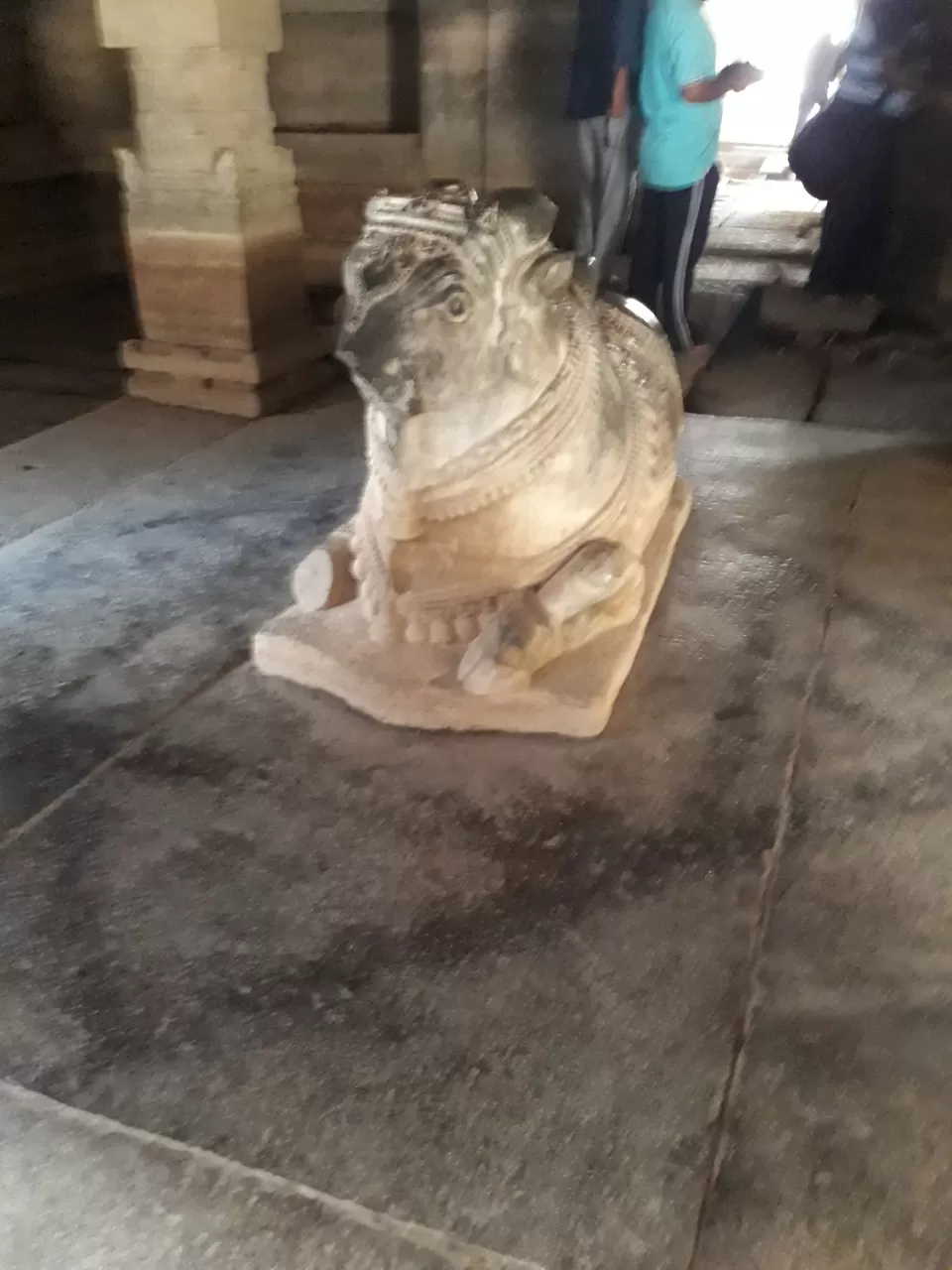
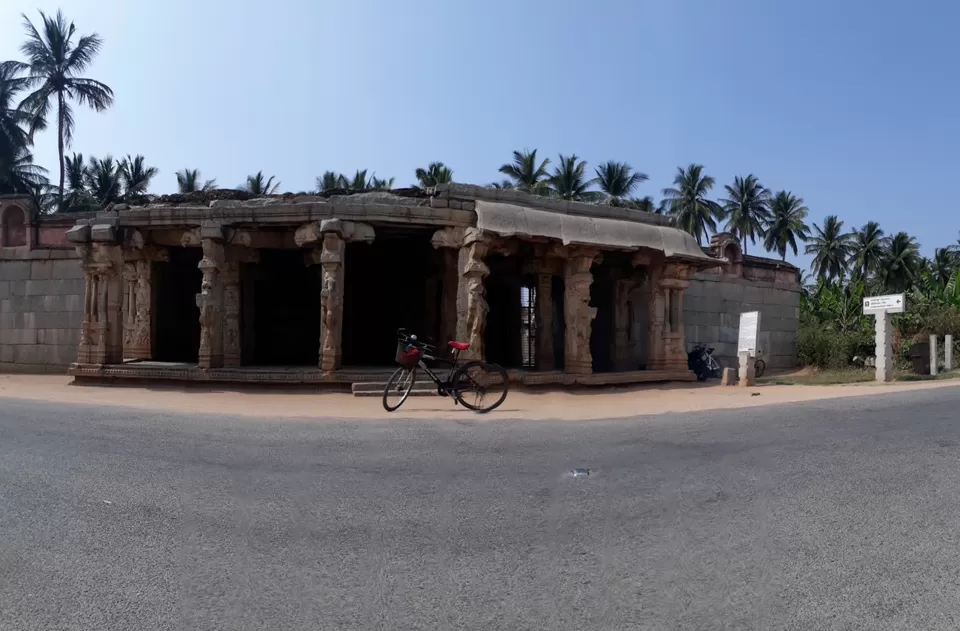
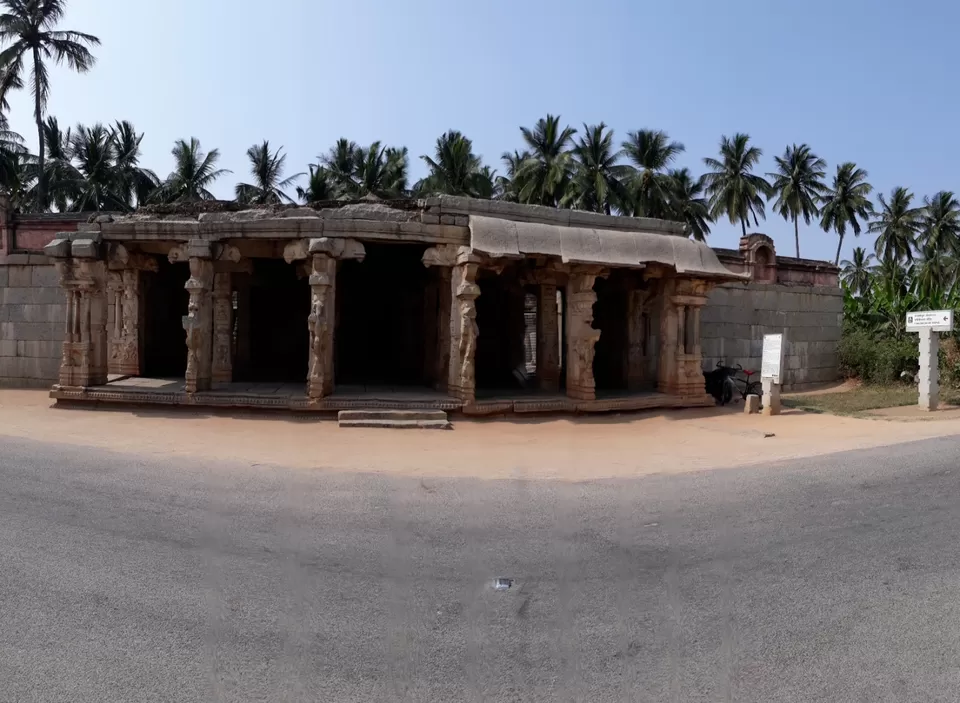
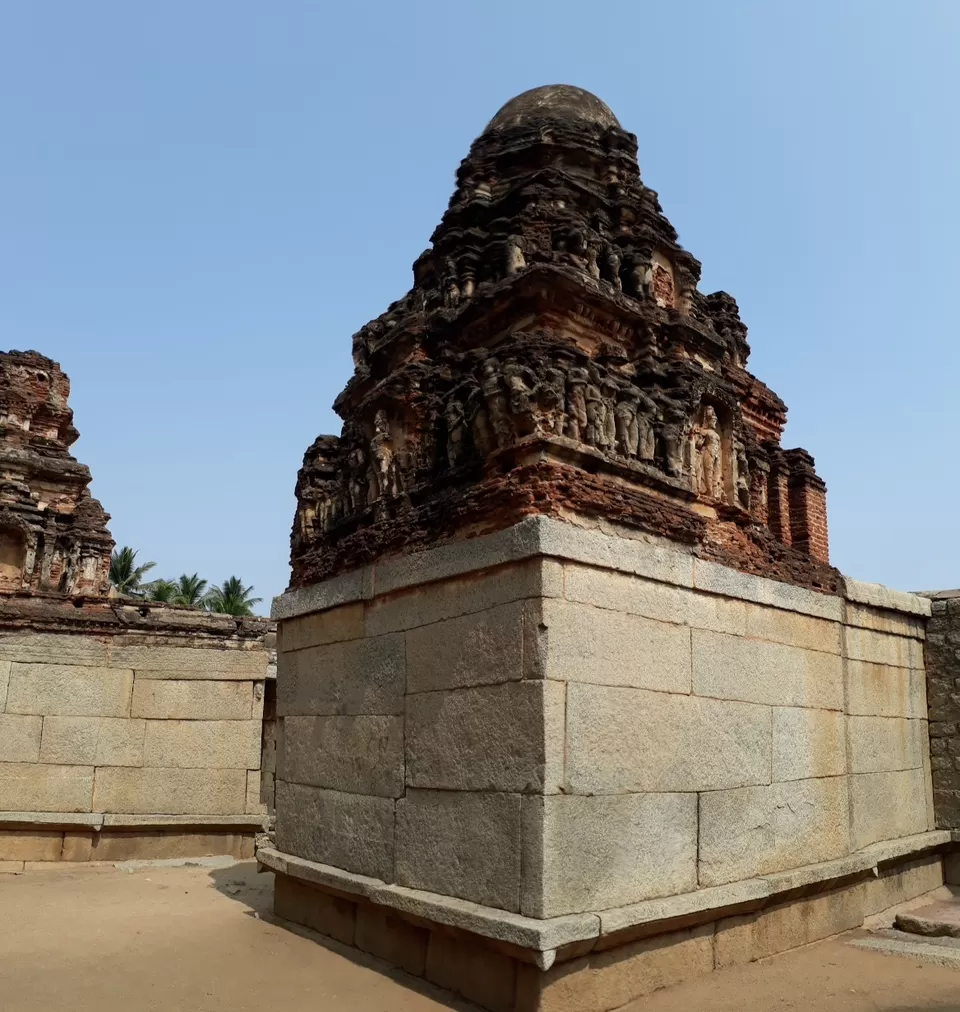
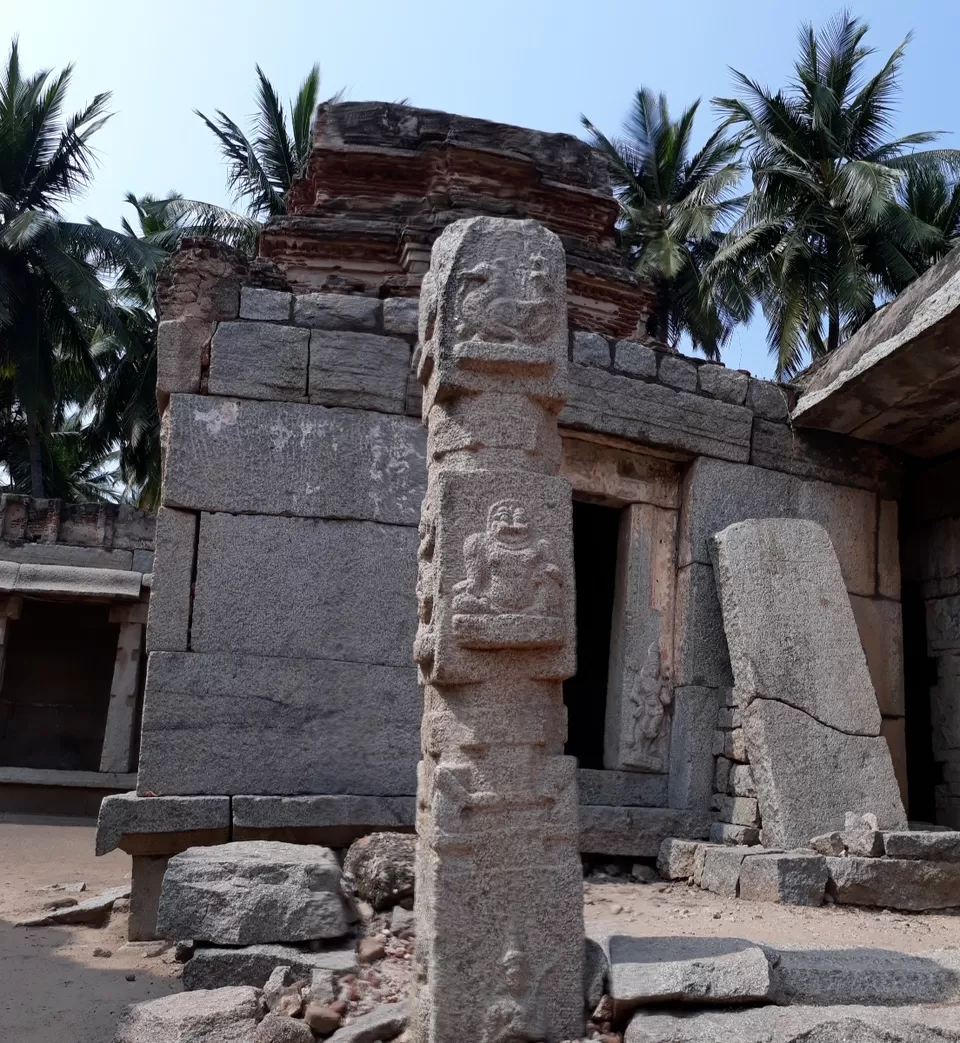
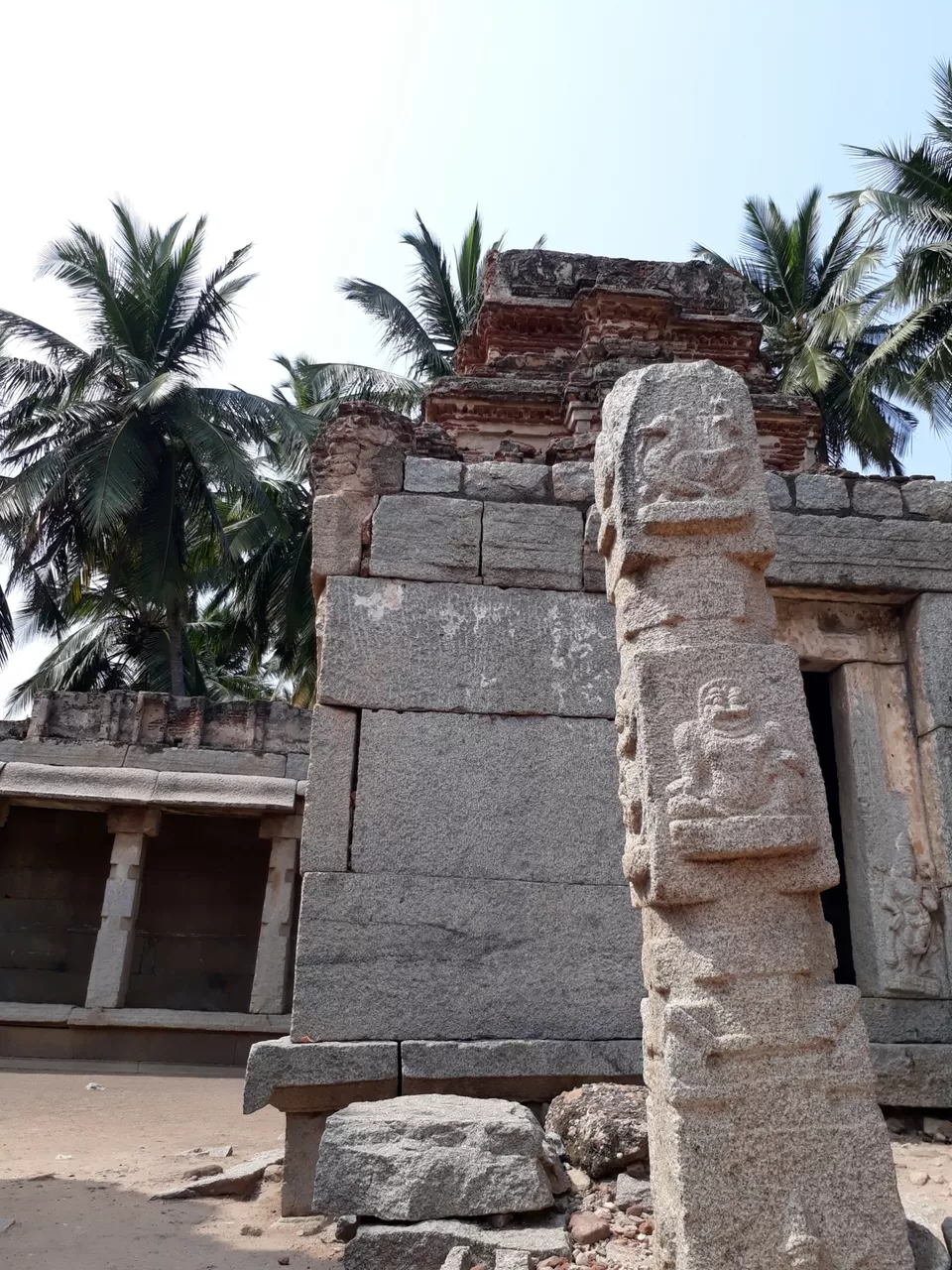

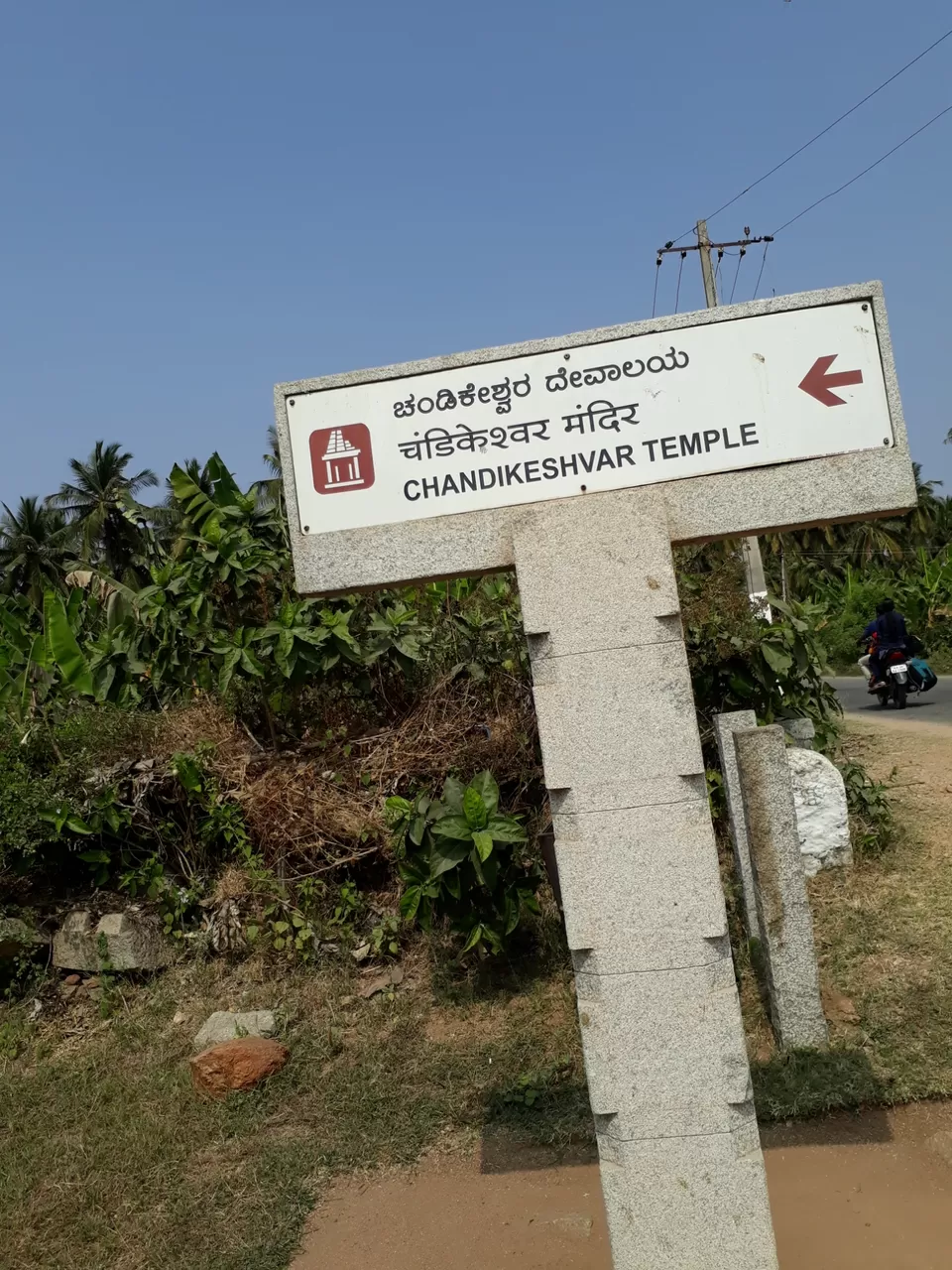

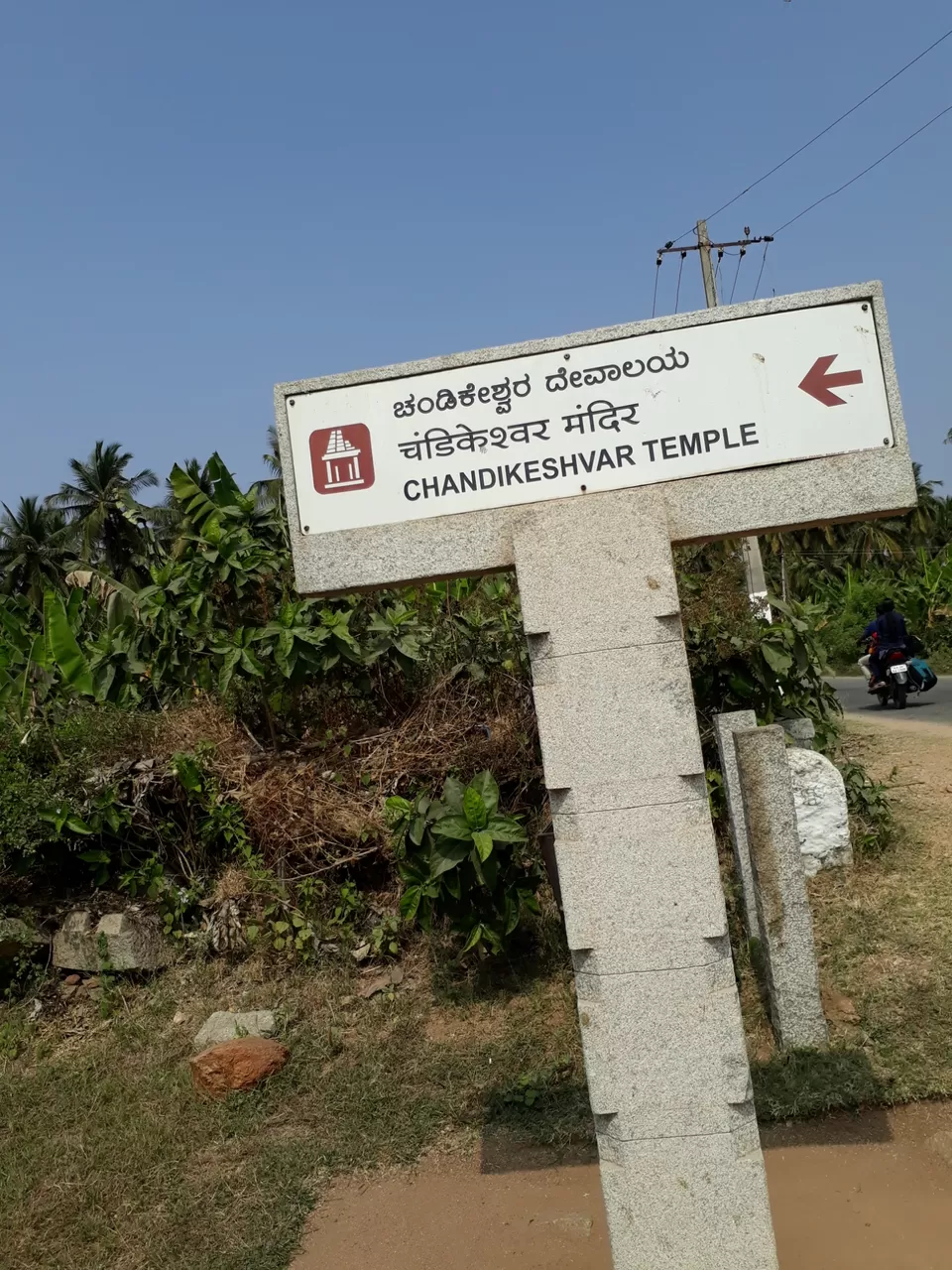
Chandikesvara Temple in Hampi is a top notch temple widely recognized for its superb architecture. It became constructed in the course of the period of the Vijayanagara Empire. The temple is located in Hampi. The lovely temple is dedicated to the Hindu deity Lord Vishnu. It is one of the principal instances in Hampi and is visited by way of a big range of vacationers through the year. The incredible architecture of the Chandikesvara temple makes it one of the most appealing temples in Hampi. Like numerous different structures in Hampi, the Chandikesvara temple showcases the Vijayanagara fashion of architecture. The Chandikesvara temple stands within a small compound and has a big corridor placed at the front of the shape. The most interesting part of the temple's architecture is the richly carved pillows standing in the front hall. Each pillar is a notable piece of structure in itself. Each pillar has been crafted out of huge stones in an impressive manner. The pillows depict various issues from the Hindu mythology and are a treat for the site visitors
8.UDDANA VEERABHADRA TEMPLE
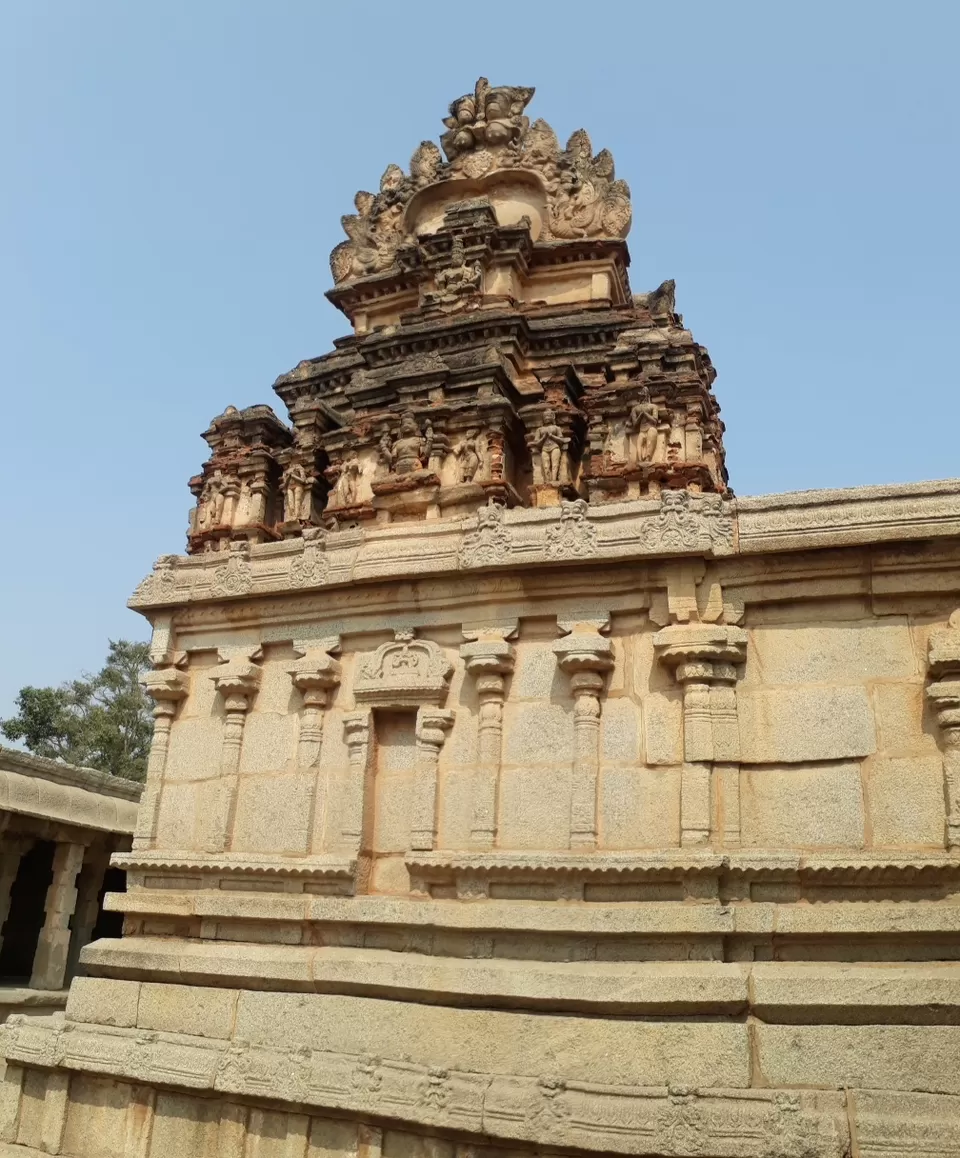
This is a small but religiously prominent temple in Hampi. There are many tales in the Hindu mythology about of the origin of the cult deity Veerabhadra and the cult associated with the worship.
Sati, the daughter of the King of Gods, Daksha, marries Lord Shiva against the king's wishes. He considers Lord Shiva as dirty, roaming ascetic who wears funeral ash and snakes on his body. On a special occasion (a ritualistic sacrifice) the king invites everyone including the gods and sages but except Sati and Shiva. However she attends the function and Daksha insults her and sheds abuses over her husband in front of the guests. Unable to stand the humiliation, Sati suicides by jumping into the sacrificial fire at the venue.
On hearing the news of his consorts death Lord Shiva gets furious at Daksha. He rips off a piece of his matted hair and throws on to the ground in anger. The furious demon god Veerabhadra and goddess Kali appears out of this. This unleashes terror at Daksha's place and finally he gets killed. Terrified at Lord Shiva’s furry, the gods appeal to him for mercy. Shiva offers to restore Daksha's life by replacing the head of the first animal he encounters. He finds a goat. Daksha comes back to life with the goat's head. Daksha turns into one of Shiva's devoted attendants. It’s believed that Veerabhadra is an incarnation of Lord Shiva himself and Kali as his consort. In the later incarnation Sati becomes Parvathi (Pampa) and remarries Shiva.
Hampi ruins have left behind ample evidences of the existence of this cult (who worship gods in it’s furious forms) as against the sober gods of Vaishnavites (those worship various incarnations of Lord Vishnu). Probably the Veerabhadra Temple, also called Muddu Veeranna in the local tongue, has a history as old as the Virupaksha Temple on the bank of the river.
The 3.6 meter high monolithic idol of Uddana Veerabhadra is the main deity here. The idol is carved with four arms holding an arrow, sword, bow and shield, depicting the warrior nature. A tiny idol of Daksha too is placed nearby. The twin superimposed Linga (called Sarvanga Linga ) installed at this temple is unusual for its form .The priests of this temple are of Lingayath community (a deviation from the tradition – the Brahmin community) This is not a touristy place per se. Observe the usual etiquette deemed for a temple. Photography is not allowed inside the temple. This whitewashed temple is located near the main road midway between the Sacred Center and the Royal Center. About half kilometer southward of the Krishna Temple, you can see this temple practically facing the road and the main road passes between the temple compound and the tall monolithic lamppost in front of it. The main road in fact takes a sharp bend around the temple before proceeding further south. Just under the lamppost you can spot a Sati Stone, the memorial of wives who killed themselves after their warrior husband’s death in battle. Also you can see a tiny shrine dedicated to Hanuman next to the lamppost. Opposite to Uddana Veerabhadra Temple is the Chandikesvara Temple.
9.AKKKA TANGI GUDDU
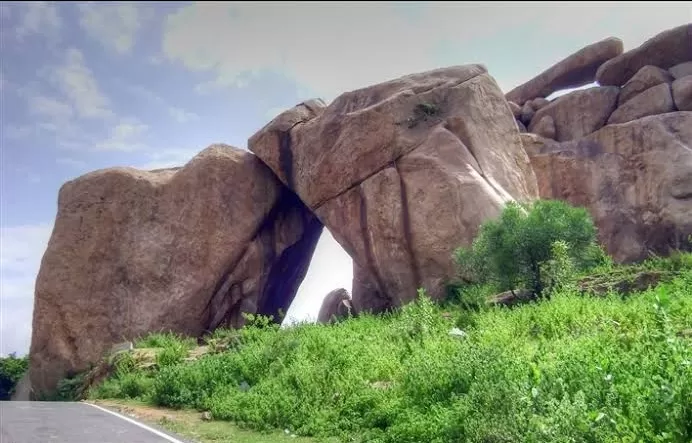
These are two giant boulders leaning against each other, making an archway like formation. You can find them on the left side of the main road when you go from the Underground Shiva Temple towards Hampi village square. The road almost passes through under the stones. Akka-Thangi Gudda means ‘sister stones’ in the local language. There are many variants of the local folklore how these boulders came into existence. According to one such has it that these they were two sisters and they became stone as a curse when they ridiculed the place. In the recent past one of the boulders developed a fissure and partly collapsed. It's attributed to the increased vehicular traffic that passes by these twin boulders.
These are two giant boulders leaning against each other, making an archway like formation. You can find them on the left side of the main road when you go from the Underground Shiva Temple towards Hampi village square. The road almost passes through under the stones. Akka-Thangi Gudda means ‘sister stones’ in the local language. There are many variants of the local folklore how these boulders came into existence. According to one such has it that these they were two sisters and they became stone as a curse when they ridiculed the place. In the recent past one of the boulders developed a fissure and partly collapsed. It's attributed to the increased vehicular traffic that passes by these twin boulders.
10.UNDERGROUND SHIVA TEMPLE
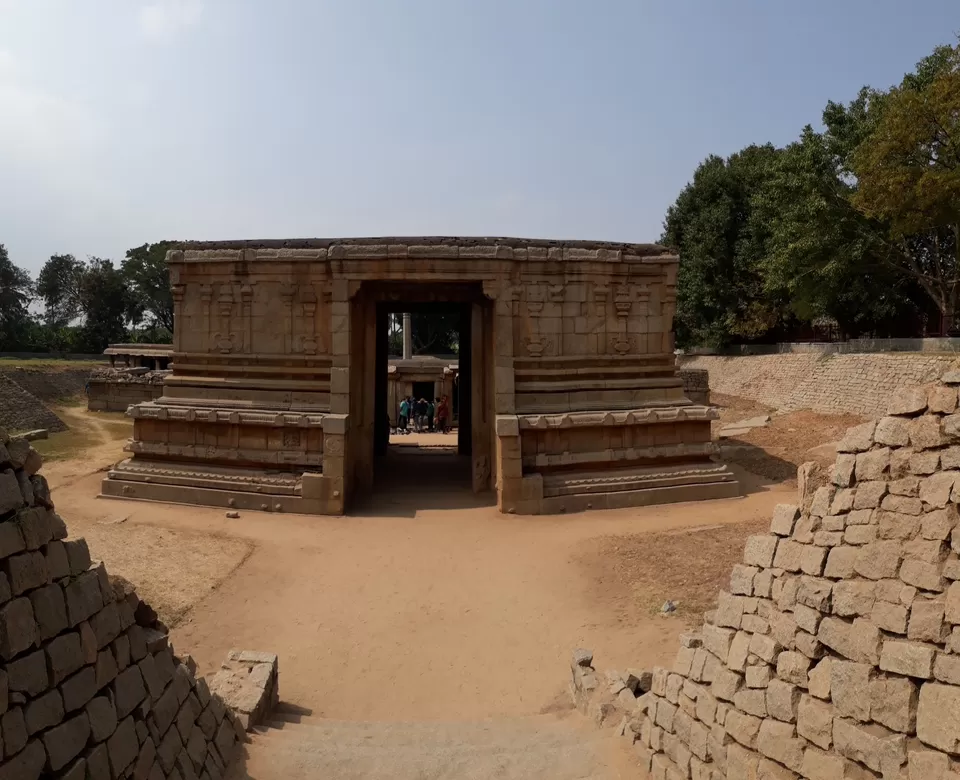
For some curious reasons, this temple dedicated for Lord Siva was built many meters below the ground level. For this reason, almost all the time the sanctum and the core parts of the temple are under water, restricting entry to the inner areas.
A water canal system too is visible around the main temple. But this canal is dry and you can walk down to a point from where it’s impossible to go further. There is a small temple for Siva’s consort too near the mail shrine. The Kalyanamantapa (ceremonial marriage hall) is a great looking structure. It has been believed that this is one of the oldest temples in Hampi.
View of the main hall in front of the shrine. The main tower too can be seen Your entry to the temple passes through the main tower in front of the temple campus. It looks like this tower was an addition done later on and was never completed. A series of wide large steps along the axis of the tower and the sanctum leads you to the inner part of the temple. The main hall in front of the shrine is huge with massive cubical pillars supporting the roof. The lamppost actually protrudes through the roof. Depending upon the water level you may be able to proceed to the sanctum area.
There is a beautiful lawn built around the temple. Usually a less crowded location, the outside (and to some extend the top portions) of this temple you can survey by going around this lawn.
The Underground temple is located somewhat close to the main road (to Hampi bus station) and near the Noblemen’s Quarters. A byroad going towards the Hazara Rama Temple passes through this area.
No admission fee. Reserve about 30 minutes to explore the temple. Temple closes in the evening. A man sells soft drinks and bottled water usually setup his kiosk in front of this temple. Otherwise you would not find any such stalls in this locality
11.NOBLEMANS QUARTERS
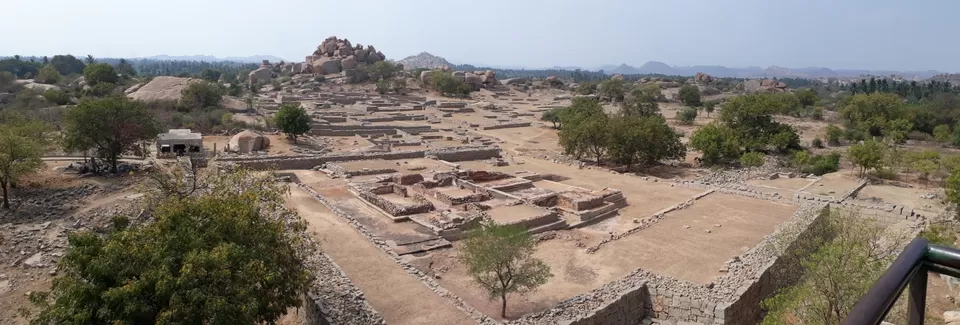

This is where the aristocrats of the Vijayanagar lived. The ruins of the foundations spread out over a valley among the foot of small rocky hills. What you notice is the simplicity of the structures. Most of the residential quarters are rectangular in shape and set systematically. Compound walls separated the houses and some of them are attached with horse stables. A few of the bases of the houses are much elaborate than the rest. For example they were built in the multi-layered fashion, much like in the palace base. It’s believed that the high ranking officers and the military commanders lived here.
Apart from walking around among the foundations, climbing the nearby tall rock to get a general view of the area is not a bad idea. This obviously noticeable rock is located just east of this area with steps are hand railings to aid climbing. Though not as close, another options is to survey the area from the top of the nearby Mohammadan Watch Tower.
You can make a side trip to the Noblemen’s Quarters either on your way to the Underground Temple or to the Danaik’s Enclosure. The quarters are located along the north side of the mud road that connects the temple and Danaik’s Enclosure.
No entrance and camera fees applicable. A visit can take anything from a few minutes quick glimpse up to an hour or so, depends on how this place inspires your curiosity.
12.MOHAMADDAN WATCH TOWER
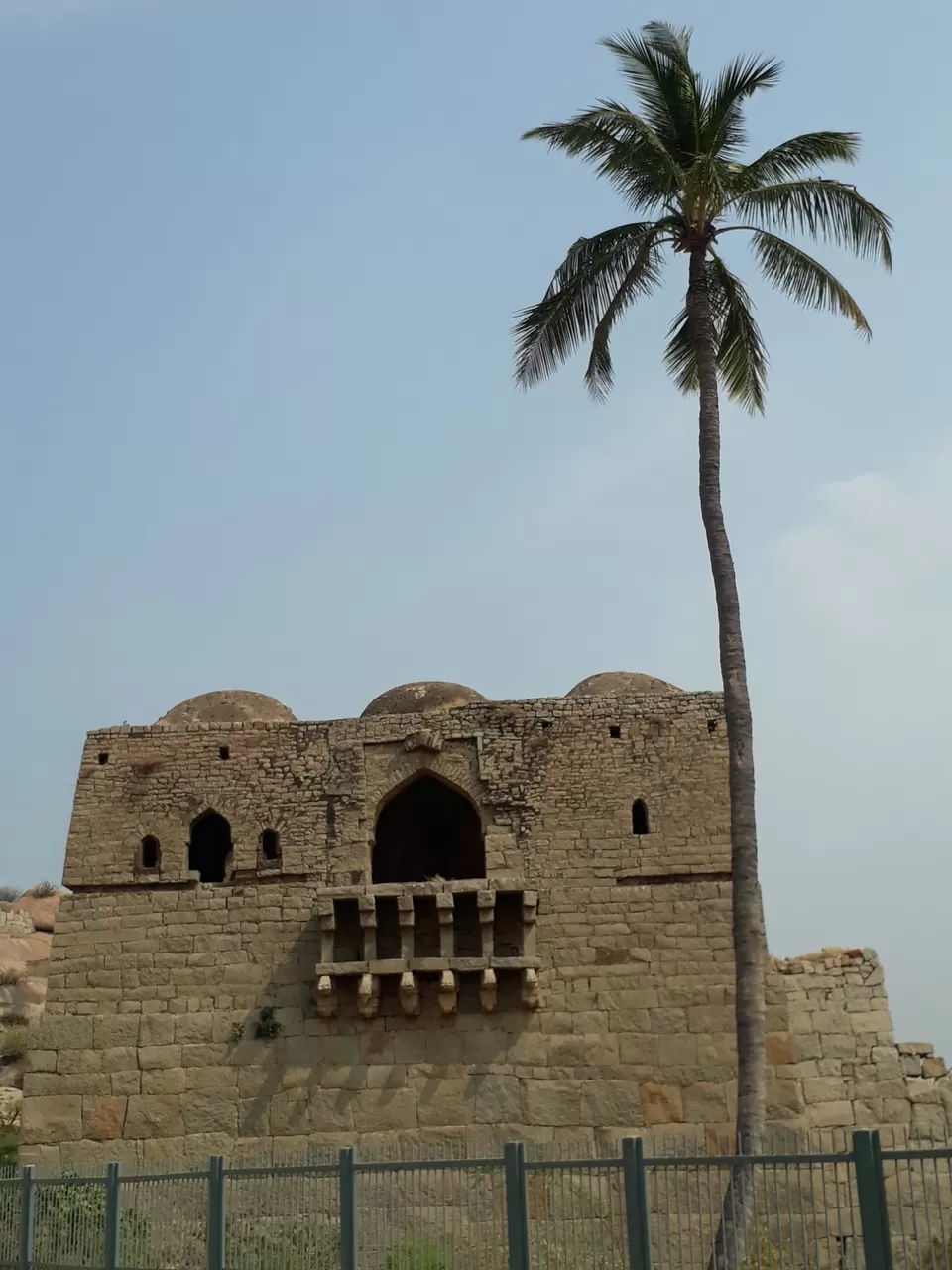
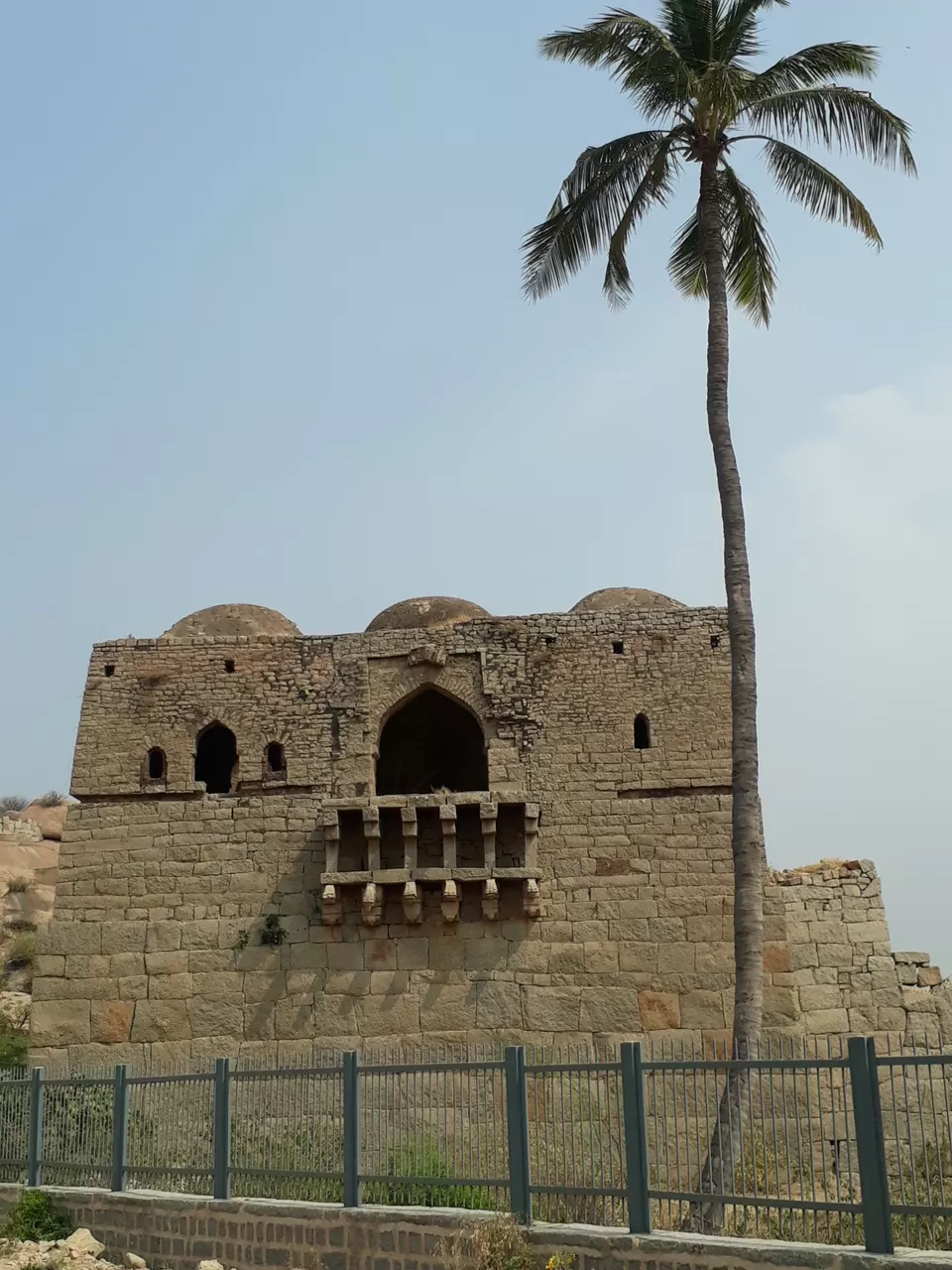
This is the largest and most detailed of all watchtowers among the Hampi ruins. Over looking the Noble Men’s Quarter, the primary intent of the watchtower was to guard the Danaik’s Enclosure. This is the first structure you would notice at the Danaik’s Enclosure on approaching from the Underground Temple. Mohammadan Watch Tower heralds the northwest corner of the Danaik’s Enclosure. A balcony of the watchtower projects to the mud path that passes around the corner. However you need to go through the entrance of the Danaik’s Enclosure wall at the north to access the watchtower.
Watch Tower A narrow stairway at the south gets you to the top floor. The domes made of rock and plastered together are of interest. The projecting balconies are decorated with supporting corbel brackets (seen from outside).
The ruins of the remaining two watchtowers of this enclosure are located at the southwest and the northeast corners of the compound.
13.PALACE OF KRISHNADEVARAYA
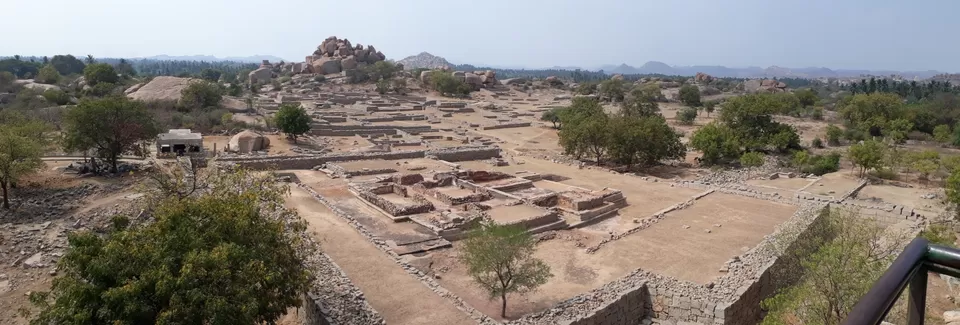

Place of Krishnadevaraya in Hampi. This is located in the Royal Center. You can also spot an exclusive pathway from the south of the Hazara Rama Temple that connects to the palace enclosure
14.GRANARIES
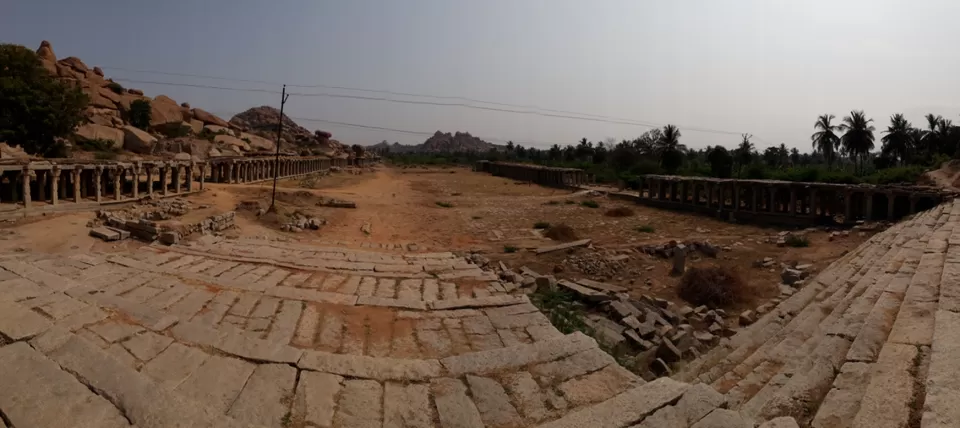
Numerous structures and artifacts related to food grain storage have been identified at various locations in Hampi. Some of them have been associated with the temples whereas a number of them have been non-religious in nature.
The remains of a few granaries can be seen scattered near the east of the Hazararama Temple area across the mud track. This is a bit off mud track that can take you to the Hazararama Temple and the Danaik’s Enclosure. The mud track runs east-west direction along the northern boundary of the Danaik’s Enclosure. Close to the northeast end of the Danaik’s Enclosure it takes a tentative right bend towards south before straightening back to the eastward direction. A bit further it join the T-junction. North (at the left) of the said bend lies foundations of the granaries.
A couple of them are circular in shape. The rest are all of cubical. The cubical ones are set in an array of identical rows.
The area north east of this is believed to been the quarters used by the royal guards. The granaries here support this assumption.
This again is a less frequented place by the visitors. Nevertheless it’s one of those spots you can make a quick side trip to without much strain on your main itinerary
15.BAND TOWER
You visit the Band Tower as a part of the Danaik’s Enclosure tour. This is one of the few tall structures than can be spotted from a distance within this large compound. The Band Tower stands near to the south wall of the enclosure between the basement of the palace and the Mosque. A southward long narrow trail from the Mohammedan Watch Tower leads to the Band Tower. The path along the thorny ground is less trodden.
This two-storied hexagonal structure has its narrow stairways at the northeast side. The lower portion has arched walls joining the pillars around. The upper story has alternate arch and rectangular windows. The dome is multi layered like that of the temples.
Like many other structures among the ruins, the name probably doesn't suggest the erstwhile function of this building. According to archeologists in all probability this would have been a watchtower than a band tower.
To the immediate east of this you would find the three-sided Mosque structure.
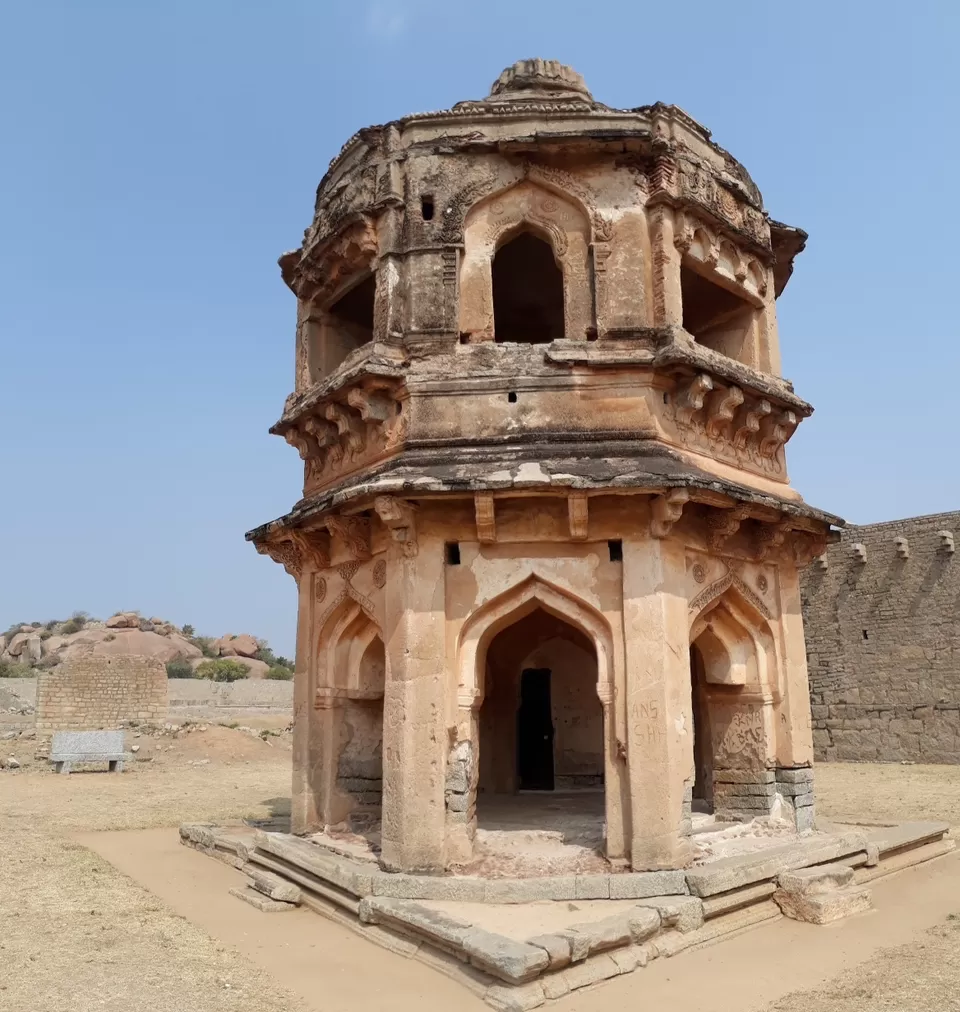
16. MOSQUE
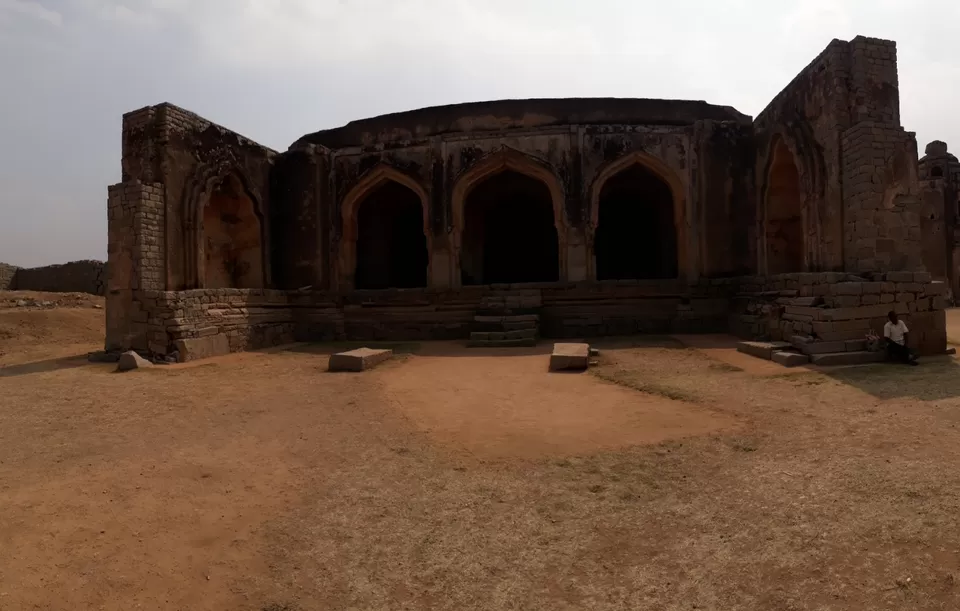
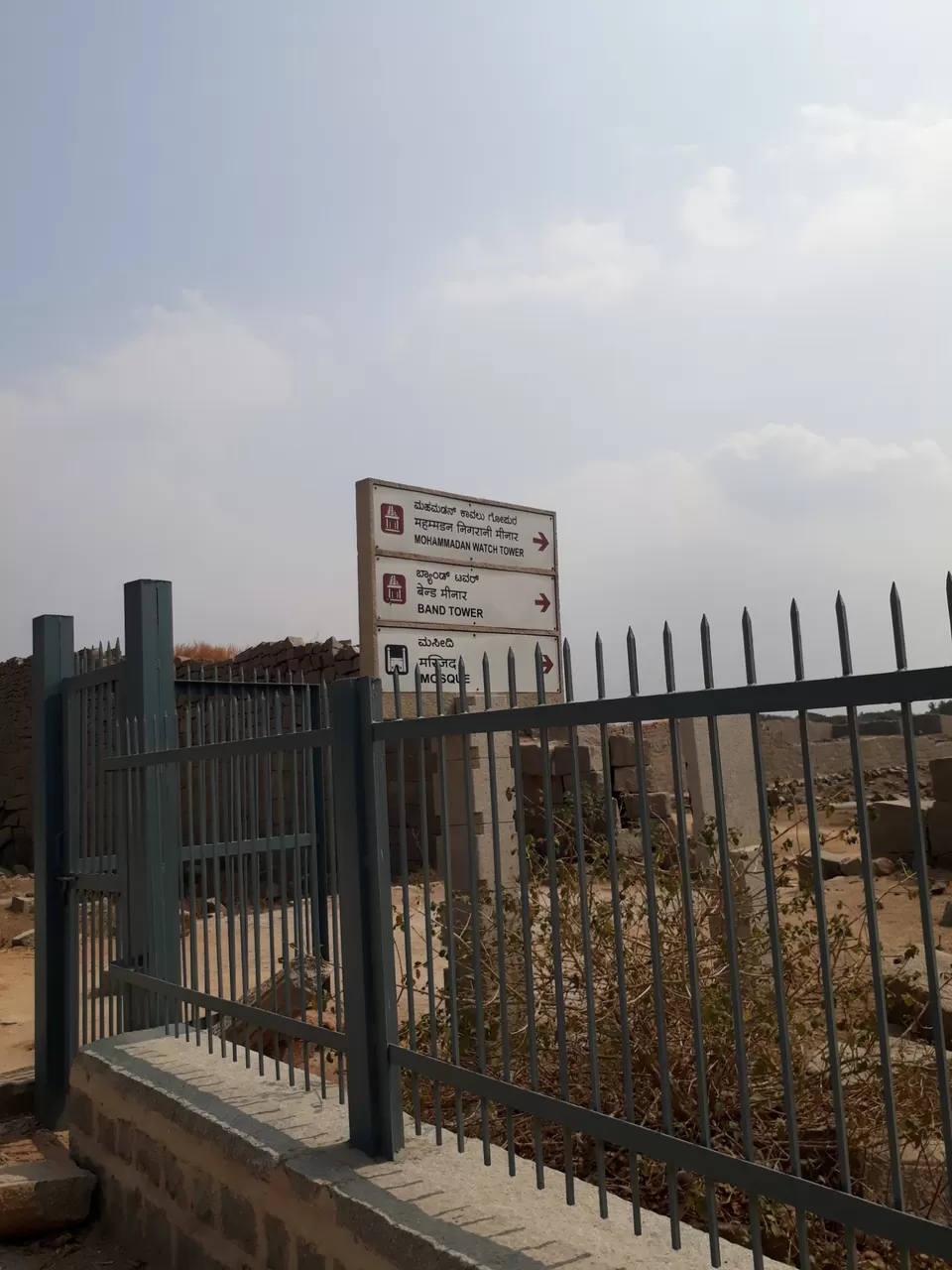
Yet another mysterious building in Hampi!
The archeologists are still debating the name and the implied purpose of this building. 'The Mosque' is one of the largest standing structures located inside the Danaik’s Enclosure. The long tall building is covered on three sides.
This north facing structure with multiple arches looks like a big stage.
The Hindu motifs on the plastered walls suggest it might not have been a Mosque. This too is a building made in the hybrid Indo-Islamic style. However this is popularly known as the Mosque.
The ruined east and west side projections are suggestive of a compound wall hem the open hall like structure of the Mosque. Being built on a high platform, a few steps in the front can take you to the top of the hall.
Visit this as part of the Royal Center tour (detailed in Route 3 of Hampi itinerary map). You'll also see a number of other attractions in the same enclosure (Dannayaka Enclosure), like the Band Tower, the Watchtower, basement of many palaces and so on. From this area you can easily head to the Royal Enclosure where you'll see a plethora of platforms and aquatic structures.
17.HAZARA RAMA TEMPLE
The first thing comes to mind on seeing this temple, or more precisely its walls, is the locally popular comic strips of Hindu mythology, Ramayana. But the difference is, the stories are carved, in long arrays, onto the walls of this temple.
This is not a huge temple by Hampi’s yardstick. But this temple at the heart of the royal area has some peculiarities. Firstly it had been functioning as a private temple for the king, or at the most, the royal family. The importance of this temple can be judged from its nodal location in the royal area. Your paths to various locations within the citadel concur at a corner of this temple.
Probably this is the only temple in the capital with its external walls decorated with bas-reliefs mentioned above. And the temple got its name Hazara Rama (a thousand Rama) Temple owing to this multitude of these Ramayana panels on its walls.
A sprawling lawn located at the north of this temple is an easy landmark you can spot from a distance. The dusty path that connects the Royal Enclosure with the Zenena Enclosure passes along the temple courtyard. Also the path from Danaik’s Enclosure and Underground Shiva Temple joins this path at its northeastern corner.
So any itinerary you chalk out for this area, you would come across this temple in one way or other. Look for the signpost installed in front of the temple, across the path, can give you direction to the Pan Supari (Beatle nut) Bazaar. This northeast oriented trail from the temple courtyard pass through a packed but shattered cluster of structures. These associate shrines, pavilions, lampposts and the likes once decorated the main path to the temple. You go further a little along the same trail to reach the sunken Pattanada Yellamma Temple and the Ranga Temple beyond it.
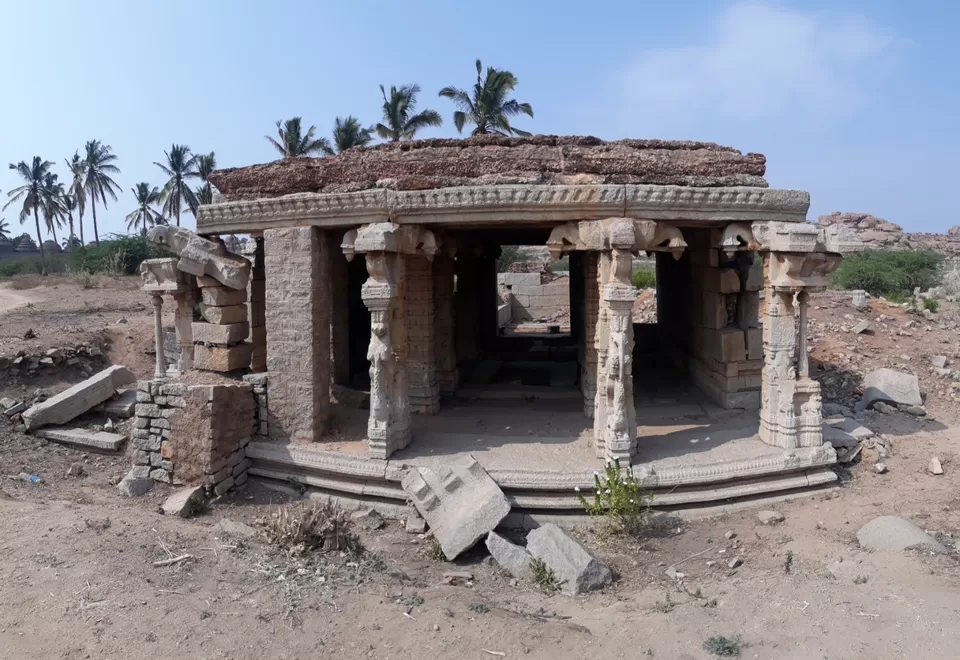
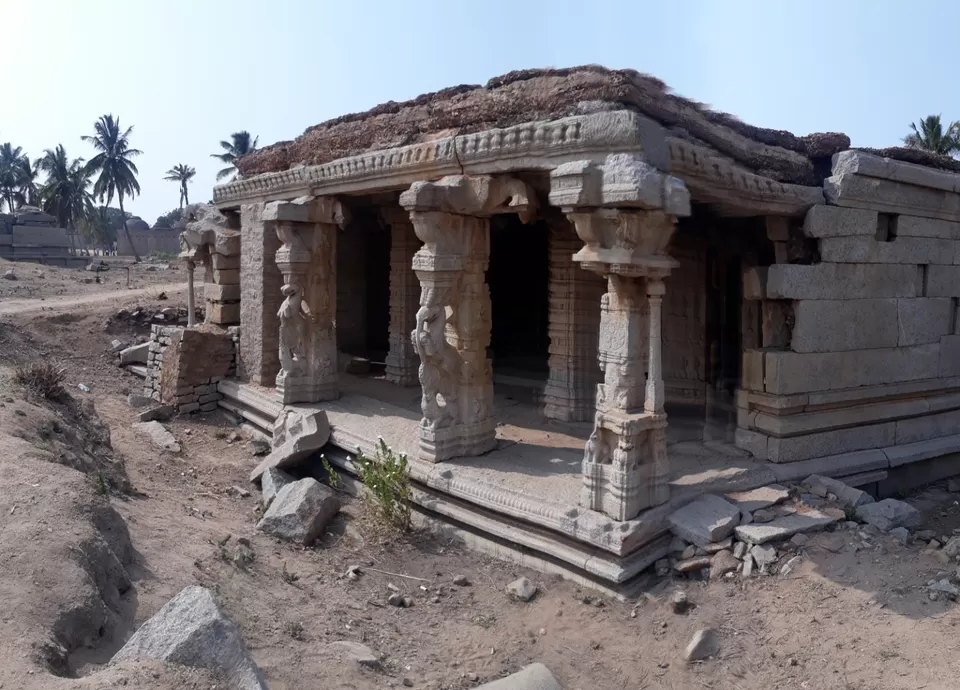
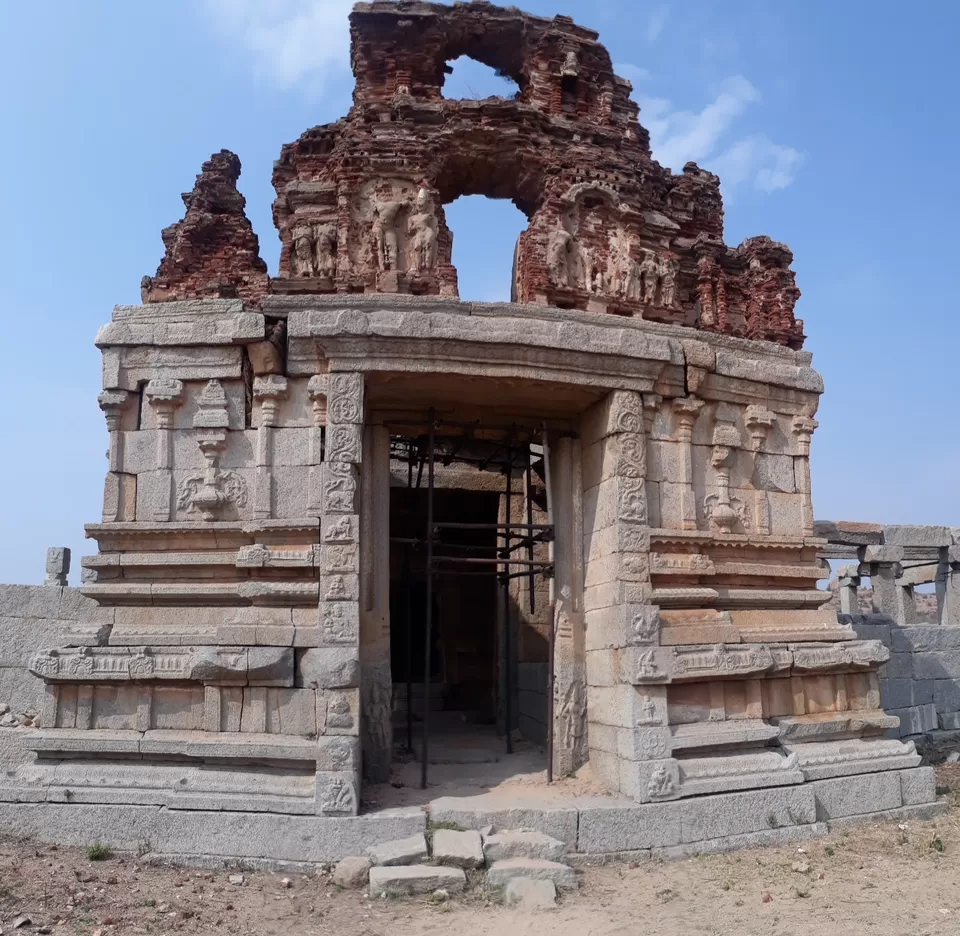
18.ARCHAEOLOGICAL MUSEUM
This is a tiny but worthwhile museum located at Kamalapura. The museum can be visited on the way to the relatively isolated sites (like the Pattabhirama Temple) located towards the southeast end of the Hampi ruins. From Kamapaluram you can walk to the museum by taking the road that goes towards the east.
Apart from the usual suspects in a museum, this one contains an immensely useful exhibit to a novice visitor: A scaled model - in fact two - of the Hampi topography with the monuments located on it. This is an excellent display to get an idea about the area plan and the relative locations of the sites. The large one located at the central courtyard is miniature copy of Hampi as a whole, complete with its hills and rivers. The smaller but more detailed model located inside the last gallery gives you a comprehensive view of the Royal Centre.
The museum has four principal sections. The first one exhibits the Hampi model mentioned above.
The second section is dedicated mainly to the sculptures and idols from the Hampi ruins. A large number of artifacts belong to the Veerabhadra cult and Shiva worship is prominent.
The exhibits in this section include:
Veerabhadra (the demon God created by Lord Shiva),
Bhairava (Shiva in the fearsome posture on hearing the death of his consort, Sati),
Bhikshatana-murthi (depicting Shiva in his ascetic aspect, wandering and begging with a bowl made of human skull),
Mahishasuramardini (the terminator of the buffalo demon; A fearsome aspect of the goddess Shakti ),
Shakti (Shakti is a Goddess represents the power of the God. Always Shakti appears as the consort of the god, For example, Vishnu it's Lakshmi. For Shiva it's Parvati. ),
Kartikeya (the peacock mounted God, created by Shiva out of fire).
Vinayaka (The elephant headed god born to Shiva & Parvati)
The third section displays an array of tools, arms, coinages and other objects that were in use during the Vijayanagara Empire days. The book like documents made of brass and bundled with a ring on display is peculiar.
The fourth one is the oldest of all display objects. An array of antiquities from the prehistoric and proto historic period (the nearby Anegondi is a prehistoric settlement) , hero stones (stone flange dedicated to heroes who died in battle ) and sati stones (Stone flanges in memorial of wives committed suicide after the death of husbands in the battle). Stucco figurines, portions of porcelain pottery from the excavated sites and a gallery of the excavation photographs. The miniature replica of the Royal Centre is impressive with finer details.
The Archeological Survey of India runs the museum. Timings of Visit from 10.00 AM to 5.00 PM. Closed on Fridays and other national holidays. Entrance Fee: Rs. 5/- per head. Children up to 15 years are admitted free. In about 90 minutes you can complete a decent visit. Photography is not allowed inside the galleries. However you can photograph the exhibits on display in the lawn outside.
19.ELEPHANT STABLES
One among the few least destroyed structures in Hampi, Elephant Stable is a major tourist attraction. This long building with a row of domed chambers was used to ‘park’ the royal elephants. There are 11 domed tall chambers; some of them are inter- connected. The center one is specially decorated and big. Probably the musicians and the associated band troupes had been using this during ceremonies involving elephant processions.
The whole building looks symmetric with respect to this central hall. The tower of the central hall resembles (though mostly destroyed) more like that of temples. However the five pairs of domes on either side are of Islamic in style. They are better preserved and of alternating patterns.
Metal hooks (used to tie the elephants) on the inside roof can be seen. At the rear of each hall are small manhole type openings for the mahouts to enter the elephant compartments. You reach here through the Zenana Enclosure. From here you proceed to the Guard’s Quarters and then may be to the Ranga Temple located a bit south of it all.
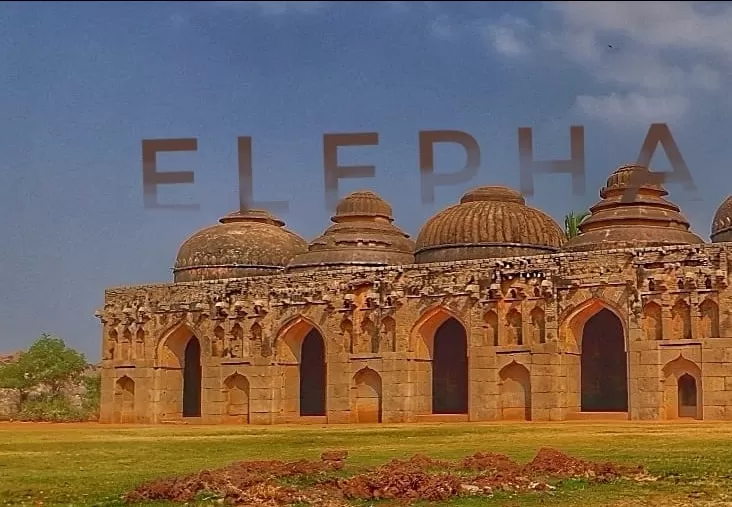
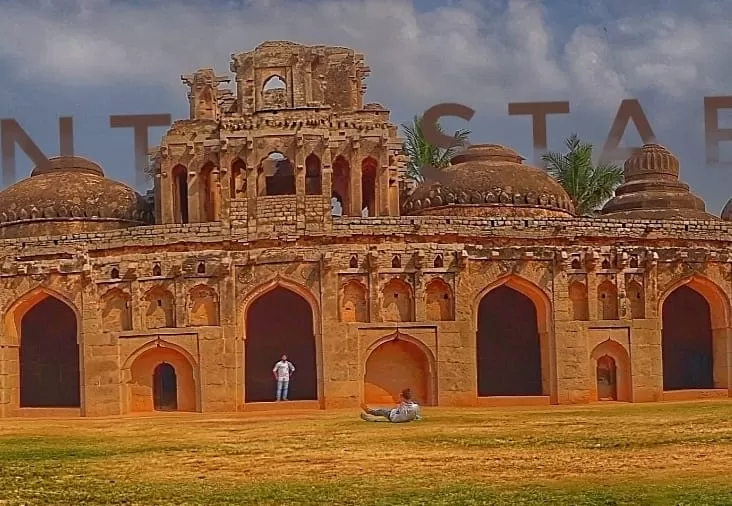
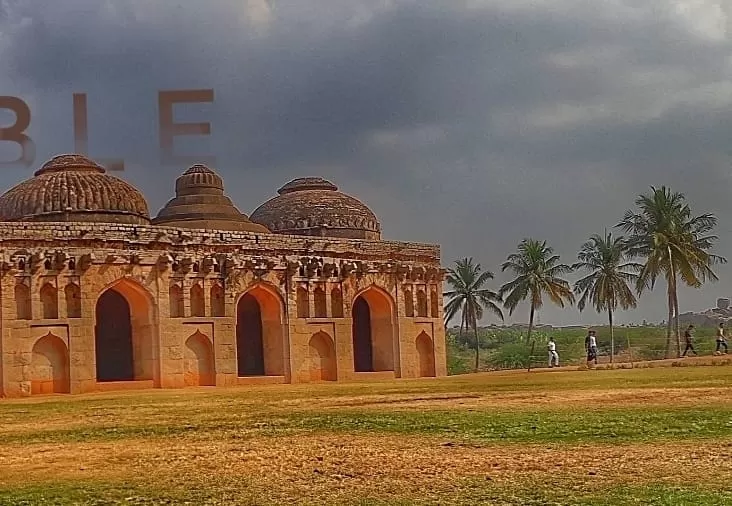
20.ZENANA ENCLOSURE
As the name suggests, you would enter into a sprawling compound with a mud road running through the middle of the compound. Probably the only thing you eyes catch soon when you are inside is the pastel colored Lotus Mahal at the far right corner. It’s a two-storied arched pavilion.
The whole area was the private enclosure for the royal women folks. The Queen’s Palace (visible only the basement) is located at the middle of this area, on the left side of your path. Measuring about 46 x 29 meters, this has been the largest palace base excavated in the Hampi ruins so far. Also the three-tired elaborate base structure speaks of its importance as a palace. The super structure was made of wooden or less durable materials compared to the stone base. Along with the other royal structures, a gut during the rival incursion could have destroyed the palace. A rectangular deep tank (now empty) just at east of this probably used as a water source to the palace.
Opposite to the palace base, across the central path, at the east lie the remains of a water pavilion. This is basically a decorated platform at the center of a shallow pool. This low laying spot is the first you would visit once inside the enclosure.
Three watchtowers can be seen at the corners of the enclosed area. You can spot these two storied towers close to the southeast, northeast and northwest corners. These again were built in the hybrid Indo-Islamic architecture style. Being the ladies quarters, it has been said that eunuch soldiers guarded the area. It’s possible to climb to the top floor of one of these towers (if very crowded, the guards may not allow this). It’s a vantage position to survey this area and the Elephant stables behind the Zenana Enclosure.
It’s Interesting the royal Treasury building too was located in this enclosure. At the northwest corner you can spot an otherwise featureless rectangular building. Some believes that it was the quarters of the eunuch guards protected this area. The structure has a simple entry at the east. A corridor runs all around inside with arches at regular intervals. The absence of windows and light inside makes it believe that this was at the best a kind of store rather than a living space.
There are the traces of a number of unnamed structures and a separation walls inside the campus.
The whole Zenana enclosure is encircled with a tall and broad walls made out of cut stones arranged in interesting patterns. The construction style of the wall is noteworthy.The enclosure had been strategically designed for the women folks to watch the royal ceremonial functions or the march past in privacy.
However there is another school of archeologists who believe this was never used as the women’s area. The archeologists assigned the names (Zenana Enclosure, Lotus Mahal etc) arbitrarily than based on some assumptions. The closeness of the nearby structures (the elephant stables, the guards quarters etc) suggests this was not a harem. They believe the Lotus Mahal as a council room for the chief commanders rather than the women’s pavilion; the rectangular enclosed building at the northwest corner as the armory or mint or treasury rather than the quarters for the eunuch guards; and the palace belonged to the king.
The path to the other locations like the Elephant Stable, Guard’s Quarters and a few other temples’ runs through the center of this area. The whole area is now made into a sort of open garden with sprawling lawns. You can see people take nap under the trees in the noontime. A good site map too is located in this area, if you need to (you will need to!) reassure your location and the next direction.
Reserve about 1 hour plus to roam and explore this area. In all likelihood your next destination would be the Elephant Stables at the east, the Ranga Temple & Yellamma Temple at the south, the Jain Temples or the Hazara Rama Temple at the southwest.
This is one of the few places in Hampi where visitors have to pay for the entry ticket. The ticket counter is located outside (west) the main entrance of the enclosure. Admission fee is Rs 250 (USD5). For Indian citizens the government offers a subsidy on entry ticket and the fee is Rs10. Children under the age of 15 are admitted free.
Photography is allowed free of cost.
The same ticket is valid (only for the same day) for entry at the Vittala Temple and the nearby Elephant Stables. Preserve the ticket.
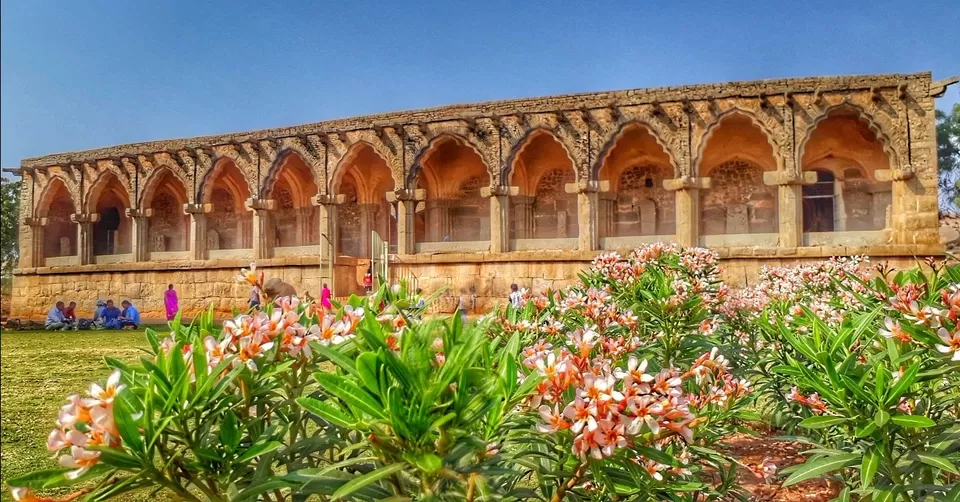
21.TENALI RAMA PAVILION
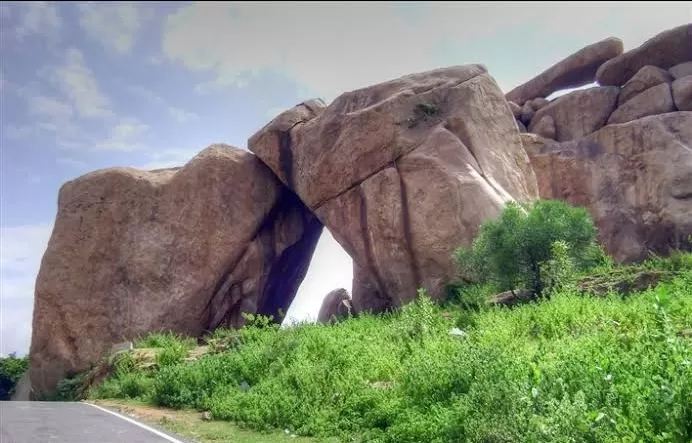
22.SRINAGARADA HEBBAGILU
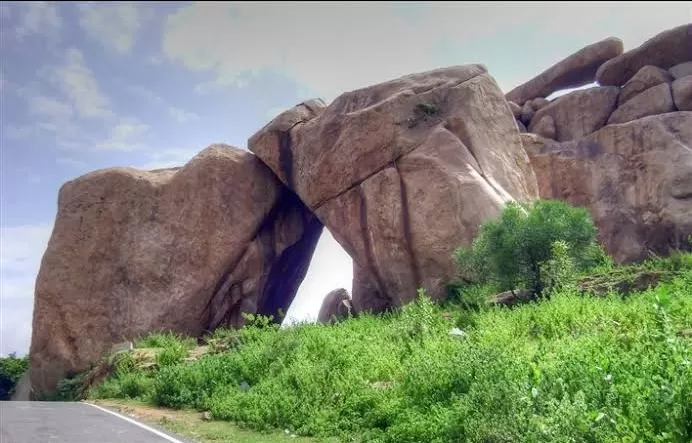
23.parshwanatha temple
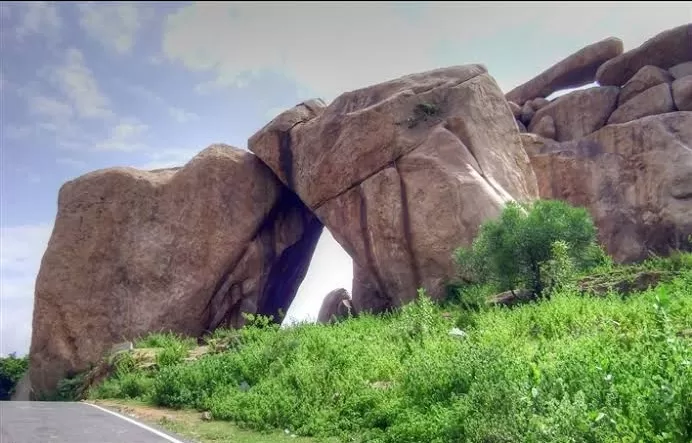
24.ranga temple
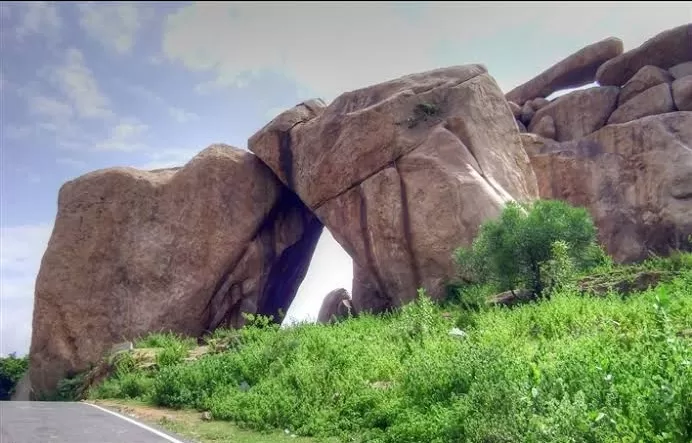
25.yellamma temple
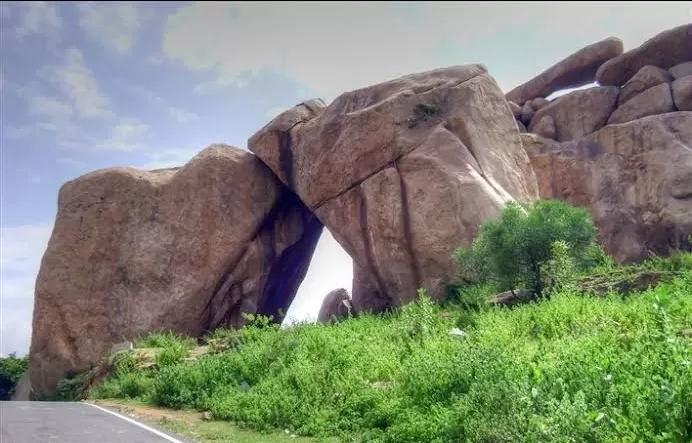
26.pan supari bazaar
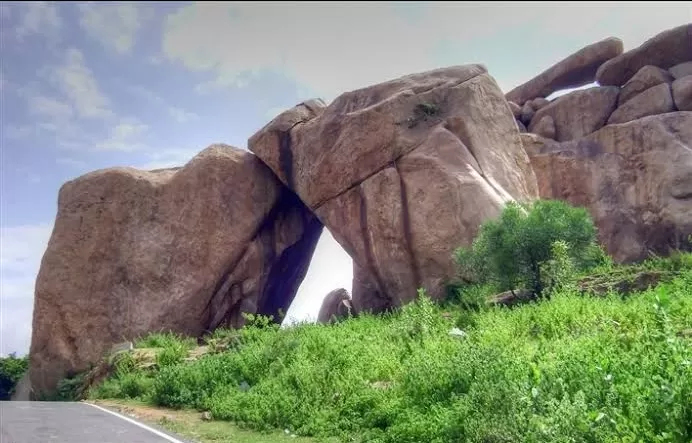
27.large stone trough
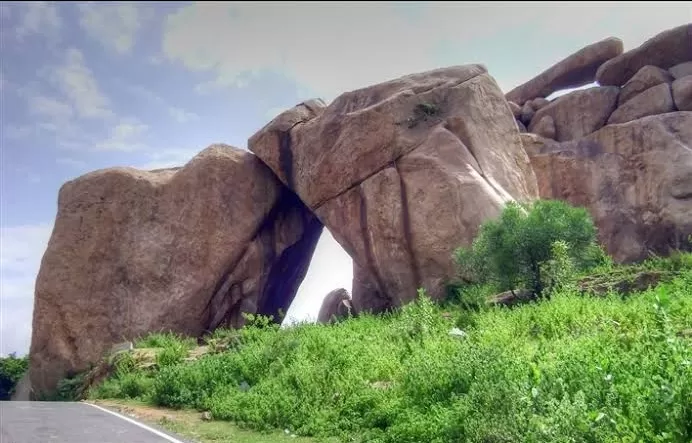
28.kings audience hall
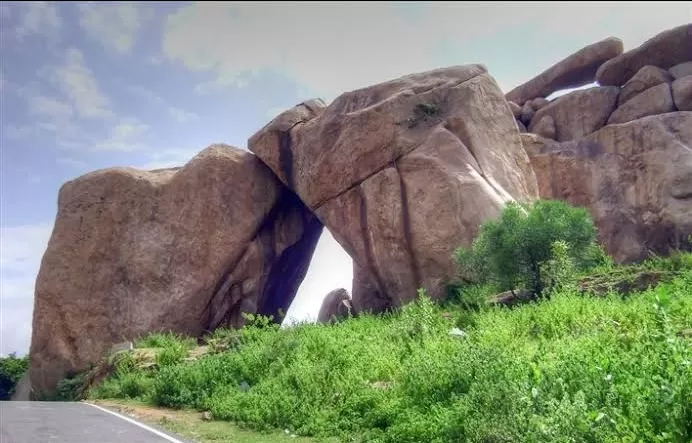
29.mahanavami dibba
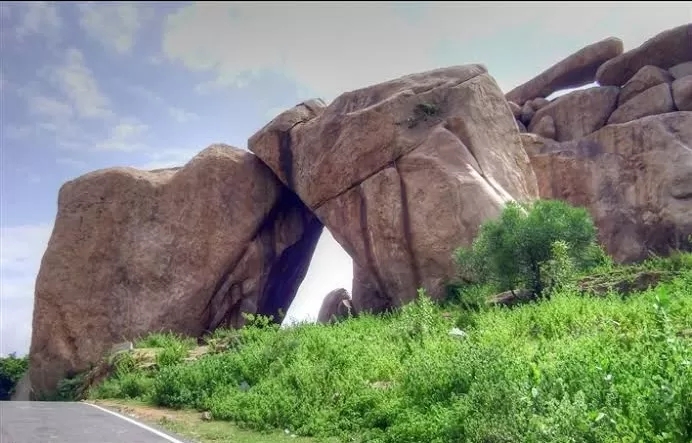
30.stepped tank
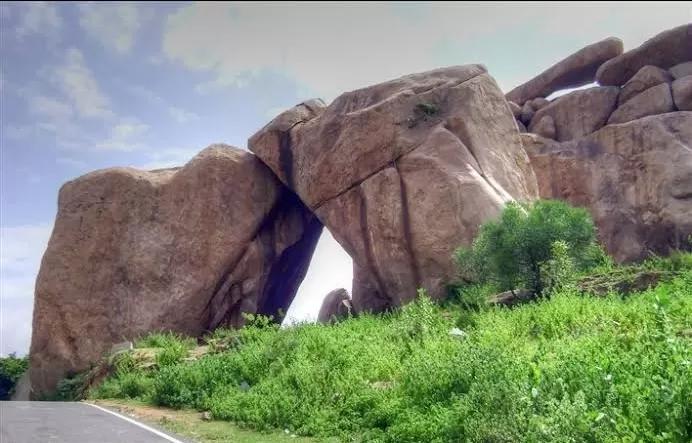
31. Queens bath
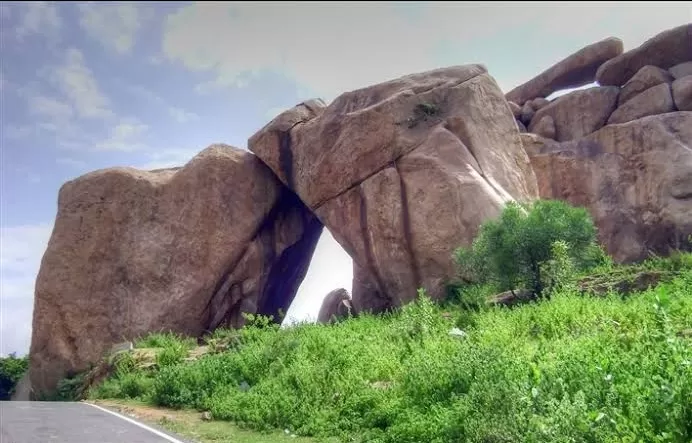
32.chandrashekara temple
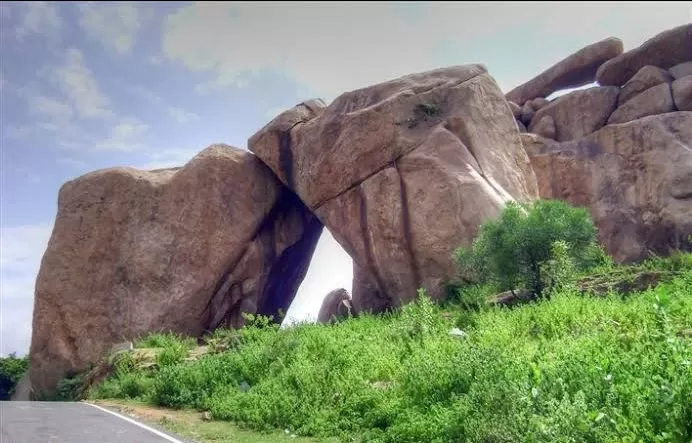
33.saraswathi temple
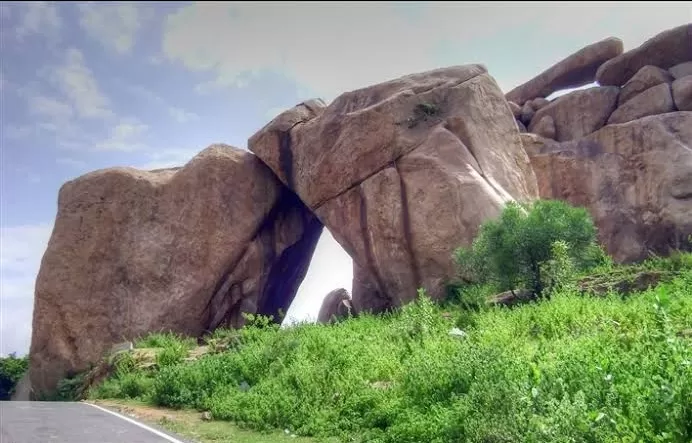
34.octagonal bath
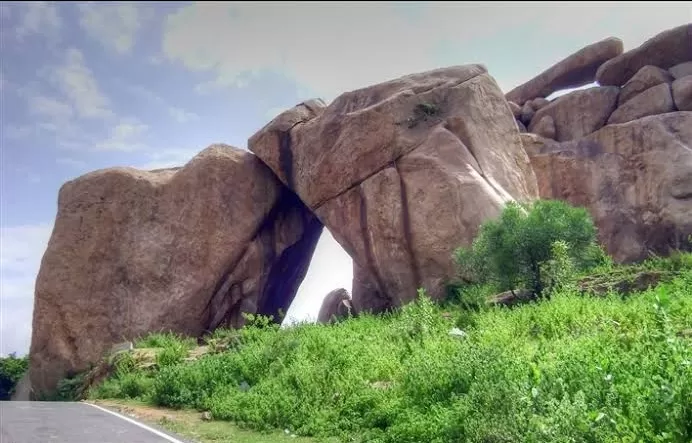
35.bhojanasala
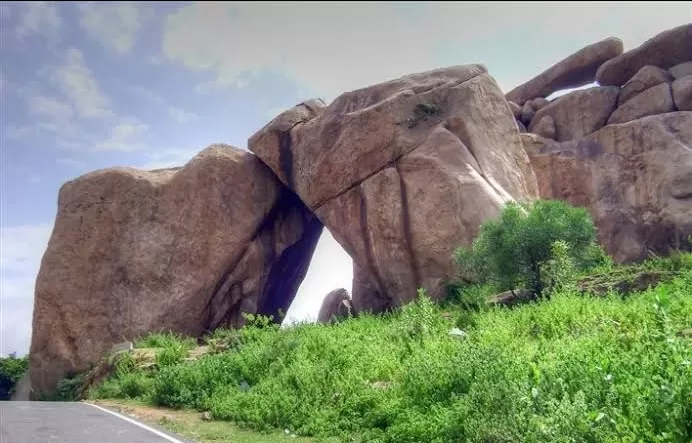
36.octagonal water pavilion
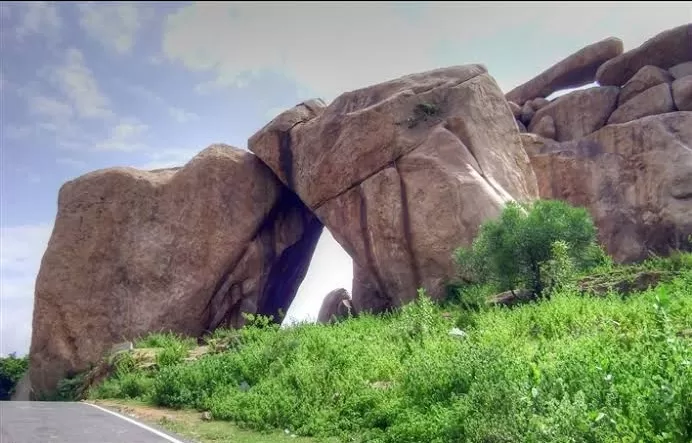
37.archaeological museum
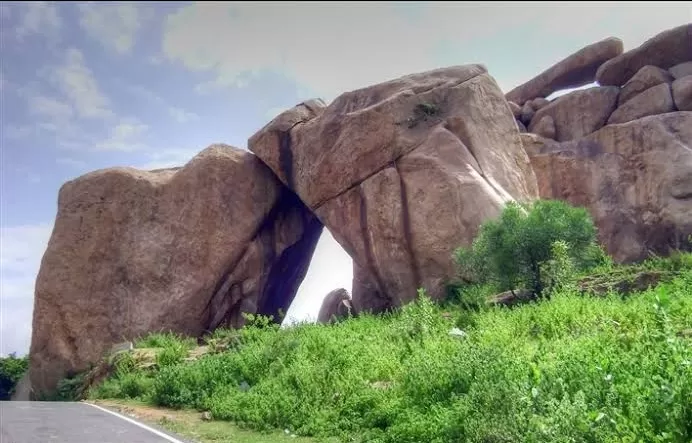
38.pattabhi RAMA TEMPLE
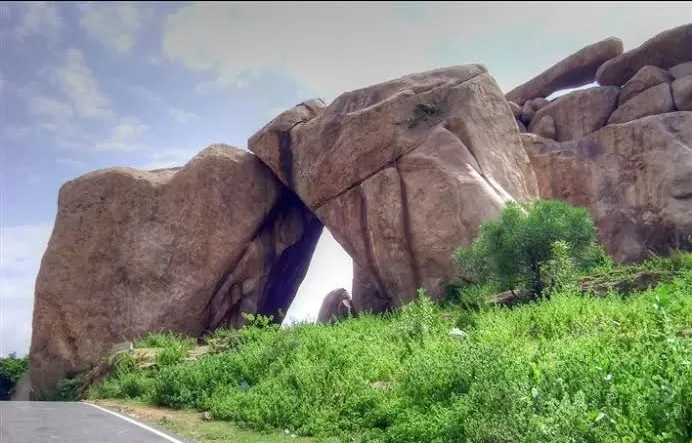
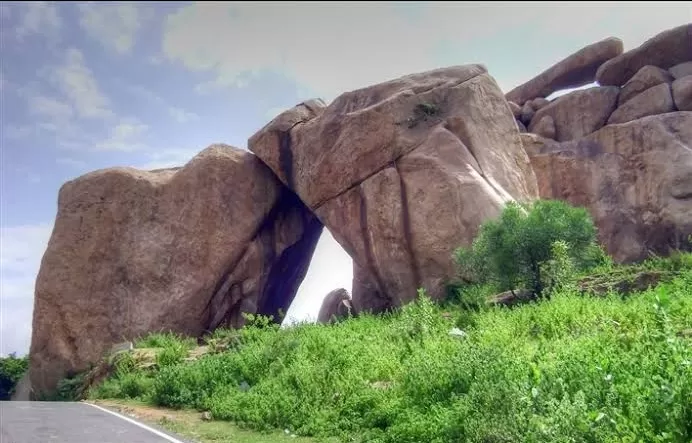
39.doomed gateway
